Paul Finch's Blog, page 10
July 14, 2019
Festival time again: plenty of fun to be had

It’s that time of year again: the lovely month of July, which means that the Theakston’s Crime Writing Festival at Harrogate, the biggest annual event in so many of our professional lives, is just around the corner.
As always, I’m very honoured to be participating in this, especially as, being a new boy in the Orion stable, I’ve actually got a role to play this year in the legendary Orion Incident Room.
For those interested, however, Harrogate isn’t the only place where I’ll be mingling with friends, colleagues and the public in general before the end of this month. I’ll also be making a guest appearance in a ‘Meet the Writer’ event at the Brasshouse pub in Birmingham.
More about both of these events in a little while. In addition today, I’ll also be looking at I AM DEATH, the heavyweight crime thriller from Chris Carter, reviewing and discussing it in my usual forensic detail. If you’re only really interested in the Carter review, that’s no problem. Zoom straight on down to the bottom of today’s blogpost, which is the usual place to find my book chats.
However, if you’re interested in hearing about the other stuff first, then here we go …
Getting out there
First off, Harrogate ...
2019 sees the 16th Theakston’s Crime Writing Festival, which is to be held (as usual) at the Old Swan Hotel, Harrogate, from 18-21 July, in other words this coming weekend.

It’s always a major event in the crime and thriller writing world, not least because of the amazing line-up of special guests who grace it each year. This time, for example, attendees will be rubbing shoulders with the likes of Harlan Coben, Ian Rankin, Belinda Bauer, Eva Dolan, Jo Nesbo, Val McDermid, Stuart Macbride, Jeffery Deaver, James Patterson and Jed Mercurio (among many others).
I’ll be going, as always, but this year, as I say, I’ll have a role to play in the Orion Incident Room, which will be located in the Swan Hotel’s Library Room. There are all kinds of events taking place there during Friday July 19, but for my own part it’s a case of ‘Justice a Minute’, a panel quiz show and our own special Harrogate version of Just a Minute, as hosted by Steve Cavanagh, Luca Veste and Craig Sisterton, starring (as well as me) such crime author luminaries as Adrian McKinty, Mason Cross, Stephanie Marland, Marnie Riches, Johnny Shaw, Mark Billingham and Val McDermid.
Be there or be fair game for all of us. It kicks off at 9.30am.
If this isn’t enough of a draw for you, the Theakston Crime Festival offers lots of other intriguing bits and bobs, including panels, chats, interviews, book signings and the like. And as I say, there’ll be the usual august company of excellent crime and thriller authors strolling the hotel grounds just waiting for you to doorstop them …
Now, The Brasshouse ...
 This is a really delightful thing that has come completely out of the blue. In short, I’ve been invited as a guest to attend a very famous hostelry, The Brasshouse pub on Broad Street in Birmingham city centre, mid-afternoonish on Sunday July 28, at a special ‘Meet the Author’ event, which this year is part of the Birmingham Jazz Festival (now in its 35th year).
This is a really delightful thing that has come completely out of the blue. In short, I’ve been invited as a guest to attend a very famous hostelry, The Brasshouse pub on Broad Street in Birmingham city centre, mid-afternoonish on Sunday July 28, at a special ‘Meet the Author’ event, which this year is part of the Birmingham Jazz Festival (now in its 35th year).Now, you may wonder what I know about jazz, and let me tell you, it’s little-to-nothing. However, fortunately I won’t be having much to do with the musical aspects of the event (which is a good thing as I can neither sing nor play a single instrument). This ‘Meet the Author’ is a little extra thing, I’ve now learned, which seems to have been arranged specifically for me. The invitation came about because the pub’s proprietors were delighted to see the following small passage appear early on in SHADOWS , my second Lucy Clayburn novel:
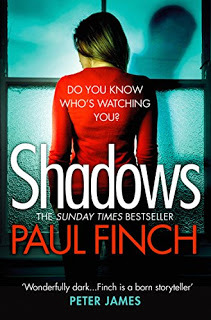 Tonight, oddly, even though the rest of his mates were well-known on campus as big-time boozers, Keith Redmond had somehow found his way to the last port of call alone.
Tonight, oddly, even though the rest of his mates were well-known on campus as big-time boozers, Keith Redmond had somehow found his way to the last port of call alone.
It was called The Brasshouse and it was located on Broad Street, where its reputation as a popular watering hole was very well deserved.
To fill you in, something very nasty happens to Keith Redmond about eight pages after this, but if you want to find out exactly what, you’ll need to buy the book. Suffice to say that it sets in motion a procession of violent and terrifying events.
Thankfully, The Brasshouse itself doesn’t get embroiled in any unpleasantness; it just happens to be the last pub to host Keith, who arrives there at the end of a night out with his rugby mates, before setting off home … and meeting his ghastly fate en route.
Anyway, I’ll be reading a bit from the book and answering some questions (and signing some books if anyone wants me to), at The Brasshouse on July 28. Again, I’m very honoured to have been asked to do this. It was an unexpected and unusual invitation, but hugely flattering, and I can’t wait to take part.
Hopefully, I’ll see some of you there …
THRILLERS, CHILLERS, SHOCKERS AND KILLERS …
An ongoing series of reviews of dark fiction (crime, thriller, horror and sci-fi) – both old and new – that I have recently read and enjoyed. I’ll endeavour to keep the SPOILERS to a minimum; there will certainly be no given-away denouements or exposed twists-in-the-tail, but by the definition of the word ‘review’, I’m going to be talking about these books in more than just thumbnail detail, extolling the aspects that I particularly enjoyed … so I guess if you’d rather not know anything at all about these pieces of work in advance of reading them yourself, then these particular posts will not be your thing.
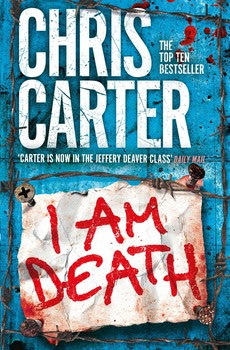 I AM DEATH
I AM DEATH by Chris Carter (2015)
Detectives Robert Hunter and Carlos Garcia are close compadres in the LAPD’s Robbery Homicide Division, specifically the Homicide Special Section, which handles ultra-violent or particularly sadistic murder cases.
In a nutshell, these two have been seeing and dealing for years with the very worst of the worst, so they are well-used to it. Almost nothing has been able to shock them … until now, when a killer, who simply calls himself ‘Death’ begins abducting young women and subjecting them to the most unimaginable suffering before discarding their ravaged corpses. He also writes fiendishly gleeful letters, not just to the cops but to the Mayor’s Office, which inevitably means that this case gets the highest priority possible, and allegedly, or so he says, peppers them with cryptic clues, which the detectives struggle to decipher.
In many ways, it’s the archetypical serial killer scenario, and it comes at us in the way these sorts of tragedies often play out in real life, the killer growing steadily bolder and more brutal and the cops knowing they’ll have to catch the madman quickly, otherwise their department will be embarrassed to the nth degree, a mass panic will manifest, local politicians will run amok, and senior officers take early retirement just to get out of the unflattering limelight.
However, there are certain slight differences here from the blood-soaked norm … just to make things even more difficult for Hunter and Garcia than they already are.
The killer’s MO changes regularly, so no recognisable pattern develops, and he even pays a call on Hunter one very dark night, just to show the detectives that they themselves could be in the firing line if their opponent decides there’s a need for it.
However, Hunter and Garcia are experts in this field and have bags of experience between them. With time-honoured detection methods, they quickly close their target down. Encouraged by the sympathetic and helpful Captain Blake, and when help arrives from Detective Troy Saunders of the Missing Persons Bureau, they finally settle on a viable suspect. Naturally, the guy in the frame has gone to ground beforehand, but they know who he is and it’s only a matter now of locating him and plucking him off the streets, and with every man and woman in the job looking for him, that surely won’t take long.
Except that Hunter starts to wonder if it’s all been a little too easy.
Death is a clever opponent. Would he really let them get this close so soon? There has to be something else, some unseen factor. And if Hunter and Garcia miss it, it’s anyone’s guess what unspeakable acts of horror will follow …
With the exception of one parallel strand, in which we follow the misfortunes of a young loser called Ricky Temple, who is kidnapped on his way home from school, and horribly maltreated by his abductor (who may or may not be Death), who renames him ‘Squirm’ and locks him in a filthy cellar, I Am Death actually reads like the fictionalisation of a real-life murder investigation. Though he spares us any ‘by the numbers’ procedural detail, Chris Carter hits us with what feels like a very real serial killer situation, a typically amoral and narcissistic unsub embarking on a reign of terror by abducting, torturing and slaughtering random young women and then writing gloatingly to the authorities, evidently delighting in the sense of empowerment this gives him.
Yes, all the predatory lunatic boxes are ticked so far.
The same applies to the cops, the obsessive Hunter and the likeable Garcia going about their enquiry in intelligent, workmanlike fashion, uncovering clues, chasing down leads and refusing to be affected by the sensational aspects of the case: there are no over-the-top car chases here, no epic gun battles, and dare I say it – and this hasn’t won the approval of all reviewers, as you can imagine – no female characters shoehorned in as a sop to political correctness. Most of the homicide detectives, with the exception of Captain Blake, are male, while the majority of the women who appear anywhere in the book are victims.
As I say, not every reader has been happy about this, but if you want realism, that’s probably still the way of it in many cases of sexual homicide in the City of Angels.
However, there is one very BIG difference between this book and factual narratives relating real-life murder investigations. And that is the horrific level of violence.
Okay, there’s no doubt that in the real world, some killers will savage their unfortunate victims in similarly ghastly ways to these, but if so, you’re unlikely ever to read the full gory detail when it hits the newspapers. In truth, I’ve never encountered anything quite like I Am Death wherein the torturous deaths of the victims are so intensely and protractedly described. And trust me, they really are harrowing; one poor soul has her face sanded off while she’s still alive (just take a second to think about that!), and the readers are barely spared a moment of it.
That’s not the only sadistic outrage that Carter’s deranged villain perpetrates here. Nearly all the crimes are sickeningly horrible. If you’re able to stomach all that, I Am Death is a very good read, but the violence it’s totally out there … way beyond what you’d expect to find in your average cop novel, and even beyond your average horror novel if I’m honest.
Of course, ultimately this kind of thing is subjective. If you really, really don’t like it, there’s nothing to stop you putting the book down, but someone somewhere in the editorial hierarchy of Chris Carter’s publishers decided that it was essential to the plot, and who am I to argue with that? Carter is known as a US crime author who pulls no punches.
It could be that if you’re really offended by this stuff, you won’t be reading about Robert Hunter in this, his seventh outing, anyway, and so this warning is redundant. On the other hand, if you genuinely don’t mind it – and there are plenty of hardcases out there in Reader Land – you’ll probably find I Am Death a very entertaining police thriller. Though we follow what at times feels almost like a routine investigation from the cops’ POV, it won’t surprise you to learn that it isn’t quite as straightforward as it may appear. Simple answers in a book like this are always going to be deceptive. And if you don’t expect a killer twist at the end – and this novel has one of the biggest of all – you’re possibly reading in the wrong genre.
In short, I Am Death is another big-hitter among adult crime thrillers. A tense and compelling murder enquiry pitting a truly hateful antagonist against two pleasing, everyman heroes, but with mercifully few buddy-buddyisms and zero office politics. Again though, just be warned – when the blood flows in this one, it’s in rivers rather than buckets.
I’m now going to do my usual fantasy casting thing, picking the actors I’d like to see take the lead roles should I Am Death ever hit our screens. Whether the Robert Hunter investigations have ever been considered for TV, I don’t know, but if it does happen, the producers will obviously have to start at the beginning rather than simply charge in at the seventh novel (like I’m doing), so in that regard you’ll have to suspend your disbelief even more than you normally would at this part of the blog.
Detective Robert Hunter – Chris PrattDetective Carlos Garcia – Wagner MouraCaptain Blake – Michelle HurstDetective Troy Saunders – Daniel Day-Lewis (I’m sure we could tempt him out of retirement for one final juicy role)
Published on July 14, 2019 14:17
July 9, 2019
Price slice! Bargain deals on killer thrillers

A ‘get em cheap while you can’ blog this week. Basically, I’m just letting everyone know about some pretty good deals currently available online if you’re interested in acquiring any crime titles from my back-catalogue.
For those not in the know, they are old-school Brit Grit; cops hunting killers in the grimmest of circumstances in all corners of the modern-day UK.
At the same time, while we’re on the subject of Brit Grit, I’ll be reviewing and discussing MW Craven’s amazing novel, THE PUPPET SHOW, which is as British and as gritty as they come. If you’re only here for the Mike Craven review, that’s fine; you’ll find it, as always, at the lower end of today’s blogpost. Feel no shame in speeding on down there straight away.
However, if you’re interested in the other stuff too, then stick around for a few minutes and I’ll fill you in on the details.
Bargains … bargains … bargains …
Both my current cop series, the Mark Heckenburg novels and the Lucy Clayburn novels, are currently benefitting from some competitive pricing on Amazon; at least, the ebooks are.
So, if you want to know what all the fuss is about, and you enjoy reading ebooks, now might be the time to take a chance on them. But a quick round-up first.
MARK HECKENBURG
My Mark Heckenburg books follow the investigations of a detective sergeant in the National Crime Group’s elite Serial Crimes Unit. Heck is specialist homicide investigator with a dogged attitude to work, but he is beset by continuing personal problems. He lives virtually in exile from his family due to his having joined the police shortly after his older brother, Tom, was framed by bent coppers for a series of crimes that he didn’t commit (as a result of which, Tom took his own life while he was in prison). Heck also has a ‘fire and water’ relationship with his departmental boss, Detective Superintendent Gemma Piper, firstly because they don’t see eye-to-eye on procedural matters, but mainly because, earlier in their careers, they were boyfriend and girlfriend. They’ve never shaken off the affection they hold for each other or the sexual chemistry between them, and in the kind of hardcore, front-line police investigations that SCU get involved with, that isn’t a good thing. You can presumably imagine the emotional chaos that result.
I’ll list the books now, in chronological order. As I say, the prices are all very reasonable at present, quite a few of them available in ebook form for only 99p.
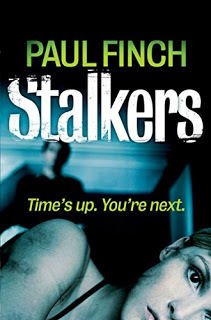 STALKERS
(ebook 99p)
STALKERS
(ebook 99p) DS Mark ‘Heck’ Heckenburg is convinced that a sinister reason lies behind the disappearances of 38 women. Gemma Piper and other supervistory staff are less convinced, arguing that adults are allowed to drop out of sight if they wish to. But there is a common victimology here: all of these women were successful and independent, and distinctly not the sort to simply abandon their families and their careers.
Heck’s persistant enquiry soon leads him into the murky underworld of organised crime. It’s not unfamiliar territory to him, but even Heck is shocked when he hears about a mysterious, semi-mythical syndicate called the Nice Guys’ Club, who serve a purpose that is beyond anything he has ecountered to date …
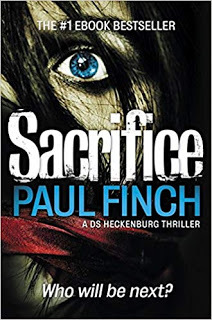 SACRIFICE(ebook £2.99)
SACRIFICE(ebook £2.99)The Serial Crimes Unit is unleashed in full force when a ‘calendar killer’ begins to claim random victims. The so-called Desecrator is the worst kind of predator (or more likely, group of predators). Faceless and nameless and, initially at least, motiveless, he/they prowl the length of the country, abducting targets of convenience and, on special days of the year – Christmas Day, Good Friday, St George’s Day etc – sacrificing them in horrific but apparently meaningless rituals.
Heck is only one part of the team despatched to apprehend the maniacs, but he is the first one to deduce that these slayings, gruesome though they are, are only the build-up to something infinitely more terrible …
 THE KILLING CLUB
THE KILLING CLUB
(ebook £1.99)
Heck is used to attending crime scenes that are bloodbaths, but this new case is something else. Two years ago, dozens of victims were claimed in a series of ghastly abduction murders, massacred by the so-called Nice Guys’ Club, Britain’s most terrifying gang. Now, it seems, the survivors of the gang are back and hellbent on slaughtering anyone they consider a potential danger to their organisation.
The case is thus reopened, and Heck is spoiling to get involved so that he can properly finish the job he started last time. However, for various reasons, Gemma Piper, doesn’t want him anywhere near this enquiry. There is too much bad blood involved, and it has to be dealt with professionally. Heck can’t agree. He is desperate to get to grips with the Nice Guys again, even if it means going AWOL …
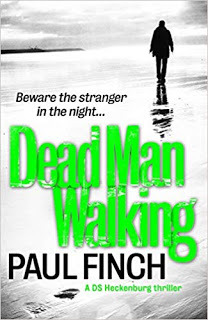 DEAD MAN WALKING
DEAD MAN WALKING
(ebook £1.99)
After a spectacular fall-out with his bosses, in particular Gemma Piper, over their handling of the last case, Heck sought reassignment away from the Serial Crimes Unit, and has been transferred to the Cumbria Police, where he now works as the sole detective in the beautiful but remote Langdale Pikes.
It’s pretty routine work until some teenage hikers go missing, all the evidence pointing to a killer whom UK law enforcement thought dead and buried long ago. The ‘Stranger’ was a whistling madman who used to accost young couples parked up in their cars, raping the women and then killing both them and their lovers. During an undercover sting, Gemma Piper, then a DC, served as an armed decoy and shot and badly wounded the assailant, who was swallowed in a Dartmoor mire as he attempted to flee.
This was years ago of course, and at the other end of the county. Could the killer really have reappeared now, and in the Lake District of all places? Gemma thinks it’s unlikely, but joins Heck in the Langdales to look into the case, just as the thickest, coldest fog of the winter descends.
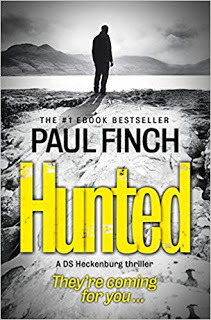 HUNTED
(ebook £1.99)
HUNTED
(ebook £1.99)Readmitted into the Serial Crimes Unit, Heck is despatched to an affluent rural corner of Surrey, where, as a favour to Gemma Piper, he investigates the death of one of her mother’s business colleagues in a bizarre and unlikely accident. However, Heck soon becomes suspicious about the pattern of events surrounding the fatality.
Partnered with spiky local detective, Gail Honeyford, he uncovers a trail of unusual and outlandish fatal accidents that leads all over the south of England: a pair of thieves bitten to death by poisonous spiders, a driver impaled through the chest by a scaffolding tube, etc.
Could a calculating mind be behind these weird events? And if so, why? Surely to God, Heck is not investigating a series of elaborate, life-threatening pranks?
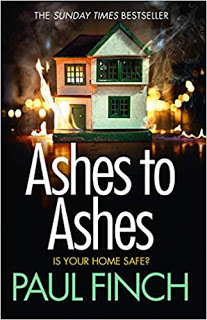 ASHES TO ASHES
(ebook 99p)
ASHES TO ASHES
(ebook 99p)John Sagan is a forgettable man. You could pass him in the street and not realise he’s there. But then, that’s why he’s so dangerous.
A torturer-for-hire, Sagan has terrorised – and mutilated – countless victims. He’s also murdered a police officer. And now, with London too hot for him, he’s on the move. Heck must chase the trail, even when it leads him to his hometown of Bradburn, on the industrial outskirts of Manchester, a place that holds nothing but unhappy memories for him.
But John Sagan isn’t the only problem. Bradburn is currently embroiled in a drugs war, which has unleashed another killer on the community, a maniac who burns his victims to death with a flamethrower. When Heck arrives home, a place he never thought he’d set foot in again, it has quite literally become a fiery hellhole …
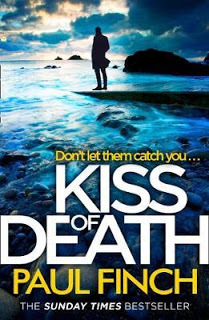 KISS OF DEATH
(ebook 99p)
KISS OF DEATH
(ebook 99p)In a time of swingeing police cuts, Gemma Piper seeks to save her unit by charging them with bringing in 20 of the UK’s most wanted fugitives. Heck and Gail’s target, a notorious bank robber and kidnapper, takes them up to Humberside, but here they uncover a piece of footage which appears to depict their fugitive in a desperate fight for his life.
Heck realises that there’s another player in this game of cat and mouse, and that whoever it is, they’ve not just caught the prize this time, they’ve made sure that no one else ever will.
How far will Heck and his team go to protect some of the UK’s most brutal killers? And what price is he personally willing to pay?
LUCY CLAYBURN
Lucy is a divisional detective constable in the fictional Crowley district of inner Manchester, officially known as November Division. It’s a rough, tough beat, and Lucy, a blue-collar girl through and through, is constantly challenged – but not just by the villains, often by her colleaues as well. Her position is made even more difficult because, though she never knew him during her childhood, she has recently been reintroduced to her estranged biological father, Frank McCracken. He was only a doorman thirty years ago, when Lucy was first conceived, but he’s now advanced through the criminal ranks until he’s becomes a major player in the Crew, one of Northwest England’s premier syndicates. For mutual benefit, both father and daughter keep what they’ve learned about each other secret, but obviously their relationship has changed. Lucy, a good cop at heart, now finds herself walking a tightrope through the world of organised crime.
As with Heck, here is the full series in the correct order, and again, I think you’ll find that they are all pretty reasonably priced.
 STRANGERS
(ebook £1.99)
STRANGERS
(ebook £1.99)Though she’s now been a decade in the police, PC Lucy Clayburn is struggling to make a mark in her job. She dreams of being a detective, but four years earlier, on her first CID assignment, she made a castastrophic error and a fellow officer nearly died.
Now, however, a new chance comes up. An impressive opportunist arrest brings her to the attention of the no-nonsense Detective Superintendent Priya Nehwal, who is covertly investigating the unique case of a female sex predator, possibly a deranged prostitute who has been brutally murdering her male clients. Once the press get hold of the story, they nickname this bizarre killer: ‘Jill the Ripper’.
Lucy joins the investigation team, but in the first instance, must go undercover as working-girl herself, which takes her into a backstreet world of drugs, petty crime and casual sex and violence. It also leads her to SugarBabes, a secret brothel controlled by the Crew, an infamous Manchester firm, where just about anything is available for the right price …
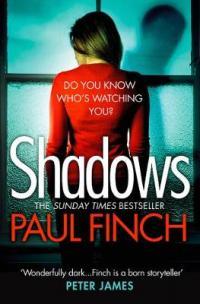 SHADOWS
(ebook £1.99)
SHADOWS
(ebook £1.99)Now re-established as a detective constable but struggling to deal with the private knowledge that her stranged father, Frank McCracken, is a senior lieutenant in the Crew, Lucy Clayburn still leads a difficult day-to-day existence.
However, very unexpectedly, a case then comes along that, for once, might put she and her father on the same side.
A spate of violent robberies, in which the victims are always shot in the legs afterwards, rocks the borough. It’s a complex case to investigate, even more so because those attacked are invariably members of the underworld. However, whether she likes it or not, Lucy now has a good contact in McCracken, and both have a vested interest in stopping this crimewave.
The problem is … they have very different methods.
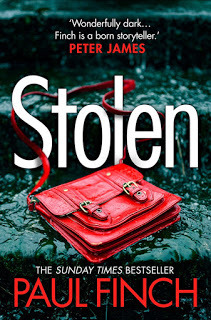 STOLEN
(ebook 99p)
STOLEN
(ebook 99p)No one in the higher echelons of Crowley CID believes in the existence of the so-called ‘black van’. Initially held to be an urban myth, the van has supposedly been seen prowling by night across various housing estates in Crowley, and always at a time when local pets have been abducted.
Even if this thing is real, the disappearances of cats and dogs is hardly a major issue for the police. When Lucy Clayburn, acting on a tip-off, cracks a local dog-fighting ring, she thinks she has solved the mystery. However, even on arresting the miscreants and searching their property, there is no sign of the black van or any of the pets reported missing.
Maybe this mysterious vehicle is nothing but a legend after all?
But then there are more abductions. And this time it isn’t animals. This time it is people, firstly the homeless, then OAPs, and finally – after all, the nameless abductors have now got in much valuable practise – the young and able-bodied. And each time, Lucy learns, a strange van has been seen in the vicinity.
THRILLERS, CHILLERS, SHOCKERS AND KILLERS …
An ongoing series of reviews of dark fiction (crime, thriller, horror and sci-fi) – both old and new – that I have recently read and enjoyed. I’ll endeavour to keep the SPOILERS to a minimum; there will certainly be no given-away denouements or exposed twists-in-the-tail, but by the definition of the word ‘review’, I’m going to be talking about these books in more than just thumbnail detail, extolling the aspects that I particularly liked … so I guess if you’d rather not know anything at all about these pieces of work in advance of reading them yourself, then these particular posts will not be your thing.
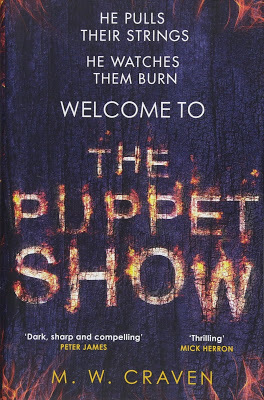 THE PUPPET SHOW
THE PUPPET SHOW by MW Craven (2018)
England’s beautiful Lake District is not the sort of place where you’d expect a serial killer to start claiming victims. But when it does, given the small local police force and restricted road infrastructure in such a wild and mountainous part of the country, it’s a real nightmare.
The Immolation Man, as he has soon been dubbed, has embarked on a reign of terror, during which he kidnaps seemingly random victims (though all of them are older men), holds them prisoner for weeks in some out-of-reach place, and then brings them to their chosen place of execution – each time a different circle of standing stones on Cumbria’s wind-scoured hills – where he douses them with a cocktail of highly flammable chemicals, and burns them alive.
The last person who ever thought he’d be asked to participate in the resulting enquiry is Lake District native and ex-Black Watch squaddie, Washington Poe, even though he is currently living in embittered, self-imposed exile in a rundown farm on Shap, one of the higher, more remote Cumbrian fells. Until recently, Poe was a detective inspector in Scotland Yard’s National Crime Agency, and a highly regarded investigator whose rough and ready methods have often been overlooked because he gets results. However, even Poe can go too far sometimes, and he is currently suspended and basically disgraced after acting on principle in a previous investigation rather than following procedure, the pending outcome of which may see him discharged from the police force altogether.
Poe, furious with all his former colleagues, probably wouldn’t assist in the enquiry even if he was asked, but then the NCA’s Detective Insepctor Stephanie Flynn turns up and advises him that yet another victim has been found, and even though, like all the rest, this one is middle-aged and male, there is a big difference this time as a name was branded into his chest before he was burned – and that name is ‘Washington Poe’.
Realising he has no option but to get involved, Poe accepts reinstatement into the NCA (even though not all of its top brass approve), and even takes a demotion in rank from DI to DS (though this latter is because Poe rarely works within the normal structures of high-level police investigations anyway, usually preferring to develop his own leads and run them down under his own steam).
Straight away, however, he finds himself up to his neck in unforseen complexity. To start with, this is no ordinary serial murder case. There is more than just cruelty and sadism on show; ritual elements are in evidence too, while the offender is highly organised and efficient. Given that the most recent victim was a local councillor, Michael James, there may even be a political dimension. It’s therefore quite a relief when he is partnered with NCA civilian intelligence analyst, Tilly Bradshaw, an expert computer programmer and online researcher, though whatever she possesses in intellect is balanced out by her astonishing naivety and distinct lack of people skills. In short, Bradshaw is something of an oddball and, as such, is shunned and/or mocked by her civie colleagues while other police officers, even the kinder ones, would rather not work with her.
However, thrown together in this whether they like it or not, and both of them outsiders to a greater or lesser extent, Poe and Bradshaw find that they are natural allies, and, mainly thanks to Poe’s perceptive approach when it comes to dealing with his curious new partner, they quickly form an effective if somewhat eccentric working relationship. And this, of course, can only be a good thing, because the Immolation Man is clearly not going to stop killing.
Needless to say, the deeper the twosome dig into the case, the more horrible revelations they uncover, the more extensive the apparent conspiracy at the root of it, and the closer and closer to home the enquiry seems to bring them …
There are three main things that I really liked about The Puppet Show , I mean apart from it being an intriguing, suspenseful and excellently written thriller.
First of all, its setting is marvellously realised. Bleak, rugged locations are not uncommon in crime fiction, especially since the arrival of the Nordic Noir subgenre, but the Lake District, while rugged, is not bleak. It’s astonishing in its Alpine grandeur, its pristine lakes, its enormous skies and awesome weather (sun, snow or rain, you know when you’re in the Lakes). In addition, it’s atmospheric in its ancientness (megaliths, stone circles and prehistoric tumuli are only part of the story), and also in its quaintness; Cumbria’s lakeside towns, in sharp contrast to the fortified farms (a legacy of the reiver clans of old) and tumbledown crofts on its high fells, are ultra civilised, filled with libraries, theatres, art galleries, craft markets, museums, cosy pub/hotels and first-class dining.
And all of this, every aspect of it, is captured in The Puppet Show .
We shouldn’t be too surprised, of course. MW ‘Mike’ Craven hails from that part of the world, and he clearly knows his homeland intricately. And yet, he doesn’t go heavy on all this. The Puppet Show is not a Lake District National Park tour-guide. We do manage to travel all over it during its action-packed 342 pages, but it’s all relevant, and it informs the plot. We’re not just sightseeing here. This is a cop-thriller first and foremost, and yet Lakeland is always there, an extra character, if you like, but an important one too. I can honestly say that I don’t think I’ve read any book that it is as wrapped quite so effectively and at the same time so non-intrusively in its environment.
The second thing I really liked is The Puppet Show’s authenticity.
Mike Craven was a probation officer before he became a full-time author, so you’d expect him to know his stuff. And he really does.
In this novel, though the Lake District is a remote region, modern policing is to the fore. This is the National Crime Agency after all, possibly the most modern outfit, in every sense of the word, in the whole of the British police service. But again, Craven doesn’t overdo this. All the procedures are there, all the latest methods and the brand-new technical back-up are duly referenced, but none of it gets in the way.
In fact, if anything, through the proxy of Washington Poe, Craven vents his frustration at this. Electronic form-filling, divisional protocols, legal minutiae and other types of 21st century officialdom all feel like unnecessary jobsworthisms to Poe, who’s the kind of cop who just wants to get out there and investigate, to use boot-leather and common sense. He particularly despises the kind of bureaucratic red tape that prohibits officers from exercising judgement and discretion.
Yes, it’s all here in The Puppet Show , the complete present-day police experience. On one hand you have the super-efficient, super hi-tech and yet hidebound world of the National Crime Agency, as exemplified by patrician Director Edward van Zyl and even more so by Deputy Director Justin Hanson. And on the other, you have the lone-wolf detective, Poe, who’s not a maverick – he’ll happily play by most of the rules – but who is so eager to get the job done that he’s as frustrated by the etiquette of modern policing as he is by the villains.
I say it again, Mike Craven was a probation officer, not a cop, but he clearly worked with the cops. Because from this debut novel, he knows his stuff inside-out.
And this, I guess, brings us neatly to the characters, which are the third aspect of this novel that I really enjoyed.
There are two main personalities here, Poe and Bradshaw, and what a unique pairing they are.
Indicrectly, we’ve already assessed some of the most appealing aspects of Washington Poe. He’s basically a man’s man, gruff; self-reliant, a little taciturn, but affable too in the right company. A fairly typical male character, I suppose, in the world of cop writing, but that’s only half of the story.
Because while Poe is the primal creature, the elemental force, the instinct-over-analysis, Tilly Bradshaw is the cerebral side of the equation. And together, they make a near-perfect whole.
But Bradshaw has her own personality, too, and it was a fascinating decision by the author to place at the heart of a story like this, which has the potential to be hugely distressing (to the readers, yes, but also to the characters in the tale, particularly those with some political acumen), a character who is introverted and overly sensitive, who is untrusing of others, has very little self-awareness and is even slightly autistic. And she’s not been brought in purely to be a victim. Far from it. I mean, she is victimised on occasion, as anyone in that situation would be in real-life, but Poe, though he at one point strong-arms someone who’s been relentlessly bullying her, does not fall into the role of permanent bodyguard. Bradshaw does not need that. She is incredibly smart, possessing great deductive powers, and is very computer-literate. In the modern age of policing, these are vital assets.
In purely technical terms, of course, this is a clever device by Craven. In future books, I can easily envisage Poe coming to rely heavily on Bradshaw, not just as his quick hook-up to the internet and personal mine of information, but also as his thinker and adviser. But that’s not all it is. The relationship is charming and works very well at a narrative level, the bullish Poe disarmed by Bradshaw’s innocence, the nervous Bradshaw reassured by Poe’s strength and energy. They’re hardly peas in a pod, but such is the skill of the writing that their relationship develops throughout The Puppet Show in a pleasing and completely convincing way.
Overall, this novel is a long way from being your average serial killer thriller. It’s never what it seems, twisting and turning continually, and moving at great pace. And of course, you’ve got that wonderful backdrop too, and that feeling that this is the real deal – that this could happen exactly as Craven relates it Then you’ve got those characters, whom you empathise with from the word ‘go’.
In short, The Puppet Show is a compelling crime novel, very upbeat in its outlook, very modern, and very entertaining. It needs to sit on each and every bookshelf.
And now, as always, in anticipation of its inevitable development for film or TV (the Lake District is begging for its own cop show), I’m going to be a cheeky sod and try to cast the main parts in this beast. You never now, at some point, some producer or casting director may take heed of this column. Anyway, just for laughts, here we go:
DS Washington Poe – Nick BloodTilly Bradshaw – Ella PurnellDI Stephanie Flynn – Joanne FroggattDS Kylian Reid – Harry LloydGamble – Ron DonachieHanson – Adrian RawlinsVan Zyl – Mark GatissBishop Nicolas Oldwinter – Richard Wilson
Hilary Swift - Maria Doyle Kennedy
(The image at the top of the column comes to us from the horror movie, THE HILLS RUN RED, and is unconnected to any of these titles. Sorry about that, but you must admit, it fitted the headline).
Published on July 09, 2019 07:59
May 31, 2019
Back on the chiller trail: more eerie places
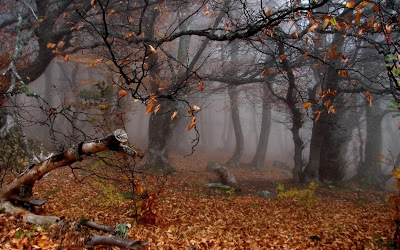
It may seem odd but even though it’s the first week of June, I’ve been thinking autumnal thoughts this week. That’s because I’m going to chat a little bit about an autumn-set novella of mine, SEASON OF MIST, from 2010, which I intend to reissue both in print and ebook form around September / October this year. It’s both a thriller and a horror rolled into one, with strong folkloric elements, with means that talking about it now ties in neatly with another bit of fun I’ve got lined up for today.
I’ve been doing another of those gazetteers of STRANGE AND EERIE PLACES, but this week, instead of the UK and Ireland, which I’ve already done, I’ll be focussing on WESTERN EUROPE.
In addition to those two treats, and because we’re exclusively talking weird, scary mysteries today, I’ll also be reviewing and discussing Simon Stranzas’s intriguingly strange and spooky anthology, AICKMAN’S HEIRS.
If you’re only here for the anthology review, that’s fine. Just pop down to the lower end of today’s blogpost; that’s where all my reviews go. However, if you’ve got a bit more time, perhaps you’ll like to stick around at this end a bit longer. Especially as I’m now about to discuss …
Season of Mist
Back in 2010, I penned a bunch of original horror novellas, which were all published together in one book, WALKERS IN THE DARK, by Ash-Tree Press, and launched at World Horror in Brighton. The book got quite a few good write-ups, but alas, a decade later it’s no longer in print.
 However, one of the stories in there, SEASON OF MIST – which clocked in at 40,000 words – was almost classifiable as a short novel in is own right, and I reckon it’s time it saw the light of day again.
However, one of the stories in there, SEASON OF MIST – which clocked in at 40,000 words – was almost classifiable as a short novel in is own right, and I reckon it’s time it saw the light of day again.Back then in the early 2000s, I was mostly writing horror and science-fiction (mainly Dr Who). I hadn’t at that stage developed a profile as a crime novelist but was increasingly drawing on my police experience to develop thriller concepts. However, when the idea for SEASON OF MIST popped into my head, it allowed me to wear two hats at once, giving me the opportunity to link my long-standing interest in folk-horror with the kind of brutal crime story that is all too real in Britain today and was equally real when I was a youngster in the early 1970s.
One particular memory of that long-ago decade still sticks in my mind: the autumn of 1974, when the preparations for Halloween in my hometown of Wigan, Lancashire, were made particularly scary by a local rumour that a child-killer was on the loose. In reality, there was one murder, and it did occur on a dark October night not too far from our patch. A bunch of teens had been playing hide and seek in the vicinity of a derelict hospital; one of them disappeared during the course of the game and was later found cut to pieces. It’s difficult to trace the details now, but I understand that the murderer was eventually arrested and turned out to be a mentally ill vagrant, who was then locked away in a secure institution.
 Of course, as children, the true facts of the tragedy didn’t trouble us. We were just awe-stricken by the raw horror of it. You see ... we too would shortly be dressed in Halloween garb and running around the darkened streets, woods and derelict mills and coal-tips that dotted our borough (like this one above, thanks to Dave Attrill). And this time, of course, it would be even more frightening than usual because now a real monster was on the loose.
Of course, as children, the true facts of the tragedy didn’t trouble us. We were just awe-stricken by the raw horror of it. You see ... we too would shortly be dressed in Halloween garb and running around the darkened streets, woods and derelict mills and coal-tips that dotted our borough (like this one above, thanks to Dave Attrill). And this time, of course, it would be even more frightening than usual because now a real monster was on the loose.The chilling memory of that long-distant Halloween Night, which was every bit as terrifying as we’d expected it to be, but which thankfully saw no one else actually die, lingered long for me – primarily because as well as being electrifyingly scary it was also hugely enjoyable, the perfect Halloween in fact.
Of course, simply recreating those actual events for SEASON OF MIST would not have been good enough. A much better idea, it seemed to me, was to combine them with an especially uncanny bit of Wigan mythology, as related to me when I was a tiny tot by my coal-miner grandfather.
According to local folklore, Red Clogs was an evil spirit that roamed the colliery wastes of our town, after a terrible underground disaster claimed the life of a collier, taking his feet in the process. In the isolated world of that 1970s industrial heartland, we were all fearfully familiar with this evil and remorseless entity … whose mythical depredations could easily, in the eyes of a bunch of innocent children, have masked the presence of a real serial killer.
SEASON OF MIST was the result. As I say, it’s a 40,000-word novella, which I’ll be looking to republish both in electronic format and in print as the autumn of the year approaches. So, watch this space.
Eerie places
Now, as promised, some other stuff ...
A few months ago, on January 9, I posted a blog – My Own Gazetteer of Strange, Eerie Places. It was a round-up of my top 20 strange and scary places in Britain and Ireland. Places I’d love to visit in my fiction, or, in one or two cases, places that I already had visited.
It proved to be a popular post; it received a lot of hits, and there were lots of positive and interested comments on Facebook and Twitter.
Given that people apparently liked it so much, it seems like an obvious next step to do the same thing again, only now to venture beyond the boundaries of the British Isles, in fact maybe to take this show all over the world, though obviously we can only visit one geographic region at a time.
I thought I’d start the ball rolling this week with Western Europe.
It’s one of the oldest constantly inhabited regions on Earth, it has a long, complex history (much of it blood-soaked), and there is literally a wealth of legend and folklore to get our teeth into. It’s also a corner of the globe where many truly ancient monuments have been lovingly preserved.
I should say straight away that I’ve had to be sensible with the number of places which for these purposes I’ve considered to be part of Western Europe. It could never be as simple as drawing a new line of longitude down the centre of the continent and treating everything to the west of it as fair game. For one thing, it would take forever to research so many potential venues, and for another, even opting only to include the very best, I’d finish up with many more than 20. So, I’m going to be discerning, and, as in the future I intend to write separate blogs about the eeriest, scariest places in Scandinavia, the Mediterranean and so forth, today I’m looking exclusively at Germany, France, Belgium, the Netherlands, Portugal, Switzerland and Austria.
So, without further ado, please enjoy (and feel free to comment on):
GAZETTEER OF STRANGE, EERIE PLACES 2: WESTERN EUROPE
1 Beelitz-Heilstätten

A district of a historic town in Brandenburg, eastern Germany, and home to an infamous abandoned hospital complex, some 60 buildings strong and for the most part accessible, which for years now has enabled members of the public to enter it at will, holding night-time vigils and taking multiple eerie photographs. Despite its exceptionally grim appearance – numerous film companies have shot footage here, making full gruesome use of the endless bleak corridors and rubble-strewn, graffiti-covered treatment rooms – the 100-year-old ruin has no specific reputation for occult or supernatural activity, though like all derelict medical complexes, it possesses a distinct aura of misery and melancholy. If it adds kudos, past patients include arch-villains Adolf Hitler and Erich Honecker. 2 Chateau Champtoce

It isn’t much to look at today – there’s scarcely enough of it left to be haunted – but Chateau Champtoce in Maine, central France, was one of several castles belonging in the early 15th century to legendary warrior, warlock and serial child-murderer, Gilles de Rais. A hero of the Hundred Years War and right-hand man to Joan of Arc, Gilles de Rais later retired to private life, where he is said to have sunk into a quagmire of depravity. At least 80 peasant boys, but maybe as many as 600, are said to have been lured into his various castles, where they were sodomised, sexually tortured and murdered, sometimes amid hellish Satanic rites. De Rais was hanged and burned in 1440, and though debates rage about the extent of his guilt, some claiming that the Church framed him, most historians consider him guilty as charged.
3 Lisbon backstreets
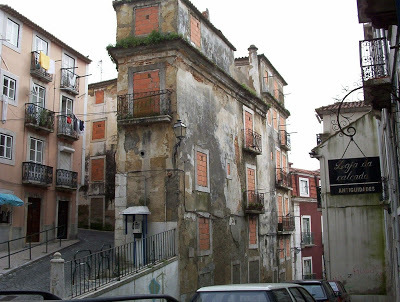
Though Portugal is regarded as a holiday idyll, it suffers severe social problems that most visitors never see. Some 2.6 million of its inhabitants live below the poverty line, and many of its larger cities’ most run-down neighbourhoods consist of slums and shack housing where drugs and crime are rife. One scary myth emerged in Portugal’s capital, Lisbon, several years ago. It concerned an unknown gang who would prowl the most deprived neighbourhoods late at night, leaping on random victims and offering them death, a beating or ‘a clown face’. Most opted for the latter, unaware that it meant the sides of their mouths would be slit, creating horrific Joker-like visages. It’s a very spooky story that has legs even today, even though it was discredited in 2009, when police and health services failed to locate a single record of any such assault victim.
4 IM Cooling Tower

The much-photographed Power Plant IM has been disused since the early days of this century, and though scheduled for demolition and regularly patrolled by security guards, still stands tall in the Belgian town of Charleroi, a dangerous, dystopian edifice beloved by urban adventurers. Originally built in 1921, it was for a brief time the biggest coal-burning plant in Belgium. Incredibly, despite its antique status, it continued to function – albeit with various modern adaptations – right through until 2006, when its excessive C02 emissions led to a protest by Greenpeace and its closure the following year. It presents us with another totemic Western European structure, which though incredibly eerie to look at has no actual history of odd or uncanny events. But check it out. It can’t really be excluded from a list like this, can it?
5 Castle Frankenstein

Yes, this is it, the original one-and-only Castle Frankenstein. It stands in the Odenwald mountain range in western Germany and was the official home of the powerful Frankenstein family from 1250 to 1662. It fell into ruin in the 18th century and remains in that state to this day. The Odenwald are heavily wooded and the centre of many legends, including one tale that a local alchemist, Johann Dippel, who lived in the castle after the Frankensteins had vacated it, dug up a corpse and brought it to life with black magic. Stories that Mary Shelley was inspired by this nightmarish folk-tale are doubted, some scholars claiming that she was never even in the region. That aside, the castle is reputed to be the centre of much paranormal activity and is regularly the site of televised Halloween and Walpurgis ghost-hunting events.
6 Paris Catacombs

All kinds of urban myths surround this infamous network of ancient underground ossuaries. One holds that hidden in its darkness is the entrance to Hell, another that diabolical sects convene here, and yet another that it is filled ghosts who only make themselves known after midnight, attempting to lure lonely explorers into the depths. What is fact is that over 6 million human remains are interred here. If that isn’t unnerving enough, a video camera was once found down here containing footage which indicated that the cameraman, who was never seen again, was being chased by something. Stranger still, on another occasion, a fully-equipped cinema was uncovered by police, complete with working phone-lines and cameras that were filming them; the cinema’s creators were never located, but a note was left, which said: ‘Don’t search!’
7 Chateau Miranda
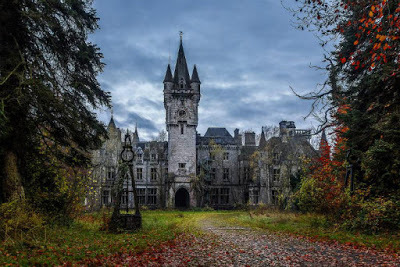
Sadly, it was demolished in 2017, so no one can ever visit this famous neo-Gothic castle in the Namur region of Belgium again, but if wasn’t one of the scariest looking buildings in all of Western Europe, I’d be astonished. Though construction commenced in 1866, it was 1907 before it was completed, and its owners, the aristocratic Liedekerke-De Beaufort family, only occupied it until WWII, at which point it was taken over by German forces. Though it survived that era intact – it even survived the Battle of the Bulge! – the family never returned, and it became an orphanage and hospital before abandonment in 1991, from which point it was the focus of urban explorations and ghost hunts. Unfortunately, amazingly even, it was never known for its supernatural activity, but looking at it today it surely should have been.
8 Fribourg Forest
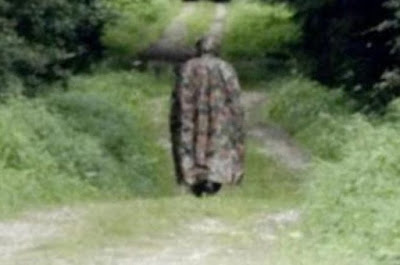
Not many of us would associate Switzerland with scary places given the general magnificence of its Alpine landscape. Most pictures from rural Switzerland strike us with awe rather than fear, but then in 2013 the newspaper, Le Matin , acquired this picture of a mysterious being known as Le Loyon, a weird giant wearing a boiler suit, cloak and gas mask, who for the previous decade had reportedly been seen wandering the paths in Fribourg Forest, in western Switzerland, terrifying all those who encountered him. The story was taken seriously by both local law enforcement and the press, though no assault or threatening behaviour was ever reported. Initial fears that Le Loyon was an alien or some kind of cryptid have now been dismissed as more recent sightings suggest the ‘giant’ is only slightly over 6ft tall.
9 Two horrors for the price of one
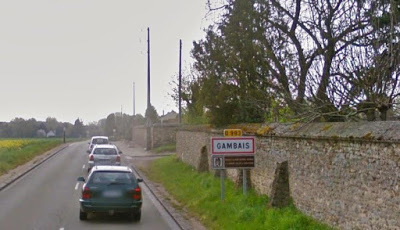

Two streets in the vicinity of Paris. Very pleasant, very unthreatening. Except that both – the main road in Gambais, a rural commune in the Île-de-France (top), and Rue le Sueur, a stone’s throw from Avenue des Champs-Elysées (bottom) – have a chilling past. The former housed Henri Landru, known as ‘Bluebeard’. A ‘lonely hearts’ predator, Landru seduced single women, who he’d lure back to his home, where they’d be killed and dismembered. By 1919, he’d murdered at least 11, though police failed to trace a further 72 that he’d been in correspondence with. In Rue le Sueur meanwhile stood the home of Marcel Petiot, who during WWII tortured and murdered at least 23 desperate folk he’d lured there, having promised them escape from the Occupation (though his real total was more like 60). Both killers died on the guillotine, unrepentant to the last
10 Woods of Eefde
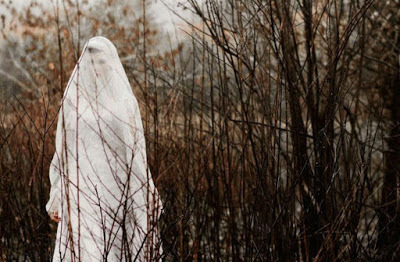
The peaceful woodlands surrounding the village of Eefde in the East Netherlands province of Gelderland are a singularly pleasant place, but are also said to be the haunt of the Witte Wieven, which literally means ‘the white women’. They are the centre of a mysterious rather than frightening Dutch legend, which holds that herbalists, midwives and other valued village wise women would, after death, be buried with full honours and their grave sites venerated afterwards. As such, their spirits would rise and wander the locality, offering assistance and hindrance depending on the worthiness of whichever person came into their path. The belief appears to stem from the Dark Ages, wherein pre-Christian tales of Elves were woven in with Church teachings about the afterlife. Eefde is renowned for its ‘white woman’ activity.
11 Chateau de Raray

Possibly the ultimate fairy tale manor house, Chateau Raray in Picardy (as famously photographed above by Simon Marsden), is an exclusive hotel and golf course these days, so you’re unlikely to turn up there and feel creeped out in any way. But if the current building, which dates back to the early 18th century, doesn’t overwhelm you with its otherworldly atmosphere, then the myriad gardens, arches, shaded walks, and rows of busts and statues surely will. It’s no surprise that in 1946, avant-garde film-maker Jean Cocteau chose it as the location for many of the exteriors in his haunting masterpiece, La Belle et la Bête . That said, it isn’t just an embodiment of magic and mystery. A couple of particularly eerie tales hold that the main building is haunted by the ghost of a servant girl who hanged herself, and the gardens by a statue that moves around at night.
12 Kampehl
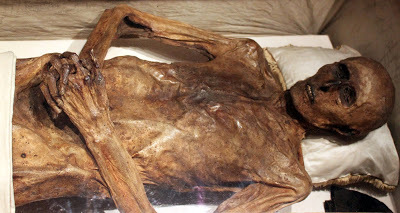
From the sublime now to the grotesque, in a rural church at Kampehl in northeast Germany. Here, you’ll find an open coffin and in it, the mummified corpse of Christian Kahlbutz, an ill-tempered landowner of the 17th century, who, when accused of murder, swore that if he was guilty of the charge, God would never let his corpse rot. He died of natural causes in 1701, but in 1794 workmen re-opened the vault and were stunned to discover the uncorrupted corpse. All kinds of myths are attached to it, including a tale that during Napoleonic times, some French soldiers attempted to crucify it in the village centre, but that it became animated in its outrage, driving them away in terror. During the 20th century, two doctors autopsied the remains, but were unable to explain their non-deterioration.
13 Porte de Martray

The last of the medieval gateways to the city of Loudun in southwest France. Loudun was the scene of extraordinary events in 1634, as made famous by maverick movie-maker, Ken Russell. Though a lurid take on the true events, his controversial 1971 movie, The Devils , was largely accurate in its portrayal of a religious town in the grip of Satanic panic. When members of the local Ursuline convent accused non-celibate priest, Urbain Grandier, of sending demons to sexually torment them, a brutal enquiry followed, resulting in Grandier’s torture and eventual burning at the stake in the town square. Though an impressive document survives, purporting to show Grandier’s written pact with Lucifer, historians blame mass hysteria by the nuns and political contrivance by Grandier’s old foe, the lethal Cardinal Richelieu.
14 Salzburg
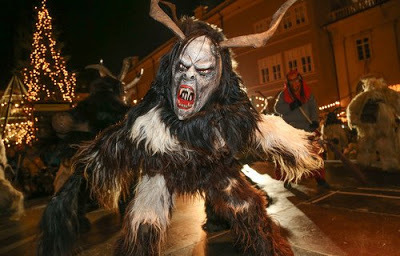
The wonderfully baroque capital of Austria, Salzburg, can boast a plethora of ancient eerie tales, but supernaturalists are best advised to visit it during the Christmas season, when the Krampus and Perchta parades are held. It’s a well-loved costume event, but visitors are often unnerved as the shaggy, horned brutes rampage down the snowy streets, snorting and roaring. Krampus, now familiar to non-Tyrolean audiences via Hollywood, is seen as a kind of anti-Santa, a monstrous being that takes away naughty children rather than rewards those who are nice. Perchta, meanwhile, appears as a half-animal hag, whose purpose is also to terrify and punish those who haven’t performed well during the year. Both are believed descended from winter gods that were worshipped and feared in the mountains during the pre-Christian era. 15 Dadipark
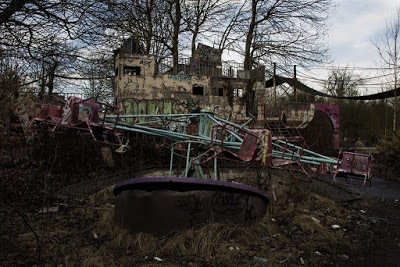
Dadipark is no longer with us, having been demolished in the last couple of years and turned into a green recreational zone, but the one-time amusement park just south of Antwerp, in Belgium, was a derelict, overgrown edifice for the best part of two decades, having been forced to close after an increasingly gruesome series of accidents. Opened in 1950, initially as entertainment for children whose parents had made pilgrimage to the Dadizele basilica, it was one of the first of its kind in Europe, and soon grew into a huge operation, though safety concerns were continually aired as a succession of nasty incidents left visitors injured. When a child lost his arm in 2000, it was the final straw. The park stood empty and decaying for many years, countless ghost stories celebrating its eerie, desolate appearance.
16 Montsegur

The last stronghold of the Albigensians, Montsegur is a mountain-top castle, which like so many of its kind in southern France is remarkably well-preserved (though in truth, it is much rebuilt). Overlooking the beautiful Languedoc, it is riddled with ghostly tales – spectral mists, whispering voices and shadowy figures – most of which allegedly relate to the atrocities of the Albigensian Crusade, which in the 13th century confronted the Albigensian (or Cathar) religion, a radical offshoot of Christianity declared heretical by the papacy. The campaign was earmarked by numerous slaughters, though it ended in 1244, at Montsegur, where the last of the Cathars were holed up. After surrender, all 244 survivors were burned alive in a gigantic bonfire down in the valley. The site is still known as the ‘Field of the Burned’, and on dark nights, distant weeping can allegedly be heard.
17 La Jument lighthouse

Made famous by this incredible photograph taken by Jean Guichard in 1989, the La Jument lighthouse was always considered one of the most dangerous postings in the world. Located off the coast of Brittany, it was an area long notorious for huge seas, roaring waves and catastrophic storms. Before the lighthouse was even built, there were numerous wrecks on the nearby coast. Between 1888 and 1904 alone, 31 ships went down there. These included the 1896 sinking of the SS Drummond Castle, which cost 250 lives. Even after the lighthouse was opened in 1911 (its construction delayed by a procession of incredible storms), there were repeated reports of it being inundated by waves, windows shattering, furniture washed out to sea, keepers only just surviving. It still stands today but is now fully automated.
18 Palais Garnier

The Palais Garnier opened in 1875 to house the Paris Opera, and still stands today in all its opulent glory. One of the most famous opera houses in the world, the Palais Garnier was named after its architect, Charles Garnier, and was a grandiose structure, both inside and out. However, it was put on the map once and for all by Gaston Leroux’s 1910 novel, The Phantom of the Opera . Everyone knows the famous story, but few know that Leroux based many of its key elements on allegedly true melodramatic tales concerning the Palais Garnier. There is a huge underwater reservoir, though not quite a candlelit lake, while staff often blamed odd accidents on a resident ‘Phantom’. There is even a story that a missing actress’s bones were found locked in a cellar trunk many years after her unexplained disappearance.
19 Moosham Castle

Moosham Castle is a well-preserved medieval fortress in eastern Austria. Privately owned today, though some sections of it are open to the public as art galleries, it is a peaceful, scenic place, and yet its history comprises some of the grimmest events ever put on record. Already the centre of numerous baronial feuds during the Middle Ages, in 1675 the Zaubererjackl witch trials were held there, which eventually saw 139 people, most of them men but many of them children, hanged, burned and strangled. Others were spared death, but branded and mutilated (their hands chopped off). The bloodshed didn’t end there, the castle becoming the centre of a werewolf scare in the early 1800s, when hundreds of animals were found torn and half-eaten in the vicinity. Local peasants claimed the former evil had precipitated the latter.
20 Rennes-le-Chateau
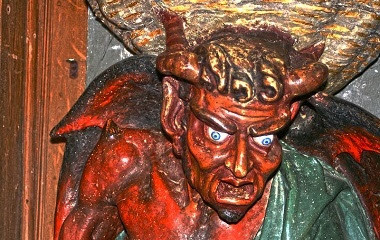
A Pyrennean religious centre, which allegedly sits on a great mystery. The story starts with Bérenger Saunière, a humble priest who in the 1880s occupied this crumbling rural church, and yet went on not only to rebuild it lavishly, but to deck it with bizarre statues, including this chilling image of Asmodeus, and by the 1890s, to have spent over 650,000 francs doing so. Saunière died in 1917, never having disclosed this fortune’s origin. Some believe he practised simony, though there is doubt that the crime of selling Masses could ever have raised such a sum, while others insist that he found the treasure of the Cathars, and others that he had discovered documents proving that Christ’s descendants (yes, you heard that right!) had founded several lines of European kings – if true, you could only guess at the potential pay-off he could have demanded.
THRILLERS, CHILLERS, SHOCKERS AND KILLERS …
An ongoing series of reviews of dark fiction (crime, thriller, horror and sci-fi) – both old and new – that I have recently read and enjoyed. I’ll endeavour to keep the SPOILERS to a minimum; there will certainly be no given-away denouements or exposed twists-in-the-tail, but by the definition of the word ‘review’, I’m going to be talking about these books in more than just thumbnail detail, extolling the aspects that I particularly enjoyed … so I guess if you’d rather not know anything at all about these pieces of work in advance of reading them yourself, then these particular posts will not be your thing.
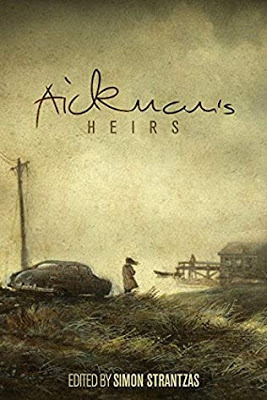 AICKMAN’S HEIRS
AICKMAN’S HEIRS
edited by Simon Strantzas (2015)
An intriguing anthology of weird, open-ended tales, chilling in tone and concept though rarely indulging in blood and gore or utilising standard supernatural tropes, and written in homage to the late, great Robert Aickman, a British author of the 20th century, who specialised in the strange and macabre rather than the out-and-out horrific.
Rather than just tell you everything that happens from one story to the next, I’ll let Undertow provide the intro. Here’s their official blurb, which nicely hints at the enjoyable weirdness to come.
Edited by Simon Strantzas, ‘Aickman’s Heirs’ is an anthology of strange, weird tales by modern visionaries of weird fiction, in the milieu of Robert Aickman, the master of strange and ambiguous stories. Editor and author Strantzas, an important figure in weird fiction, has been hailed as the heir to Aickman’s oeuvre, and is ideally suited to edit this exciting volume. Featuring all-original stories from Brian Evenson, Lisa Tuttle, John Langan, Helen Marshall, Michael Cisco, and others.
Can strangeness in itself be scary? Probably not, though it can certainly be unsettling. And indeed, that was my main reaction to most of the contents of Aickman’s Heirs … a feeling that I was ill-at-ease, that I’d somehow been disturbed without really knowing how or why, and yet at the same time was deeply satisfied.
As that was also my reaction to much of Robert Aickman’s fiction (he wrote 48 short stories in total – many of which have become staples of ‘classic horror’ collections), then I can only conclude that editor, Simon Strantzas, and the numerous writers he has brought together for this book, have hit their main target quite successfully.
We have here an entire range of weirdness, most stories hinting at the grotesque rather than explicitly demonstrating it, and yet, though they rarely hit us with a killer last line or murderous unseen twist, always leaving us deeply discomfited.
Take Brian Evenson’s Seaside Town , in which a mismatched couple visit a French coastal resort where dreariness is the watchword, only for the male of the pair to be inexplicably abandoned by his partner, with no real clue where he is or why. Or Richard Gavin’s Neithernor , which sees a snobbish art critic determined to investigate when he uncovers evidence that his artistic cousin might be a hostage in the grotty little gallery in the next town.
Another key trait of Robert Aickman’s was his relentless merging of the mundane with the bizarre. Very illustrative of this, Ringing the Changes was perhaps one of the great man’s most famous and certainly most oft-reprinted tales, taking another awkward couple to another dull seaside town, this time on the English east coast during the off-season, settling them down in one of the most depressing pubs imaginable, and then filling the air with a clangour of church-bells which literally will not stop until the dead themselves have been wakened. Picking up the torch in Aickman’s Heirs , Nina Allan’s lengthy tale, A Change of Scene , pays direct tribute to the story, in some ways that I won’t mention here as that would be too much of a spoiler, though put it this way, it’s set in the same miserable town (spelled only slightly differently), features another strained couple – two lifelong friends this time, both widowed (again, one of them may have been in the original tale) – and has much to say about the resort’s curious number of church steeples.
Less recognisable, perhaps, but equally disquieting in its clash between the ordinary and the extraordinary is John Howard’s Least Light, Most Night , which sees a reserved, even rather shy office worker reluctantly accept a curious invitation to attend the house of a colleague whom he doesn’t know well for tea and biscuits, at which point he is drawn into a very odd world indeed.
Robert Aickman rarely missed a chance to evoke a dreamlike, often nightmarish atmosphere. And Aickman’s Heirs goes for this too, in a big way.
Take David Nickle’s Camp , which plucks a sophisticated newlywed gay couple out of the city and sends them on a do-it-yourself honeymoon in the Canadian wilderness, where a slow and terrible transformation commences. Or Lynda Rucker’s The Dying Season , wherein another couple trapped in a failing relationship visit a holiday resort so miserably rundown that it scarcely seems possible it could exist in the real world.
With all these stories, of course, and all the others contained herein – there are 15 in total – Aickmanesque ambiguity reigns supreme, solutions often left to the interpretation of the reader. Characterisation typically runs deep (though, at times, is complex – with loneliness and isolation key and repeating themes), while menace arrives subtly, much of the damage self-inflicted, our heroes beset by the results of bad choices and poor personal judgements.
Again like Aickman’s originals, the stories are expertly crafted and exquisitely written. You’d expect that from highly regarded professionals like Lisa Tuttle and John Langan, whose contributions – The Book that Finds You and Underground Economy , respectively, are among the best in the tome. But Camp is a particularly excellent example too, as are The Dying Season , A Change of Scene , and DP Watt’s deceptively gentle A Delicate Craft .
Don’t just take my word for it, though – check it out for yourself.
In fact, in this case you really should, because Aickman’s Heirs , like most of Robert Aickman’s own work, will probably divide horror fans. Those who always need a clear resolution, or who like to be jump-scared out of their skins, and of course those who consider themselves gore or splatter hounds, most likely won’t be enamoured. In many ways, the stories in here are literary shorts at least as much as they are horror – but if you have any interest in the ‘other’, that strange, outré world of speculative writing, where nothing is necessarily what it appears to be, messages are purposely mixed, and much of the quiet terror stems from frailties of the human psyche, then Aickman’s Heirs could definitely be an anthology for you.
And now …
AICKMAN’S HEIRS – the movie
Just a bit of fun, this part. No film-maker has optioned this book yet (as far as I’m aware), but here are my thoughts on how they should proceed, if they do.
Note: these four stories are NOT the ones I necessarily consider to be the best in the book, but these are the four I perceive as most filmic and most right for a compendium horror. Of course, no such horror film can happen without a central thread, and this is where you guys, the audience, come in. Just accept that four strangers have been thrown together in unusual circumstances which require them to relate spooky stories.
 It could be that they’ve all got lost in an underground catacomb and are then confronted by a mysterious monk (a la Tales from the Crypt) or are the subjects of memoirs related by a vampire to a famous horror author in an elusive and Gothic London club (al la The Monster Club) – but basically, it’s up to you.
It could be that they’ve all got lost in an underground catacomb and are then confronted by a mysterious monk (a la Tales from the Crypt) or are the subjects of memoirs related by a vampire to a famous horror author in an elusive and Gothic London club (al la The Monster Club) – but basically, it’s up to you.Without further messing about, here are the stories and the casts I would choose:
The Dying Season (by Lynda E Rucker): A gentle artist and her bullying corporate husband spend an off-season holiday at a drab seaside trailer park, which is almost empty except for the disturbingly strange couple across the way …Silvia – Emma DumontJohn – Toby RegboLynn – Ruth WilsonGabriel – Miles Jupp
Two Brothers (by Malcolm Devlin): When William’s older brother, Stephen, goes to boarding school, the younger sibling is left to his own devices in their big country house. He yearns for his brother’s return, but when Christmas arrives, and Stephen comes home, he has subtly changed …Father – Philip Jackson(Alas, my knowledge of child actors isn’t broad enough to effectively cast either Stephen or William).
A Delicate Craft (by DP Watt): A lonely Polish plumber looking for work in the English East Midlands meets and befriends elderly Agnes, who teaches him the delicate art of lace-making. A rare skill, for which there is a terrible price to pay …Boydan – Antoni PawlickiAgnes – Helen Mirren
Seven Minutes in Heaven (by Nadia Bulkin): A sulky 20-something is fascinated by her hometown of Hartbury’s eerie twin, Manfield, which still stands a few miles down the road despite having been evacuated after a pesticide disaster. In due course, she uncovers a terrifying truth …Amanda – Jessica Henwick
Published on May 31, 2019 01:50
May 16, 2019
The mental aberrations of sociopathic men

Well … it’s publication day for STOLEN, my third Lucy Clayburn novel, so I’m inevitably going to be talking a little bit about that today (but not too much, as I’ve gassed a lot about it recently). But given that there is lots of gangster stuff in STOLEN , including one massive underworld hit (which has certainly got one or two reviewers gossiping), I thought we might also chat a bit about gangland atrocities, and just as an academic exercise, that I’d single out the 10 MOST SHOCKING AND TERRIFYING that I’ve ever come across in real life.
On top of that, because today we’re looking deep into the mental aberrations of evil, sociopathic men, I’ll be reviewing and discussing CAIN’S BLOOD by Geoffrey Girard, which is as grim and disturbing as the modern crime thriller tends to get, but with sci-fi elements interwoven. If you’ve only called in to check out the Geoffrey Girard review, no problemo. You’ll find it at the lower end of today’s blogpost, as always. Feel free to zoom on down there ASAP.
However, if you’re also interested in the other stuff, stick around a little longer, and let’s talk first about …
Lucy Clayburn 3
I’m very happy to see STOLEN , the third novel in my Lucy Clayburn series, published today. This latest installment finds my young police heroine still working cases in Crowley CID, Crowley being the ‘November Division’ of the Greater Manchester Police area (and a rough, tough beat by any standards).
 However, she’s also facing a domestic crisis as her mother, Cora, normally a law-abiding citizen, is increasingly looking back to her wild youth, contemplating a possible reunion with her old flame, and Lucy’s estranged father, gangland boss Frank McCracken. As you can imagine, this isn’t going down too well with Lucy, who, when she first discovered that she and McCracken were related – and it was as much a revelation to him as to her – made a deal with him to keep it secret, because if news like this got out, it could be mutually catastrophic to both their careers.
However, she’s also facing a domestic crisis as her mother, Cora, normally a law-abiding citizen, is increasingly looking back to her wild youth, contemplating a possible reunion with her old flame, and Lucy’s estranged father, gangland boss Frank McCracken. As you can imagine, this isn’t going down too well with Lucy, who, when she first discovered that she and McCracken were related – and it was as much a revelation to him as to her – made a deal with him to keep it secret, because if news like this got out, it could be mutually catastrophic to both their careers. At the same time, there are various heinous things going on in Crowley, which are soon likely to distract Lucy even from this. A number of pets have disappeared in unusual circumstances, and Lucy traces this, or so she thinks, to a dog-fighting ring, only to then learn that she’s off-track – and that now people are disappearing as well.
At first, it’s members of the homeless community, whose absence no one has noticed except Sister Cassiopeia, a drug-addicted former nun, who caters to the Skid Row folk as a kind of self-appointed pastor. Lucy initially takes this story no more seriously than she does the urban myth that a mysterious black van was prowling the housing estates on the nights the pet dogs were abducted … until she learns that this black van is supposedly still on the prowl, and no longer just looking for animals.
Something fiendish is clearly going on. It may be connected to the horrific inner-city wilderness that is the Fairview Landfill site, because weirds things are also supposedly going on out there. But alternatively, it might be linked to the network of disused air-raid tunnels that run underneath Crowley’s many derelict mills. One thing is certain: when an OAP is brutally abducted from his home – and once again there are stories that a van was heard racing away – Lucy has no option but to launch herself into a very complex and distressing investigation.
As I say, STOLEN is out today, from all the usual retailers.
The worst mob hits ever
I saw a rather concerning headline in the news this last week. It read:
Organised crime in the UK is bigger than ever before
The accompanying story described how Britain has now become the hub of numerous international criminal networks, whose various rackets include prostitution, protection, slave-trading, gun and drug smuggling, murder-for-hire and the laundering of billions of pounds through London every year. Other figures, apparently straight from the National Crime Agency, reveal that there are 4,629 active gangs and syndicates in the UK today, which together employ 33,598 full-time professional criminals.
Stats like these will come as a sobering shock to many, particularly to those one or two reviewers of my Lucy Clayburn novels who have expressed doubt that highly-organised and well-resourced criminal cartels like the Crew – my fictional firm who control the North of England – genuinely exist in Britain today.
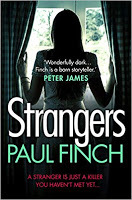 I should say straight away that I’m not quoting these sad figures as some kind of ‘told you so’ point-scoring exercise. I mention them simply to illustrate that the terrifying influence and extreme brutality exercised by the Crew in my three Lucy Clayburn novels to date –
STRANGERS
,
SHADOWS
and
STOLEN
– are not too far removed from reality.
I should say straight away that I’m not quoting these sad figures as some kind of ‘told you so’ point-scoring exercise. I mention them simply to illustrate that the terrifying influence and extreme brutality exercised by the Crew in my three Lucy Clayburn novels to date –
STRANGERS
,
SHADOWS
and
STOLEN
– are not too far removed from reality.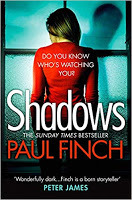 The latest of those three novels, the one published today in fact,
STOLEN
, is particularly worth mentioning in this context because it features what has been described as ‘a horrendous sequence’ in which a major gang hit is carried out with ‘visceral, shocking violence’.
The latest of those three novels, the one published today in fact,
STOLEN
, is particularly worth mentioning in this context because it features what has been described as ‘a horrendous sequence’ in which a major gang hit is carried out with ‘visceral, shocking violence’.As always, I make no apologies for this kind of stuff. Unlike my Heck novels, which generally involve the pursuit of serial killers, my Lucy Clayburn books always have one foot in the realm of organised crime. And I honestly don’t feel that you’re doing anything other than shortchanging your audience if you fail to depict this fearsome hoodlum world in warts and all fashion.
So, yes … there is victimisation and savagery in these books, and the horror and despair of being caught on the wrong side of merciless gangs, and there is also, as I’ve said, that big, gruesome gang-hit which is carried out with extreme prejudice.
Also relevant to this conversation, I think, is the character of Frank McCracken, Lucy’s estranged father, whom she never knew until she was thirty years old and ten years a cop, and who in her absence has risen through the ranks of the Manchester mob until he now has a seat at the top table.
 There are times in the books when Frank comes over as a good guy: affable, approachable, handsome, very urbane. And this is another effort on my part to be authentic. Because all these things are derived from real-life legendary dons who made their bones in the so-called golden age of gangsterism. The likes of Charles ‘Lucky’ Luciano, Meyer Lansky and Benjamin ‘Bugsy’ Siegel (left) were, at first glance, attractive and even charismatic figures. But the comparison doesn’t end there because, like all these infamous real-life villains, Frank McCracken’s seductive appearance conceals a deeply ingrained psychotic nature. He isn’t sweet and kind, he’s treacherous. He isn’t a straight-up businessman, he lies, cheats and breaks every rule in the book. He isn’t just violent, he’s a killer. I should add here that Frank is more progressive than his compatriots in some ways; he doesn’t like killing and doesn’t do it gratuitously. But by the same token, if he deems it necessary, he’ll do it without hesitation. Not only that … he runs an entire subdivision of the Crew, whose most vicious and murderous elements he will happily unleash on anyone and everyone who emerges as a possible threat (whatever their age or gender).
There are times in the books when Frank comes over as a good guy: affable, approachable, handsome, very urbane. And this is another effort on my part to be authentic. Because all these things are derived from real-life legendary dons who made their bones in the so-called golden age of gangsterism. The likes of Charles ‘Lucky’ Luciano, Meyer Lansky and Benjamin ‘Bugsy’ Siegel (left) were, at first glance, attractive and even charismatic figures. But the comparison doesn’t end there because, like all these infamous real-life villains, Frank McCracken’s seductive appearance conceals a deeply ingrained psychotic nature. He isn’t sweet and kind, he’s treacherous. He isn’t a straight-up businessman, he lies, cheats and breaks every rule in the book. He isn’t just violent, he’s a killer. I should add here that Frank is more progressive than his compatriots in some ways; he doesn’t like killing and doesn’t do it gratuitously. But by the same token, if he deems it necessary, he’ll do it without hesitation. Not only that … he runs an entire subdivision of the Crew, whose most vicious and murderous elements he will happily unleash on anyone and everyone who emerges as a possible threat (whatever their age or gender).This is surely the most curious crux of the high-level organised crime phenomenon. Its chief practitioners know what decent society is because they yearn to move in it, they seek its validation, they adopt its trappings. It often seems as if they aspire to be part of it themselves, and yet they are often so inherently indecent that taking that final step is nearly always beyond them. They will never be part of the moneyed but respected establishment they seem to be in awe of, and deep down, I suspect, most of them probably wouldn’t want to be anyway.
Why would they? In the words of Henry Hill, the real-life enforcer at the heart of Nicholas Pileggi’s wonderful script for the Martin Scorsesi 1990 Mafia classic, Goodfellas :
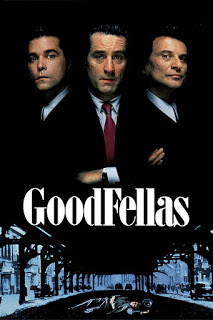 … we were treated like movie stars with muscle. We had it all, just for the asking. Our wives, mothers, kids, everybody rode along. I had paper bags filled with jewelry stashed in the kitchen. I had a sugar bowl full of coke next to the bed. Anything I wanted was a phone call away. Free cars. The keys to a dozen hideout flats all over the city. I'd bet twenty, thirty grand over a weekend and then I'd either blow the winnings in a week or go to the sharks to pay back the bookies. Didn't matter. It didn't mean anything. When I was broke, I would go out and rob some more. We ran everything. We paid off cops. We paid off lawyers. We paid off judges. Everybody had their hands out. Everything was for the taking.
… we were treated like movie stars with muscle. We had it all, just for the asking. Our wives, mothers, kids, everybody rode along. I had paper bags filled with jewelry stashed in the kitchen. I had a sugar bowl full of coke next to the bed. Anything I wanted was a phone call away. Free cars. The keys to a dozen hideout flats all over the city. I'd bet twenty, thirty grand over a weekend and then I'd either blow the winnings in a week or go to the sharks to pay back the bookies. Didn't matter. It didn't mean anything. When I was broke, I would go out and rob some more. We ran everything. We paid off cops. We paid off lawyers. We paid off judges. Everybody had their hands out. Everything was for the taking.And of course, I say it again, anyone who gets in the way is simply rubbed out. By means and methods that are never considered to be too horrific. Which brings us to the main meat of today’s chit-chat.
STOLEN is already drawing attention because of its brutal gangland vengeance scene, and because a leading character in the series, who up until this point the readers might have started liking, thinks nothing of issuing an extreme bloody sanction against a rival faction.
So now, let’s talk about some real ones.
Just for interest’s sake, I thought I’d draw you a list, in no particular order, of the 10 most shocking and terrifying mob hits (and/or hitmen) in the history of organised crime:
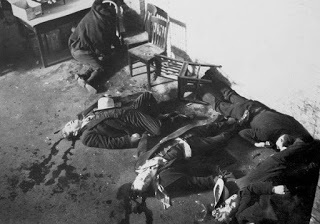 1) St Valentine’s Day Massacre
1) St Valentine’s Day MassacreStill one of the most famous gangland slaughters of all time, the St Valentine’s Day Massacre seems like a relatively small event by modern standards, but it was the culmination of a long and well-publicised underworld war that had terrorised Chicago for much of the Prohibition era, and of course it was ordered by Al Capone (below), who is still regarded today as America’s first celebrity gangster. In short, Capone’s South Side Italian outfit had been in conflict with a gang of Irish hoodlums led by George ‘Bugs’ Moran, whose power base was on the city’s North Side.
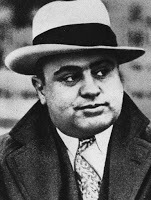 The dispute was originally over turf and booze, but by 1929 there’d been so many murders and assaults and the level of hatred was so intense that no kind of peace treaty was ever possible. On the morning of February 14 that year, five members of the North Side Gang and two associates were hanging out at a Lincoln Park garage, well inside their own territory, when the premises were raided by four cops, who lined them all up against a wall, before mowing them down with Thompson submachine guns. Needless to say, the four ‘cops’ were Capone assassins, two wearing stolen police uniforms, the other two claiming to be plain-clothes. Moran himself wasn’t present but was said to have been so unnerved by the massacre that in due course he got out of Chicago, and to a lesser extent, out of the business.
The dispute was originally over turf and booze, but by 1929 there’d been so many murders and assaults and the level of hatred was so intense that no kind of peace treaty was ever possible. On the morning of February 14 that year, five members of the North Side Gang and two associates were hanging out at a Lincoln Park garage, well inside their own territory, when the premises were raided by four cops, who lined them all up against a wall, before mowing them down with Thompson submachine guns. Needless to say, the four ‘cops’ were Capone assassins, two wearing stolen police uniforms, the other two claiming to be plain-clothes. Moran himself wasn’t present but was said to have been so unnerved by the massacre that in due course he got out of Chicago, and to a lesser extent, out of the business.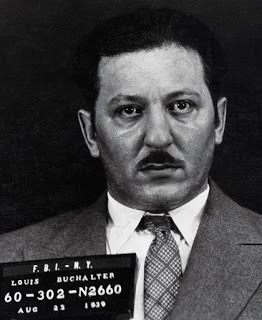 2) Murder, Inc.
2) Murder, Inc.Initially formed as the enforcement arm of the US’s National Crime Syndicate, Murder, Inc (pictured at the top of this column) started life as the blunt instrument by which the will of a merciless higher power was enforced, but in due course rose to prominence as an empowered faction in its own right, before falling from grace with amazing speed. When Lucky Luciano created the Crime Commission, the governing arm of the American Mafia, in 1931, Murder, Inc were to serve as its executioners, the idea being that if they only ever struck on the orders of the overarching committee, there would never be retaliation between the Five Families.
A gang of purposely chosen contract killers, headed up by accomplished hitmen Louis ‘Lepke’ Buchalter (above), Albert ‘the Mad Hatter’ Anastasia and Abraham ‘Kid Twist’ Reles, they slew regularly for the Commission, utilising every weapon imaginable, from guns to knives, neck-wires to ice-picks, baseball bats to broken bottles, but also began accepting contracts from mob bosses in other parts of the country too, breaking their own rule and subsequently claiming maybe 2,000 victims in the next ten years.
 The writing appeared on the wall in 1940 when Kid Twist became a government witness, the first of several. A succession of arrests followed, leading members facing long prison terms or death, Lepke becoming the first major organised crime figure in the US to go to the electric chair. Anastasia saved himself by having Twist murdered but was shot dead himself in 1957 (above), having annoyed key rivals.
The writing appeared on the wall in 1940 when Kid Twist became a government witness, the first of several. A succession of arrests followed, leading members facing long prison terms or death, Lepke becoming the first major organised crime figure in the US to go to the electric chair. Anastasia saved himself by having Twist murdered but was shot dead himself in 1957 (above), having annoyed key rivals. 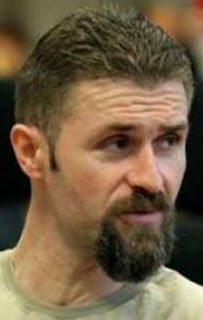 3) Cannibal Stew
3) Cannibal StewOrganised crime had always been prevalent in the former Yugoslavia, with Yugoslav criminals particularly active, in fact prominent in some cases, in Western Europe, though in overall terms it was relatively small-time. The big change came during the 1990s, when the Balkan Wars saw Bosnia, Croatia and Herzegovina devastated, and the international community retaliate against Serbia with severe sanctions, which led to an economic crisis and galvanised thousands of young men, including many ex-soldiers, paramilitaries and other combat veterans to join criminal organisations.
 From this point on, the Serbian Mafia spread its tentacles far and wide, involving itself in drug smuggling, arms trafficking, gambling, protection, kidnapping and armed robbery, all of which necessitated the regular use of extreme violence. However, one of the grisliest episodes in anyone’s criminal history occurred in a Madrid flat in 2009, when two Serbian gangsters from the Zemun Clan, Stretko ‘the Beast’ Kalinic (above, left) and Luka Bojovic, punished light-fingered gunman, Milan Jurisic (above, right), by brutalising him with a hammer, skinning him, filleting him and putting him through a mincing machine, before making him into a stew and eating him. Kalinic was later sentenced to life imprisonment for a whole series of such sadistic murders committed in his capacity as a hitman, mainly on the evidence of informers from inside his own organisation.
From this point on, the Serbian Mafia spread its tentacles far and wide, involving itself in drug smuggling, arms trafficking, gambling, protection, kidnapping and armed robbery, all of which necessitated the regular use of extreme violence. However, one of the grisliest episodes in anyone’s criminal history occurred in a Madrid flat in 2009, when two Serbian gangsters from the Zemun Clan, Stretko ‘the Beast’ Kalinic (above, left) and Luka Bojovic, punished light-fingered gunman, Milan Jurisic (above, right), by brutalising him with a hammer, skinning him, filleting him and putting him through a mincing machine, before making him into a stew and eating him. Kalinic was later sentenced to life imprisonment for a whole series of such sadistic murders committed in his capacity as a hitman, mainly on the evidence of informers from inside his own organisation. 4) The Iceman Cometh
4) The Iceman ComethProbably the most terrifying hitman ever to be associated with the New York Mafia was Richard Kuklinski, the so-called ‘Iceman’ (right). In so many ways, this guy was everyone’s worst nightmare. He stood 6ft5, was built like the Hulk and worked as a freelance mob murderer from 1954 to 1986, in which time he is said to have killed anything from 100 to 250 men, always concealing this horrific truth beneath the respected veneer of a middle-class family man who lived with his wife and children in suburban New Jersey.
Kuklinski was referred to as the Iceman because it was his habit to freeze his victims’ corpses and only dispose of them long after they’d been killed, thus confounding investigators, but his real usefulness to Mafia bosses was how utterly indifferent he was to human suffering. Kuklinski would kill by any means – knife, gun, bomb and so on – but, if the contract required it, he would torture and kill too, on more than one occasion kidnapping his targets, feeding them alive to a horde of voracious rats, and filming it while it happened, an MO which prompted one gangland underboss to comment that he ‘had no soul’. Kuklinski, who was also a racketeer in his own right, was convicted of six murders in 1986, and died in jail in 2006. He confessed while inside but claimed that he’d lost count of his actual tally as he used to practise on the homeless long before he began accepting contracts.
 5) Fatally Chopped
5) Fatally ChoppedIn April 2013, a long and bitter war between the rival halves of an infamous Hong Kong triad society, the Wo Shing Wo, led to an incredibly gruesome and very public murder, in which a notorious local gangster was literally disembowelled alive in front of stunned spectators. Mouse Shing, a 30-year-old underboss of the Wo Shing Wo, was recovering in hospital after receiving leg wounds in an earlier attack. A key figure in the Hau Sai faction, who were attempting to resist infiltration of their territory in Hong Kong’s Sheung Shui district by the infamously violent Yen Chai, Mouse Shing had survived the earlier assault but was till a key target.
He’d no sooner left the hospital, even though impaired by his wounds – he was said to be walking with a cane – when a car sped up, and two assassins leapt out armed with knives, an axe and a meat-cleaver. What was described as a truly horrendous attack followed, the unarmed and undefended Mouse hacked and chopped, his lower abdomen sliced open so that, in the words of appalled pedestrians on the public street, his intestines were literally hanging out. Other deep wounds later found on his arms and limbs suggested that his assailants had also attempted to lop off his limbs. Rushed back into the hospital, Mouse was worked on frantically by the dismayed staff, but he was too grotesquely injured to survive.
6) Crates of heads / Hanging Corpses
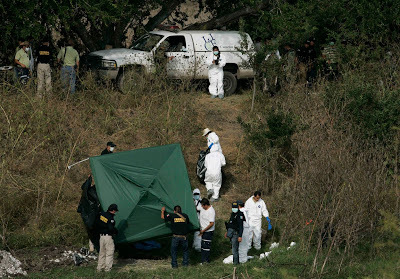
The violence of the Mexican cartels is renowned. The influence they wield is chilling, their appetite for revenge nightmarish. Almost no atrocity is deemed beyond such ruthless, monolithic power-structures as the Gulf Cartel, the Sinaloa Cartel, the Tijuana Cartel, the Juárez Cartel, Los Zetas, La Familia etc. All enforce their authority with extreme terror, and have used their incredible wealth, generated from trafficking coke into the US, to buy off the police, the military, the financial sector, the judiciary, even large sections of the government. As an illustration of the murderous mayhem caused by the Mexican drugs cartels, the so-called Mexican Drug War, which commenced in 2006, has now cost 60,000 lives.
Against a background of such bloodthirsty chaos, to single out any particular hit as an example of rampant criminality would seem ridiculous, but there are examples of incidents that still defy belief. Acapulco, a tourist Mecca of the 1970s and 1980s, became less attractive in 2011, when 15 headless bodies were dumped on the streets, on the apparent orders of the Sinaloa Cartel. The heads themselves were in a nearby crate. If that isn’t enough, in one night the following year, 23 tortured people, including four women, were found either hanging from a public bridge or beheaded and dumped on the street in the border city of Nuevo Laredo, sad relics of the war between the Zetas and the Sinaloans.
7) Kansas City Massacre
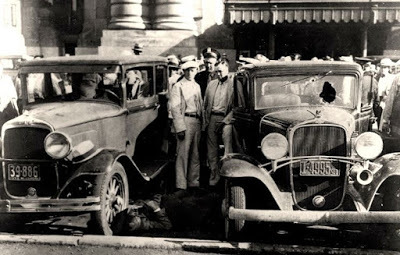
Conspiracy theories abounded in the wake of the terrifying Kansas City Massacre in 1933, and still do today, a range of experts offering different viewpoints regarding the perpetrators and their motives. In short, a small group of cops and FBI agents were in the process of escorting bank robber, Frank ‘Jelly’ Nash back to Leavenworth Prison, from where he’d absconded several years earlier, when, in the car park at the Union Station railway depot, Kansas City, they were ambushed by a posse of gunmen armed with Thompsons. In the following rain of lead, signalled by a cry of ‘Let ‘em have it!’, four law enforcement officials were slain, while Frank Nash died in the car into which he’d just been bundled.
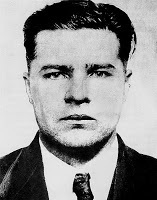
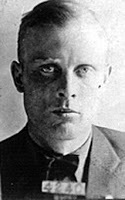 The killers all escaped – at least initially, but what were their motives? Were they trying to free Frank Nash, or silence him? In due course, the FBI named other robbers, Vernon Miller (left), Adam Richetti and Charles ‘Pretty Boy’ Floyd (right), as their chief suspects. This was controversial, many – and not just fellow criminals – claiming that Richetti and Floyd were being framed as it was proving difficult to get them on other charges. Even today, that theory persists with certain crime historians, especially as Miller was later found mutilated in a ditch, a possible mob hit, which suggests the Mafia were involved. Either way, Floyd died in a shootout with cops in 1934, and Richetti was sent to the gas chamber in 1938.
The killers all escaped – at least initially, but what were their motives? Were they trying to free Frank Nash, or silence him? In due course, the FBI named other robbers, Vernon Miller (left), Adam Richetti and Charles ‘Pretty Boy’ Floyd (right), as their chief suspects. This was controversial, many – and not just fellow criminals – claiming that Richetti and Floyd were being framed as it was proving difficult to get them on other charges. Even today, that theory persists with certain crime historians, especially as Miller was later found mutilated in a ditch, a possible mob hit, which suggests the Mafia were involved. Either way, Floyd died in a shootout with cops in 1934, and Richetti was sent to the gas chamber in 1938. 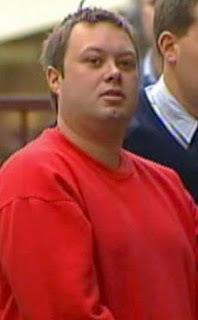 8) Melbourne Killings
8) Melbourne KillingsOne country rarely associated with criminal atrocity, but where there is actually a flourishing organised crime scene is Australia, and in the early 2000s, its southern city, Melbourne, was the venue for a shocking underworld war, a succession of hits and shootouts claiming the lives of 36 prominent figures in the Aussie underworld. It all started when, thanks to the activities of the corrupt Painters and Dockers Union, Melbourne became the country’s capital of amphetamine distribution. Initially, the trade was controlled by one overarching firm, but when its leader, John Higgs, was jailed in 1996, a vacuum formed, and the jockeying for power that resulted transformed into a full-on gangster war, with several factions going at it.
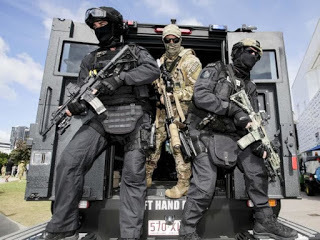 In all ways it resembled the bad old days in Chicago, with car bombs, drive-by shootings, gun-play in bars, restaurants and so forth ... and of course the more who died, the more places were left vacant, which only intensified the competition and the violence. A specialist police unit, the Puruna Taskforce, eventually brought the vying mobs to heel, but not until after a welter of carnage. Most of the murders remain officially unsolved, though a leading figure in the war, Carl Williams (above), was convicted of three (despite police suspecting that he carried out many more). Williams himself was killed in prison in 2010, the last victim of the war, when he was beaten to death with an exercise bike.
In all ways it resembled the bad old days in Chicago, with car bombs, drive-by shootings, gun-play in bars, restaurants and so forth ... and of course the more who died, the more places were left vacant, which only intensified the competition and the violence. A specialist police unit, the Puruna Taskforce, eventually brought the vying mobs to heel, but not until after a welter of carnage. Most of the murders remain officially unsolved, though a leading figure in the war, Carl Williams (above), was convicted of three (despite police suspecting that he carried out many more). Williams himself was killed in prison in 2010, the last victim of the war, when he was beaten to death with an exercise bike.9) Football Face
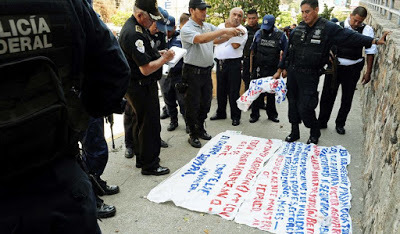
Among the long, lurid list of drug cartel depredations in Mexico, one fairly small but nonetheless truly macabre incident stands out for all kinds of reasons. It happened in January 2010 in Los Mochis, in the northern half of Sinaloa state. It was so shocking, and so utterly mysterious, that even a drug and war-ravaged country like Mexico was rocked by it, especially as it was believed to be aimed at the powerful Juarez drug cartel in an effort to inflict on them the sort of terror they routinely inflicted on others. A certain Hugo Hernandez, who’d been kidnapped from the neighbouring state of Sonora, turned up several days later on an isolated road, headless and dismembered, his constituent parts in various different boxes. More shocking than this, though, a plastic bag was found near to the city hall. It contained a football, on the front of which Hernandez’s sliced-off face had been crudely stitched. A note that was also in the bag, a so-called ‘narcomanta’ read: ‘Happy New Year. Because this will be your last.’ (Check out the above image of Mexican cops examining a less gory manta – aka cartel warning – which was left at the site where five headless corpses had been dumped).
There was no obvious indication why Hernandez was chosen to suffer in this way, though the fact he came from Sonora could be relevant as that state was well known for its extensive marijuana crops. Whether the threat was followed up is unclear, but to date no evidence has come to light to give any obvious indication which cartel was responsible for this mindless act, even though there are plenty to choose from.
 10) Kushchyovskaya Murders
10) Kushchyovskaya MurdersOrganised crime in Russia is a phenomenon of the 21st century, the overwhelming power of the Soviet Union having kept it in check for most of the 20th. Of course, the Russian syndicates are now among the most feared on Earth. But while much modern Russian gangsterism is either concentrated in the major cities or exported abroad, what is less well-known is that smaller, but no less brutal criminal gangs hold sway in rural parts of the vast country. This has partly been blamed on Vladimir Putin’s consolidation of power in the centre, and his neglect of the provinces.
Kushchyovskaya is a tragic witness to this. A prosperous farming community in the Northern Caucasus, it was long under the yoke of a local firm, which, with the collusion of corrupt bureaucrats and police officers, had lived like kings in the district, taking cuts of everything bought or sold, raping, robbing and generally terrorising the population. When, in 2010, an affluent farming family, the Ametovs, finally resisted, they paid a ghastly price.
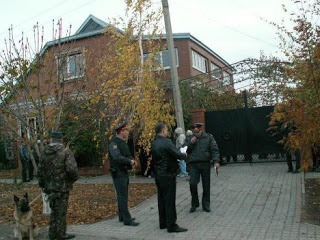 The farm was attacked by intruders that November, the entire family and their guests, 12 people in total (including four children), tied up and stabbed to death. The corpses were then drizzled with petrol and set alight. The crime shocked even a hardened land like Russia, leading to furious demands that Putin get to grips with the crime and corruption problem. In this case, the authorities responded hard (see above). Four perpetors were arrested and imprisoned, three having since committed suicide.
The farm was attacked by intruders that November, the entire family and their guests, 12 people in total (including four children), tied up and stabbed to death. The corpses were then drizzled with petrol and set alight. The crime shocked even a hardened land like Russia, leading to furious demands that Putin get to grips with the crime and corruption problem. In this case, the authorities responded hard (see above). Four perpetors were arrested and imprisoned, three having since committed suicide.THRILLERS, CHILLERS, SHOCKERS AND KILLERS …
An ongoing series of reviews of dark fiction (crime, thriller, horror and sci-fi) – both old and new – that I have recently read and enjoyed. I’ll endeavour to keep the SPOILERS to a minimum; there will certainly be no given-away denouements or exposed twists-in-the-tail, but by the definition of the word ‘review’, I’m going to be talking about these books in more than just thumbnail detail, extolling the aspects that I particularly enjoyed … so I guess if you’d rather not know anything at all about these pieces of work in advance of reading them yourself, then these particular posts will not be your thing.
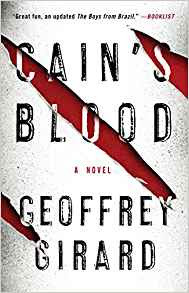 CAIN’S BLOOD
by Geoffrey Girard (2014)
CAIN’S BLOOD
by Geoffrey Girard (2014)DSTI is an ultra-secret biotech division working almost exclusively for the US military, so when things go disastrously wrong there, the problem is kept inhouse, with special operations chief, Colonel Stanforth, sending in one of his best men.
At first, ex-commando Shawn Castillo doesn’t know why he’s been given the job. A combat veteran with much experience in the Middle East (where he was captured by jihadis and viciously tortured), his normal field is counter-insurgency and espionage. On this occasion, as far as he knows, a group of six teenage delinquents being held in an educational facility attached to DSTI have absconded, committing several murders in the process. It sounds more like a job for the police. However, when Castillo arrives, it’s a scene of utter carnage, both institute staff and inmates alike lying slaughtered and dismembered.
But if that’s not enough, an even more terrifying revelation awaits him.
These so-called young offenders are actually cloned replicants of infamous serial killers – the likes of Ted Bundy, John Wayne Gacy, Albert Fish, Henry Lee Lucas et al – who have finally broken loose, and are now on a rampage, seemingly determined to fulfil the legacies of their genetic predecessors.
Prepared to chase and retrieve these burgeoning maniacs, Castillo is nevertheless suspicious of DSTI, unable to believe that any responsible group of scientists would indulge in such experiments. Though the plan was allegedly to isolate the predisposition towards violence in an effort to eliminate it from our world, he knows that the likes of Stanforth wouldn’t be involved if there wasn’t going to be some military application as well.
Feeling that he isn’t learning as much as he can from DSTI’s reticent Dr Erdman, Castillo pursues his own enquiries, forcing entry to the home of senior geneticist, Dr Gregory Jacobson, who has also gone missing, and there uncovering clues that knock him sick. It seems that, under Jacboson’s direction, certain of the clones were being purposely abused and neglected by their foster parents (mostly redneck DSTI stooges) in order to encourage the development of vengeful and sadistic compulsions. At the same time, he locates Jacobson’s own adopted son, Jeff – who it soon turns out is the clone of mass-slayer, Jeffrey Dahmer, but who has been raised in a loving, caring environment, and so appears to be manifesting no violent urges. In his own way, Jeff – a bright, pleasant young guy – is another example of one of Jacobson’s callous experiments; in this case he’s the positive outcome of careful manipulation, though Castillo isn’t sure that he can trust him.
Aware, that Jeff Jacobson will be ‘neutralised’ – either killer or lobotomised – if handed back to DSTI, Castillo opts to take the youngster with him, though he knows that getting emotionally involved in this way is the last thing he should be doing.
Meanwhile, he starts gathering useful intel. Advised by his old army buddy, Ox, who is a mine of information on the US’s numerous secret human-experimentation projects, Castillo begins to suspect that the real purpose of the cloning programme was to breed a race of testtube supersoldiers who will kill mercilessly when instructed to. He also learns that Gregory Jacobson, who appears to have deliberately released this select bunch of ultra-dangerous subjects, is leaning towards insanity himself, having developed a firm conviction that he’s a descendent of Francis Tumblety, a suspect in the original Jack the Ripper enquiry. At the same time, he gets curious about a mysterious place called SharDhara, where something horrible seems to have happened.
Meanwhile, the pack of young killers roams from state to state, commiting a string of ever-more horrendous crimes (explicitly raping, torturing and killing men, women and children alike). At least this enables Castillo to track them, but it also makes things easier for something else on their tail, something infinitely more savage than Castillo, but at least as efficient when it comes to clandestine soldiering. Only when it’s almost too late, does Castillo begin to wonder if the DSTI supersoldier programme was much more advanced than he realised …
The first thing to say about Cain’s Blood is that, as ‘high concept’ goes, it’s up there with the best of them. I personally have no idea whether it’s even remotely possible to distill the evil from a bunch of notorious killers into the specially-grown bodies of a new race of synthetic assassins, but it’s a zinger of an idea for a sci-fi thriller.
Geoff Girard attempts to make it sound feasible by literally burying us under a welter of pseudo-scientific detail, not just catching us with it on the hoof while the story unfolds, but hitting us with the occasional lecture about historic advances in the field of genetics, everything from the Austrian monk, Brother Mendel’s experiments with peas during the 1850s, to the ground-breaking ‘nuclear transfer’ that led to the creation of Dolly the Sheep at Edinburgh Univerity in the mid-1990s. Again, I’ve no idea how credible it all is, but the idea alone is so wonderfully twisted that you can’t help but plunge in.
Of course, even then it requires a conspiracy theorist mentality to fully get on board with it. The character of Ox is a walking, talking device in this regard, a paranoid war veteran, one of whose few purposes in the book is to voice suspicion about the US Government’s role in biological experiments that have caused untold damage to countless test subjects, many of whom weren’t even aware that they were participating. It makes for an astounding read, but whether it’s based on provable truth is another matter. If it was, I’d have thought that Cain’s Blood would have been a far more controversial publication. But again, I reiterate that none of this detracted from my enjoyment. And that’s partly because once we get through that quite considerable wall of shock revelation, we are firmly into pursuit-thriller territory, and we remain there for most of the rest of the novel.
Shawn Castillo is a type of hero very popular with modern American audiences: a former spec-ops guy so badly damaged, both physically and mentally, by the many wars he has recently fought for his country that, while he’s not exactly conscience-stricken, it has left him an out-and-out sceptic regarding his commanding officers, and yet, through his innate loyalty to the US flag, taking on new missions anyway (though you get the feeling early on that this could be the final one – Castillo really is that close to the edge). But in the meantime, he does all the things you’d expect from one of these former ‘shadow company’ types: closing down his targets with effortless ease; keeping his emotions in check but suffering constantly from combat nightmares; playing it cool when some barroom brawler is causing hassle, until he absolutely has no option but to go into action, at which point the baddies get strewn across whichever car park happens to be nearest; and finding it difficult to express his true feelings even to the one female in his life, Doctor Kristin, a beautiful, intelligent, empathetic woman, who is the only thing, until now, that has prevented Castillo from slipping into madness.
So far so familiar, I know … but it’s all done very well. Kristin has been criticised by some reviewers for embodying the sexy mother/wife archetype on whom these damaged heroes so often lean. And she does play that role to an extent, but it’s not by any means certain that she and Castillo are meant for each other. Castillo is only one of a number of traumatised vets she’s managed to bring back to normality – and in that regard, their relationship also serves to examine the immoral complexity of a situation where soldiers are trained and conditioned to go out and kill the enemies of their country (enemies, they personally know nothing about), and then are expected to return to society without any kind of hiccup.
But the character who’s probably got more depth than most of the others put together is young Jeff Jacobson, the genetic offspring of a savage serial killer. You might not have thought there’d be much down for this kid, certainly not when so many other of the ‘prodigals’ have immediately begun replicating the worst atrocities of the originals. And yet Jeff Jacobson has a large role to play in this narrative, because, in the end, it is he who’s the living proof that genetic deviance is not unconquerable. It is young Jeff who serves to illustrate that, for all their research into genes, chromosomes, embryology, X&Y and so on, the ‘playing at God’ scientists of DSTI are taking a blind alley in their efforts to isolate wickedness in the lab – and in fact, in their casual mistreatment of anyone and everyone for the supposed betterment of mankind, are themselves exemplifying a far more insidious form of evil.
Jeff Jacobson comes over as a great kid. It’s a bit mind-boggling for the reader when you consider that he’s the mirror-image of a young Jeffrey Dahmer, but he’s also affable, clever and helpful. Though Castillo is initially wary of him – who wouldn’t be, given his patronage? – the twosome gradually become friends, and in fact go further than that, forming a bond in their efforts to track down their devilish prey. Jeff’s not just the living proof that nurture is more important than nature but ends up providing the heart and soul of this otherwise dark novel.
As a final thought, I’ve now learned that Cain’s Blood was published in tandem with a YA version of these same events: Project Cain , told from the POV of one of the youngsters. That does surprise me, because this is one gory outing. Be advised, there is some seriously cruel and brutal stuff in here, which more than captures the horror of the original crimes committed by the likes of Dahmer, Bundy etc. But if you don’t mind that, then Cain’s Blood is a very satisfying thriller, maybe a little far-fetched, but enjoyable nevertheless.
As always, I’m now going to be bold (stupid) enough to try and cast Cain’s Blood should it ever be adapted for the screen. Just a laugh of course. I doubt anyone who matters would listen to me anyway. But here we go:
Shawn Castillo – Ryan EggoldKristin – Keira KnightleyJeff Jacobson – Garrett RyanGregory Jacobson – David MorseColonel Stanforth – Gerard ButlerOx – Barkhad AbdiErdman – William Sanderson
Published on May 16, 2019 09:20
May 3, 2019
Lucy Clayburn hits the mean streets again

As you can tell, the countdown is well and truly on.
STOLEN, the third book in the Lucy Clayburn series, is taking up much of my bandwidth and much of Avon’s as we fast approach publication date on May 16, and I’m going to be talking a bit more about it this week.
Okay … I’ll come clean and admit it. Much of today’s blog is going to be a blatant trailer for STOLEN. In fact, I’ve even decided to snip out a few choice excerpts and print them on here, so you can judge for yourselves whether it’ll be the book for you.
In addition to that, because I never like to talk purely about myself, I’ll also be reviewing and discussing the late, great William Gay’s marvellous novel, TWILIGHT.
Now, before we go any further, and I can’t stress this firmly enough. It’s not that Twilight , the one about the wistful young lass in love with a vampire. This TWILIGHT is a classic slice of Southern Noir, a grim crime-thriller set in the Tennessee back-country of the 1950s, and it’s got just about everything you’d expect from that genre: grime, poverty, mystery, passion, savage violence, bizarre perversion and even magical realism.
If the TWILIGHT review is the main reason you’re here, you’ll find it, as always, at the lower end of today’s blogpost. Feel free to zoom on down there and get stuck into it straight away. If, on the other hand, you’re keen to know a little more about STOLEN – which I like to think also has a wide range of aspects to it (it’s not just a murder mystery) – then stick around at this end of the blog, and I’ll take you through some of the treats waiting between its covers.
Hardboiled Manchester
I don’t write cosy crime. I don’t do village greens or country house murder mysteries. It’s not that I disrespect those subgenres, it’s just that they’re not for me. My own thrillers are purposely gritty, visceral and urban. I do everything I can, in truth, to tick the ‘hardboiled’ box.
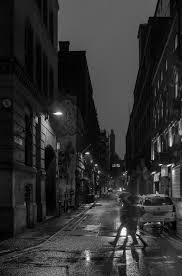 For the uninitiated, ‘hardboiled’ is a subdivision of crime fiction which enmeshes its central character – often a police officer, journalist, or private eye – in the seedy world of inner city organised crime, and is set against a background of vice and corruption. Embittered by their experiences in this terrible time and place, the heroes themselves often become antiheroes who will bend many rules to get a result.
For the uninitiated, ‘hardboiled’ is a subdivision of crime fiction which enmeshes its central character – often a police officer, journalist, or private eye – in the seedy world of inner city organised crime, and is set against a background of vice and corruption. Embittered by their experiences in this terrible time and place, the heroes themselves often become antiheroes who will bend many rules to get a result.Those who read my cop novels will recognise this as home territory from the off, though I think, with the Lucy Clayburn series, we put our own spin on it. Lucy is a female, after all, a young detective constable who works local CID. She has no real power but is increasingly up against it because her home patch of Crowley, aka November Division, is an unruly Manchester borough where poverty, drugs and crime are out of control. She also has one particular problem that would make her unique among police officers in the UK.
 Raised by a single mother, a former stripper now turned respectable citizen, Cora Clayburn, Lucy was only introduced to her father, Frank McCracken, when she was 30 years old and a 10-year police veteran, and was stunned to find out that, though he’d first met and had had a relationship with her mum when he was a doorman at a Manchester nightclub three decades ago, he has now advanced in his career and become a major player in the Crew, the city’s most dangerous crime syndicate.
Raised by a single mother, a former stripper now turned respectable citizen, Cora Clayburn, Lucy was only introduced to her father, Frank McCracken, when she was 30 years old and a 10-year police veteran, and was stunned to find out that, though he’d first met and had had a relationship with her mum when he was a doorman at a Manchester nightclub three decades ago, he has now advanced in his career and become a major player in the Crew, the city’s most dangerous crime syndicate.As such, Lucy finds herself walking an inevitable tightrope between her own world of on-the-hoof law-enforcement and street-policing and her father’s world of violence and racketeering.
 I chose Manchester as the backdrop to this dark melodrama, not just because it was my own patch when I was a serving police officer, but also because it’s the grandest of all those great, bustling, post-industrial northern metropolises. Its centre is the soul of modernity and commerce, though its outer districts (one of which I was born and grew up in) are much less to write home about. The division I myself worked in as a cop, upon which Crowley (which is fictional) is loosely based, could pretty well be summed up as a big, dirty, noisy, chaotic, rain-soaked urban Hell.
I chose Manchester as the backdrop to this dark melodrama, not just because it was my own patch when I was a serving police officer, but also because it’s the grandest of all those great, bustling, post-industrial northern metropolises. Its centre is the soul of modernity and commerce, though its outer districts (one of which I was born and grew up in) are much less to write home about. The division I myself worked in as a cop, upon which Crowley (which is fictional) is loosely based, could pretty well be summed up as a big, dirty, noisy, chaotic, rain-soaked urban Hell. Anyway, that’s the backdrop. Now to
STOLEN
, the third book in the series (though a series, all three of the books – the first two are
STRANGERS
and
SHADOWS
– can comfortably be read as stand-alones).
Anyway, that’s the backdrop. Now to
STOLEN
, the third book in the series (though a series, all three of the books – the first two are
STRANGERS
and
SHADOWS
– can comfortably be read as stand-alones).I’m not going to give you the outline, mainly because I don’t want to drop any spoilers, but also because the pitch is all over the internet now as the book is being advertised widely. However, as promised, I am going to take this opportunity to send a few trailers your way (so to speak):
The first thing you’ll notice in the Lucy Clayburn books, as I’ve been boasting all the way through this post, is the tough, frank cop stuff … ‘I’ve not seen her today,’ Newt said. ‘Not yet. If she’s shooting up, she’ll be in the women’s toilets on that row of boarded-up shops. On the other side of Penrose Mill.’Lucy nodded. ‘I know it.’ ‘But I don’t think she’ll be there. Yesterday, she was saying something about going to services.’‘Services?’‘I don’t know exactly what it means, but . . . she said it once before when she was going to someone’s funeral.’ ‘A funeral?’ ‘I think so.’ He tried to remember more. ‘She said she wouldn’t be around till this evening because this afternoon she was attending services out on Fairview.’
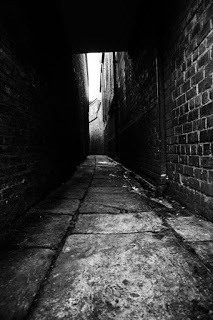 ‘Fairview?’ Lucy was bemused. ‘A funeral . . . on a landfill site?’Newt shrugged again. ‘That’s all I can tell you. I didn’t ask, did I? Told you, she’s a nutcase. Christ knows what she gets up to most of the time.’‘This is all I bloody need.’ Lucy thought about Fairview, that hideous, decayed wilderness, with its foul stenches and its drifting toxic smoke and its gangs of weirdo scavengers scrambling across it like beetles. ‘If this is wind-up, Newt, I’ll make your life a misery from here on. It’ll be stops-and-searches every time I see you. I’ve got good contacts in the Drug Squad, and I’ll make sure you go right to the top of their list.’‘On my honour,’ he protested. ‘She’s taking a few others to attend services on Fairview.’‘On your honour?’ Lucy shook her head. ‘Your honour. Are you serious?’ She grabbed him by the collar, lugged him from the wall and threw him along the passage with such force that he staggered and almost fell. ‘Get out of my sight, soft lad!’He hurried off, walking stiffly without looking back.‘I ever see you again,’ she shouted, ‘I’ll pop those zits with the dirtiest needle I can find!’
‘Fairview?’ Lucy was bemused. ‘A funeral . . . on a landfill site?’Newt shrugged again. ‘That’s all I can tell you. I didn’t ask, did I? Told you, she’s a nutcase. Christ knows what she gets up to most of the time.’‘This is all I bloody need.’ Lucy thought about Fairview, that hideous, decayed wilderness, with its foul stenches and its drifting toxic smoke and its gangs of weirdo scavengers scrambling across it like beetles. ‘If this is wind-up, Newt, I’ll make your life a misery from here on. It’ll be stops-and-searches every time I see you. I’ve got good contacts in the Drug Squad, and I’ll make sure you go right to the top of their list.’‘On my honour,’ he protested. ‘She’s taking a few others to attend services on Fairview.’‘On your honour?’ Lucy shook her head. ‘Your honour. Are you serious?’ She grabbed him by the collar, lugged him from the wall and threw him along the passage with such force that he staggered and almost fell. ‘Get out of my sight, soft lad!’He hurried off, walking stiffly without looking back.‘I ever see you again,’ she shouted, ‘I’ll pop those zits with the dirtiest needle I can find!’We also have a bit of a rep for going all-out on the action front …
Lucy sped on, passing through the narrow doorway and entering a long, concrete passage that had never been intended for vehicles. Again, it was cluttered with debris, as though part of the ceiling had collapsed, which made it difficult going. A dark shape bobbing ahead of her revealed her fleeing prey, but before she could catch up with it, she reached a junction of passages obstructed by a wheeled cart that was loaded with wooden pallets.Lucy braked sharply. She heard feet hammering away ahead as she leaped from her seat to shove it all aside. What this place had once been, she couldn’t fathom. Whatever it was, if the rest of the structure was anything to go by, it was likely to be labyrinthine, which was all she needed when her quarry had a head-start like this.She clambered back onto her bike and accelerated forward at reckless speed. At the next intersection, she had to slow down to listen. Hearing an echoing clatter of rubble on her right, she swung her machine after it, accelerating again. It was the same at the next junction. Even with her headlamp on full beam, she now saw nothing but endless concrete tunnels telescoping ahead, black elongated nightmares along which her Ducati hopped and skipped as it cleared mound after mound of masonry. Some were so narrow that at times her handlebars all but carved their way along the walls and turned the reverberation of her engine into gunfire.
 Lucy swore. She could have overhauled this suspect in any normal circumstances, but it was typical that she’d wound up pursuing in what had to be the only place in Crowley where the speed and power of her Ducati were nullified. At the same time, she found herself having to duck, as missiles came flying back from the fleeing form: bricks, discarded bottles, wooden laths heavy with cement. At least her adrenalin was up, dulling the thudding impacts on her body, the blows of bricks and cans, the crunch of smashing glass on her visor. But Lucy knew that she wasn’t immune to this punishment. If her headlight was taken out, that was it; she’d be marooned in this unlit maze, at the mercy of whoever this maniac was …
Lucy swore. She could have overhauled this suspect in any normal circumstances, but it was typical that she’d wound up pursuing in what had to be the only place in Crowley where the speed and power of her Ducati were nullified. At the same time, she found herself having to duck, as missiles came flying back from the fleeing form: bricks, discarded bottles, wooden laths heavy with cement. At least her adrenalin was up, dulling the thudding impacts on her body, the blows of bricks and cans, the crunch of smashing glass on her visor. But Lucy knew that she wasn’t immune to this punishment. If her headlight was taken out, that was it; she’d be marooned in this unlit maze, at the mercy of whoever this maniac was …I’ll also admit that I have a penchant for colourful and generally irredeemable villains:
‘Why are you telling me all this?’ Lucy asked as she covertly tested her bonds.
Torgau pondered. ‘It’s a good question, DC Clayburn. Most of my life, I’ve flown under the police radar. You can call it skill, you can call it luck, you can call it the Devil looking after his own. But after a lifetime dedicated to breaking the law – I mean, I’ve barely ever done an honest job and look at the life I lead – I have the smallest criminal record imaginable. So maybe, just maybe . . . this is an opportunity to show at least one of you what you’ve been missing. Cosy in the knowledge that it won’t mean a damn thing.’‘Dad hasn’t told you what he was really good at yet,’ Torgau’s daughter chipped in.
 Lucy saw that she’d lifted the poker from the flames and was blowing gently on its tip, which had started to glow. This was Torgau’s cue to talk a little more about himself.‘Wild Bill was impressed by my ability to steal,’ he said. ‘But what he really liked about me was how I excelled at violence. You may not believe that, because I’m not a big man. And back in Moston in the bad old days, when I was very young, that made me a target for every kind of bully. It began with my father, who hammered me regularly for the most minuscule things. But mainly it was this big kid in the neighbourhood – Arun Swaraj. He gave me a kicking every single day. Until my father saw it happen and refused to let me in the house afterwards. He put an empty milk bottle in my hand and said that I couldn’t come home until I’d smashed it over this guy’s head. I knew he meant it. So that was what I did. Arun went down like the pathetic sack of shit he was. But the really amazing thing was the way his wingmen ran away. My father taught me an important lesson that day, DC Clayburn. Violence works. Especially the nasty kind. The kind from which there is no coming back. That kind of violence doesn’t just earn you respect, it can actually earn you a living.’
Lucy saw that she’d lifted the poker from the flames and was blowing gently on its tip, which had started to glow. This was Torgau’s cue to talk a little more about himself.‘Wild Bill was impressed by my ability to steal,’ he said. ‘But what he really liked about me was how I excelled at violence. You may not believe that, because I’m not a big man. And back in Moston in the bad old days, when I was very young, that made me a target for every kind of bully. It began with my father, who hammered me regularly for the most minuscule things. But mainly it was this big kid in the neighbourhood – Arun Swaraj. He gave me a kicking every single day. Until my father saw it happen and refused to let me in the house afterwards. He put an empty milk bottle in my hand and said that I couldn’t come home until I’d smashed it over this guy’s head. I knew he meant it. So that was what I did. Arun went down like the pathetic sack of shit he was. But the really amazing thing was the way his wingmen ran away. My father taught me an important lesson that day, DC Clayburn. Violence works. Especially the nasty kind. The kind from which there is no coming back. That kind of violence doesn’t just earn you respect, it can actually earn you a living.’Like the hardboiled crime novels of the 1920s and 1930s, which were hugely concerned with the crime syndicates of the Prohibition-era US, Lucy Clayburn is often up to her neck in gangsters…
Formerly a pirate and smuggler in the pay of the Mungiki crime syndicate in Kenya, Zambala, despite a machine gun-toting youth in which he’d violently rejected all things western, had effortlessly adapted to the capitalist lifestyle of the UK. He was now in charge of narcotics, importation and distribution, and his annual contribution to company funds was greater by far than everyone else’s, so, though still an underboss, when he spoke, people listened.‘Not three weeks ago, one of my sellers was fished out of a Fallowfield sewer.’ He took a sip of mineral water. ‘The guys responsible had put him down the sewer while he was still alive . . . minus his hands and feet, I should add. The cops reckon the chopping tool was a machete.’
 Wild Bill pursed his thin grey lips. ‘Not an ideal situation. When our own people are getting their hands and feet chopped off.’Frank McCracken was the only one who didn’t mutter his discontent. He was too busy wondering where all this was leading. He too had heard rumours that foreign powers were slowly muscling in on their action. Not so much his, maybe. He dealt mainly with those established British gangs who even after all these years still failed to recognise the Crew’s authority. But it was plain there was a foreign presence on the streets.‘You’re very quiet, Frank,’ Pentecost suddenly said.McCracken shrugged. ‘We might have to make deals, Bill.’
Wild Bill pursed his thin grey lips. ‘Not an ideal situation. When our own people are getting their hands and feet chopped off.’Frank McCracken was the only one who didn’t mutter his discontent. He was too busy wondering where all this was leading. He too had heard rumours that foreign powers were slowly muscling in on their action. Not so much his, maybe. He dealt mainly with those established British gangs who even after all these years still failed to recognise the Crew’s authority. But it was plain there was a foreign presence on the streets.‘You’re very quiet, Frank,’ Pentecost suddenly said.McCracken shrugged. ‘We might have to make deals, Bill.’It wouldn’t be a cop thriller, at least not a realistic one, if it wasn’t filled with hints of the mysterious and the abnormal …
The problem with being a police officer – anywhere really, not just in a place like Crowley – was that you knew what went on behind the sometimes paper-thin façade of the local community. So Lucy wasn’t entirely surprised that night to look down the list of prisoners waiting in the traps at Robber’s Row police station, November Division’s HQ, to see that they included professional men with sedate family backgrounds: a senior civil servant, a local journalist, an estate agent, even a bank manager. There were louts and scallies among them too, all the usual suspects; but respectability was a keyword where several were concerned, or superficial respectability at least. Maybe, to an extent, she should have anticipated this, because dog-fighting wouldn’t have existed at all, even as an illegal sport, without the hefty cashflow it generated. It was only ever about gambling, and if you didn’t have the readies for that, you couldn’t participate.‘Worrying, isn’t it?’ she said, scrolling down the file on the screen belonging to Sergeant Joe Cullen, the Robber’s Row custody officer. ‘Lots of these guys come over as perfect citizens . . . so able to create the impression they’re normal that they can function easily in everyday society. They do jobs efficiently and make them pay. They impress socially. They have friends, families. But deep down, they’re so disturbed that they derive pleasure from watching innocent animals rip each other apart. Either that, or they’re so indifferent to it that they don’t care so long as they make a few quid.’‘I wouldn’t be surprised if it was the thin end of the wedge, to be honest,’ Cullen replied. He was a foursquare old-schooler, with a weathered hangdog face and a brush of thick grey bristles on his head. ‘If they’re prepared to do this, what else are they up to? Like you say . . . they’re not normal.’
And I have been known, just occasionally, to stray into the realms of Gothic horror …
The figure of a man was silhouetted on the gradually paling sky.Peabody switched his torch on again, but powerful though the Maglite was, the beam didn’t reach far enough. Whoever the guy was, he was about sixty yards away.‘Hello?’ Peabody shouted, circling around the taped-off area. ‘Who are you, please?’ There was no response. The figure remained indistinct and motionless. ‘You need to clear this area. This is an official crime scene.’The figure remained where it was.Peabody was angry rather than alarmed. Primarily at himself. He’d stayed as sharp as he could, and he’d still let this creep sneak up on him. Not only that, he’d told him to get his arse out, and the guy wasn’t moving. Did he carry such little authority?‘PC Peabody!’ he said, tromping uphill, his heavy feet crunching the trash.The figure still didn’t move, though now the torch was picking him out. Peabody saw a grey suit, a white shirt, a green tie, dark hair – and a weirdly marked face.‘What the . . .?’ Peabody breathed. And then he smiled to himself.This was a wind-up of some sort.Back when he’d been a probie, he’d been subject to all kinds of mickey-taking, as they all were, of course. There was never a trick too nasty or scary for older coppers to play on younger ones, or that they didn’t find hilariously funny afterwards. He’d hoped all that was past him now, but apparently not. Except that he’d be surprised if anyone found this situation amusing, and the higher up the slope he ascended, the less amusing it seemed. Because the thinner and stiffer the watching figure seemed to be, the darker its eyes, the more weirdly streaked its face, and . . . the redder its mouth.‘What the hell?’ Peabody said again, this time aloud. For half a second, he had the horrific notion that a corpse had been propped up. But over the last two or three yards, he realised the truth.It was a shop mannequin, its suit ragged and filthy, its white shirt not a shirt at all but the mannequin’s own polystyrene flesh, its tie a piece of fuzzy-felt, its hair a ratty wig, its face gruesomely plastered with women’s make-up.
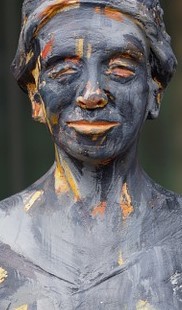 Peabody halted a couple of feet below the static figure. He half-expected a sniggering copper to come out from behind it. But no one did. The only sound was the rustling and flapping of the forensics tent down in the dip. Cautiously, almost gingerly, he scrambled up the remaining distance until he was face to face with it. When he looked down, he saw that its feet were embedded amid broken, twisted branches.Okay, so it hadn’t happened by accident; someone hadn’t just discarded this thing. No doubt there were dozens of such objects scattered across the landfill, but someone must have set this one up deliberately. And in the last half hour or so, because if there was one thing Peabody was certain about, it had not been here when they’d arrived during daylight …
Peabody halted a couple of feet below the static figure. He half-expected a sniggering copper to come out from behind it. But no one did. The only sound was the rustling and flapping of the forensics tent down in the dip. Cautiously, almost gingerly, he scrambled up the remaining distance until he was face to face with it. When he looked down, he saw that its feet were embedded amid broken, twisted branches.Okay, so it hadn’t happened by accident; someone hadn’t just discarded this thing. No doubt there were dozens of such objects scattered across the landfill, but someone must have set this one up deliberately. And in the last half hour or so, because if there was one thing Peabody was certain about, it had not been here when they’d arrived during daylight …Hopefully you like the sound of STOLEN . Well, as I say, it’s published on May 16. Two weeks from now …
THRILLERS, CHILLERS, SHOCKERS AND KILLERS …
An ongoing series of reviews of dark fiction (crime, thriller, horror and sci-fi) – both old and new – that I have recently read and enjoyed. I’ll endeavour to keep the SPOILERS to a minimum; there will certainly be no given-away denouements or exposed twists-in-the-tail, but by the definition of the word ‘review’, I’m going to be talking about these books in more than just thumbnail detail, extolling the aspects that I particularly enjoyed … so I guess if you’d rather not know anything at all about these pieces of work in advance of reading them yourself, then these particular posts will not be your thing.
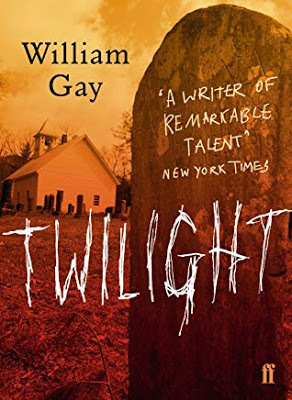 TWILIGHT
TWILIGHT
by William Gay (2007)
An open cart is wheeled into a small backwoods town. Not an unusual occurrence, you may think – except that this cart is carrying the bloodied, butchered remains of a family who were apparently murdered alongside each other out in the terrible and mysterious tract of overgrown wasteland called the Harrikin. Weirder still, there is a dead dog alongside the corpses, a dog wearing diamond studs in its pierced ears. The townsfolk are shocked, if at the same time a little blasé. Because this, it would seem, is the sort of thing that happens out in the twilight zone that is the Harrikin.
And this is the opening to Twilight , William Gay’s superb piece of back-country noir, a more than unsettling tale about amoral madness in the depths of the impoverished American South.
We’re in rural Tennessee in 1951, and two young people – Corrie Tyler, and her younger brother, Kenneth – are suspicious that well-to-do local undertaker, Fenton Breece, has cheated their family. On seeing the expensive casket purchased for their late bootlegger father being used elsewhere, they dig up his grave and discover the corpse of their parent not just entombed in a cheap box but sexually violated. Further investigations of other recent burials – in other words, more grave-robbing, performed secretly and by night – uncovers additional evidence that Breece is a fetishist and necrophile. But Breece is a leading citizen who no-one would think the worse of without hard evidence. Kenneth thus breaks into his house, seeking this out, and discovers, among other purloined and highly inappropriate possessions, a whole package of photographs depicting the well-groomed undertaker having sex with a variety of dead women – deceased citizens recently entrusted to him – all now dressed and made-up to look like glamour queens.
Uncertain about the loyalties of local law enforcement, the Tylers attempt to blackmail Breece, thinking that, if nothing else, they can at least escape to a better life. But Breece, who is influential at many levels locally, has already turned to hoodlum-for-hire, Granville Sutter, a skilled and callous killer, to retrieve the evidence. In the ensuing first clash between the vying parties, Corrie dies, and Tyler flees into the countryside, Sutter close behind.
Tyler is no expert at this sort of thing, whereas Sutter has done it several times at least. The youngster’s only option, or so it seems, is to head into the Harrikin, that vast and dreamy wilderness, trackless, tangled, littered with eerie buildings and rusted, overgrown machinery, and populated by the strangest, most reclusive people – witches, weirdoes, lost souls, forgotten families – all of whom are more than capable of impeding Tyler in his race against death, as well as in shielding and protecting him. It depends how the mood takes them, it depends on the worsening winter weather, it depends on a great many things beyond Tyler’s control, whether he lives and gains justice, or dies a lonely death and finishes up another plaything in Fenton Breece’s squalid funeral parlour vault …
There is considerable debate about how the ‘Southern Gothic’ school of literature can actually be defined, though most advocates of the genre would agree that it originated in the American South, having emerged from the chaos and poverty following the defeat of the Confederacy during the Civil War, and that as such it weaves dark, macabre tales about the damaged human condition with bizarre, often grotesque imagery (much of this concerned with waste, decay and violence), and yet, though often Noirish in tone, tends to lean away from the traditional mystery-thriller into the realms of magic realism, where we’re living in a recognisable world but such is the madness and strangeness of it all that an unearthly atmosphere pervades.
However, to indicate how broad a church this is, countless authors are named as practitioners, some of whom, at first glance at least, seem poles apart from each other.
Joe R Lansdale and Harper Lee? Cormac McCarthy and Tennesee Williams?
But there is one thing that firmly unites them. All are supreme wordsmiths, who write richly and lovingly about their native Deep South. Not always approvingly, often damningly, but always colourfully, evocatively and intriguingly.
Very much at home in this diverse but hyper-talented crowd is the late, great William Gay, who sits firmly at the darker end of what is already a pretty dark spectrum – his work usually characterised by ordinary, everyday folk facing desperate moral dilemmas thanks to frightening encounters with evil – with Twilight among the very darkest of his endeavours.
To start with, it’s exquisitely written. It almost seems like a contradiction in terms when we’re talking about murder and necrophilia and an horrendous journey through a jungle of twisted vegetation and skeletal industrial ruins, but William Gay goes at it in his customary poetic fashion, describing it lusciously and hitting us with one startling visual after another. Never let it be said that beauty can’t be found in waste and decay. Again it seems like a paradox, but we’re almost in the realm of fairy tales, The Wizard of Oz invoked at the same time as The Blair Witch Project , every Germanic woodland fable you can think of (we even have the brother and sister heroes pursued by an ogre!) sitting side-by-side with modern tales of perversion, crime and ruin.
And yet, William Gay does it all with a smile on his face. Though he has much to say about outcasts, loners, the lost and disenfranchised, those who’ve fallen through the cracks even in a depressed economy like rural Tennessee in the early ’50s, and though he is patently disgusted that life is still cheap some fifty years after the Wild West has ended, and sickened by small-town corruption and selfishness, his touch is light. He gives us plenty of laughs along with the screams.
As usual though, none of this would work without characters we quickly get involved with.
Kenny Tyler starts out as the archetypical uneducated country-boy, but inevitably grows in stature during his fight for life out in the world-apart that is the Harrikin, hatching both wisdom and courage, and so giving us a coming-of-age vibe along with everything else.
Fenton Breece, meanwhile, represents a quintessential villain of the Old South, being a snake oil salesman of the most blatant kind, charming, civilised and plausible, all of which nevertheless conceals a truly degenerate soul. The moment he confesses to Granville Sutter that he killed a woman once, and may even – though he doesn’t totally remember it – have killed other women, is quite chilling in its shrugged-off matter-of-factness.
Sutter, though a blunt instrument in comparison, is equally complex, because while Breece is rotten to the core, Sutter has no core at all – at least, none that is recognisably human. He initially appears as a typical town bully, another violent brute where women are concerned, but also a confident disposer of men. So, he’s a boor, yes, but he’s also an out-and-out predator, who’s not just good at what he does because he has a streak of innate cunning that goes a mile deep, but because nothing matters to him. He simply doesn’t care about anyone and was probably born with this deficiency; the way some may come into this world lacking an arm or leg, Granville Sutter did so lacking conscience and charity. A madman, then, a psychopath – but as I’ve already said, and as we see through his dreams and reminiscences, a complex one too.
So how do I sum this novel up quickly? Well, in truth, you can’t.
Suffice to say that Twilight is an engrossing, elegiac study of the human darkness at the heart of what once might have been thought chocolate box America. Be warned, it’s not one of those garish hillbilly horror stories, but there is horror here along with humour and intellect, all of it wrapped up in sumptuous southern prose.
So, horror fans … read it. Thriller fans … read it. Literary fiction aficionados … read it. And surrealists and fabulists … you must read it too. This is Southern Gothic at its most haunting.
Twilight hasn’t, to my knowledge, been adapted for film or TV just yet, and so I’m going to do my usual thing and stick my oar in early, advising any potential movie company who they should be casting when they finally get around to putting this great piece of work on film. Just a bit of fun, of course (like they’d listen to me in real life).
Kenneth Tyler – Ansel Elgort (probably a little older than he is in the book, though not by much)Fenton Breece – Domhnall GleesonGranville Sutter – Michael Chiklis
Published on May 03, 2019 09:42
April 23, 2019
It’s heading this way, the legion of the dead
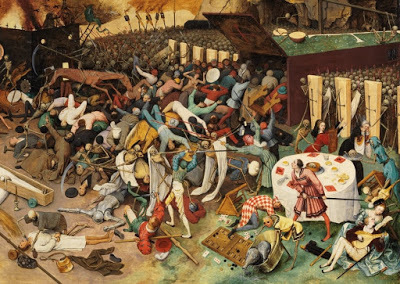
I’m unashamedly channelling Game of Thrones this week, but not, I trust, in a way that anyone will object to. Because, in truth, the main thing I’ll be talking about is my own novel of 2010, STRONGHOLD ... which bears some remarkable similarities to the events currently unfolding in Westeros.
More about that a little later.
In addition, today, on the same subject of epic horror/fantasy novels that have undergone the glossy TV treatment, I’ll be offering a detailed review and discussion of Joe Hill’s big, scary, 21st century soon-to-be classic, NOS4R2.
If you’re only really here because you want to read the Joe Hill review and/or participate in any resulting discussion, that’s fine as always. Just skip on down to the bottom of today’s post. You’ll find my review in the usual Thrillers, Chillers section. However, if you’ve got a bit more time, why not stick around for the other stuff first … ?
Armies of the dead
As promised, I’m going to talk a little bit about Game of Thrones , but I have to be careful here because I know not everyone watches it at the same time these days, and there are probably some folk who haven’t even started on Season 8 as yet. However, it’s probably not too much of a SPOILER to mention that, as we approach the series’ astounding conclusion, the armies of mankind are now massing around the northern citadel that is Winterfell, while the numerically vastly superior armies of the dead are pouring down from the polar region in unstoppable hordes, and that a gargantuan battle is in the offing.
Probably because George RR Martin never – at least, thus far – reached this point in the novel series, it’s proving to be potent stuff. None of us knows what’s going to happen next and we’re all on the edges of our seats with excitement … me included, even though I, more than many, have cause to recognise some of the dynamics in play here.
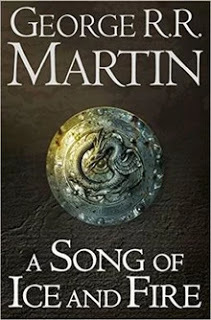 Now, before I start, let me make it abundantly clear that I am NOT accusing anyone of copying anything.
Now, before I start, let me make it abundantly clear that I am NOT accusing anyone of copying anything.There are only so many ideas that have ever been put onto paper, and even though Game of Thrones , or A Song of Ice and Fire , as the books were originally collectively called, only matured in recent times into the gigantic war between the living and the dead that we know today, the saga commenced back in 1996, when the first book in the series, A Game of Thrones , was actually published. So, I can hardly claim that I got there first.
However, let me elaborate a little on the subject of my medieval fantasy/horror novel, STRONGHOLD , first published in 2010, and if nothing else, you’ll see that great minds truly think alike.
In a nutshell, STRONGHOLD focusses on a great fortification, manned by a professional but relatively small army of knights, archers and men-at-arms, and under threat from a colossal force of walking-dead, a horde of rotted but ravening zombies roused from graveyards and carnage-strewn battlefields by Dark Ages magic. Ah yes, you see. There is some similarity here. Only some I’ll admit, but though, overall, it doesn’t even come close to being the same story, it’s close enough for me to feel absolutely no shame in plugging STRONGHOLD this week while everyone is so justifiably excited about Game of Thrones on TV.
Stronghold
It all began in 2009, when I was approached by Jon Oliver, the senior commissioning editor at Abaddon Books, and the unsung genius behind the Tomes of the Dead series.
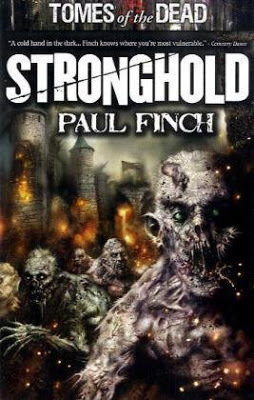 In short,
Tomes of the Dead
was a group of stand-alone zombie novels from Abaddon which, while not occupying a shared universe, were specifically written to mark a subversion or reinterpretation of the genre, while sometimes – though not always – employing a recognisable historical backdrop.
In short,
Tomes of the Dead
was a group of stand-alone zombie novels from Abaddon which, while not occupying a shared universe, were specifically written to mark a subversion or reinterpretation of the genre, while sometimes – though not always – employing a recognisable historical backdrop.My brief was simply to write a zombie novel that would strike a similar note. As a lifelong student of medieval history, and someone who rarely gets the opportunity to fictionalise it outside the short story format, the idea grew on me that I’d like to set something in Britain during the intense and tumultuous reign of the English king, Edward I, who ruled from 1272 until 1307.
Edward Longshanks, as the Scots called him, was a very divisive figure. Though one of the strongest kings that England ever had, and though seen by the English as a just ruler rather than a tyrant, who empowered and enriched his kingdom and came to preside over a near picture-perfect medieval realm, he made relentless aggressive war on England’s neighbours, particularly Scotland and Wales. Ultimately, he was less successful in Scotland, though the violence caused by his ambitions there was ongoing and terrible, while Wales, despite spirited resistance, eventually fell completely under his yoke.
All this is long ago now, and the hostilities are thankfully forgotten, mainly confined these days to rivalry in sport and terrace banter.
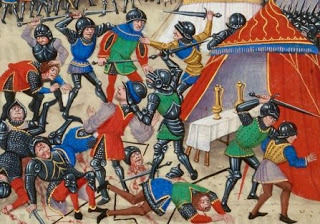 But as both a historian and a writer, I’ve long been intrigued by the split personality of a kingdom that could embrace pageantry and valour, that could build fairy tale castles, sing songs of courtly love and promote the cult of chivalry, a kingdom which in all ways resembled the Arthurian ideal ... and yet one that was also haughty and treacherous with its neighbours, one that would use its immense military power to ghastly effect against its enemies (both real and imagined) and would bring terror and misery to abject lands, while all the time lionising itself for these ‘achievements’.
But as both a historian and a writer, I’ve long been intrigued by the split personality of a kingdom that could embrace pageantry and valour, that could build fairy tale castles, sing songs of courtly love and promote the cult of chivalry, a kingdom which in all ways resembled the Arthurian ideal ... and yet one that was also haughty and treacherous with its neighbours, one that would use its immense military power to ghastly effect against its enemies (both real and imagined) and would bring terror and misery to abject lands, while all the time lionising itself for these ‘achievements’.In so many ways, this is the curse of the West. We saw it in the Romans, the crusaders, the conquistadors, right up in fact to the triumphalist days of the British Empire and the expansion of the fledgling US through territories that basically belonged to other people.
Ugly or not, it’s a fact of history now. It’s also a fascinating dramatic concept.
People who thought they were doing right when plainly they were doing wrong. (Or did they think that? And if they actually didn’t, how on Earth did they handle it in terms of conscience?)
STRONGHOLD gave me the opportunity to try and encapsulate all this in a single horror/fantasy tale.
In it, as I say, I visited Edward I’s England, a dominant military state in the process of violently absorbing a smaller neighbour, Wales …
It’s the year 1295 when the book opens, and the conquest of Cymru is far from complete. King Edward, having constructed a ring of impressive castles to pin down those lands and people that he’s already subdued, now relies on his all-powerful marcher-lords to enforce his will and deal ruthlessly with any recalcitrant.
Thus far, we’ve been following history to the letter, but now we take a right-hand turn into the realms of fiction.
 When the Earl of Clun, one of Edward’s most vicious right-hand men, brings his retinue into Wales, ostensibly it’s to recapture Grogen Castle, which for a brief time has been in the hands of Madog ap Llywelyn’s Welsh rebels, but he also lays waste to the land in the process, burning villages and massacring not just those who’ve surrendered to him in good faith, but all those innocents who have strayed into his path.
When the Earl of Clun, one of Edward’s most vicious right-hand men, brings his retinue into Wales, ostensibly it’s to recapture Grogen Castle, which for a brief time has been in the hands of Madog ap Llywelyn’s Welsh rebels, but he also lays waste to the land in the process, burning villages and massacring not just those who’ve surrendered to him in good faith, but all those innocents who have strayed into his path.Perhaps unsurprisingly, when he reaches Grogen Castle, which is high in the Cambrian Mountains, he finds it abandoned and overlooking a now desolated countryside. Clun reoccupies the mighty structure and awaits further orders. He doesn’t anticipate a massive counter-strike. The Welsh have also been defeated at the battle of Maes Moydog, so in all probability the rebellion is over.
But then something happens that he and his men never expected.
Betrayed by Clun, who promised there would be no reprisals against her people, Welsh countess, Madalyn of Lyn, seeks out Gwyddon, a druid, and with his assistance and the mystical Pair Dadeni, the ‘Cauldron of Rebirth’, she rouses an army of rot and decay, not just those slain by the English in recent campaigns, but those adorning the gibbets from years earlier, those buried under cairns and filling the mountain graveyards.
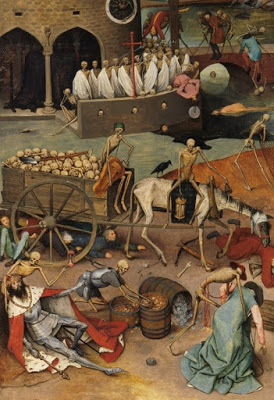 Before Clun knows it, a vast army of the vengeful dead is encroaching on Grogen. Already, his force is cut off. He has only the few hundred men he brought here. They have the advantage of their indomitable ramparts, but the dead have the advantage of already being dead, of not letting wounds impede them, of continuing to attack though bristling with arrows and hacked and clashed by axe and sword.
Before Clun knows it, a vast army of the vengeful dead is encroaching on Grogen. Already, his force is cut off. He has only the few hundred men he brought here. They have the advantage of their indomitable ramparts, but the dead have the advantage of already being dead, of not letting wounds impede them, of continuing to attack though bristling with arrows and hacked and clashed by axe and sword.What follows is a wholesale, non-stop assault on the massive castle, which section by section is gradually overwhelmed. The English, who were at odds with each other in the earlier part of the book, now stand shoulder-to-shoulder and fight furiously, but are aghast with horror as they even see their own fallen inevitably rise up again and join the hideous legion …
Okay, I guess it all sounds pretty simple. A load of sword-wielding blood and thunder, with lots of zombie horror woven in. And all that after I chatted so garrulously about my highfalutin historical and philosophical ambitions. But note that a handful of English knights who have committed terrible atrocities are my central characters here. They – the oppressors, not the oppressed – are the ones under siege and at war with the dead. And this is the point where I try to examine that juxtaposition between bravery and cruelty, honour and arrogance. This is the moment where I take a long hard look at the issues of ‘only following orders’, of ‘my country right or wrong’, of ‘my king before my conscience’, and present my readers with a clutch of heroes who are ravaged by guilt and shame – and all this in the face of impending, seemingly justified destruction.
Okay, sorry about that. Yes, as I said it’s an unashamed plug for a book of mine published nearly 10 years ago, but this is my blog, so I can do what I want (yaaah!).
STRONGHOLD is still out there, still gets quite decent reviews and is still available from most online retailers. So, if you like Game of Thrones , and you can’t wait for that climactic battle between the living and the dead, perhaps you’ll be interested in dipping into this one first?
Just a suggestion.
THRILLERS, CHILLERS, SHOCKERS AND KILLERS …
An ongoing series of reviews of dark fiction (crime, thriller, horror and sci-fi) – both old and new – that I have recently read and enjoyed. I’ll endeavour to keep the SPOILERS to a minimum; there will certainly be no given-away denouements or exposed twists-in-the-tail, but by the definition of the word ‘review’, I’m going to be talking about these books in more than just thumbnail detail, extolling the aspects that I particularly enjoyed … so I guess if you’d rather not know anything at all about these pieces of work in advance of reading them yourself, then these particular posts will not be your thing.
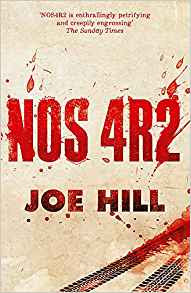 NOS4R2
NOS4R2 by Joe Hill (2013)
A mesmerising horror novel with an air of urban fairy tale about it, though don’t let that fool you. This is one intensely frightening ride.
In a chilling opening scene, we visit a prison hospital in 2008, where Charles Manx, a suspected child killer who has been lying in a coma for years, apparently revives and terrorises a young nurse with stories about a mysterious and terrible place called Christmasland. However, when other staff check on him, he’s unconscious again, his brain function virtually zero.
In one of many leaps back and forth in time, we now move back to 1986, where a feisty youngster called Vic McQueen uses her Raleigh bike and the mysterious Shorter Way Bridge, a semi-derelict structure in the woods behind her Massachusetts home, to travel to the location of whichever object she happens to be looking for, whatever that object may be, wherever the location may lie. She doesn’t know how this happens, just accepts it as magic, even though the more she uses it, the more physical damage it causes to her, particularly to her eye. Vic thinks she’s the only person who enjoys this bizarre privilege, but when one trip takes her all the way to Iowa, she meets a scatty librarian called Maggie, who routinely uses a special bag of Scrabble tiles to answer questions and find missing items in similar fashion. Whereas Vic suffers with her eye, the Scrabble divination causes Maggie to stutter, though both agree that they feel ill generally whenever they’ve worked one of these miracles.
It is while she’s comparing notes with Maggie, that Vic learns about evil Charlie Manx, an older man, who has similar powers to theirs, which he draws through his classic Rolls-Royce Wraith (the registration number of which you can probably guess) and uses them to abduct children.
When Vic heads for home, the Shorter Way takes such a toll on her that she falls seriously ill, losing her Raleigh in the process. Meanwhile, Charlie Manx – a real person, who does indeed kidnap children in his Rolls-Royce Wraith – enlists burgeoning serial killer, Bing Partridge, to assist in his crimes. Partridge works at a chemical factory and steals several tanks of sevoflurane gas with which to overcome the parents of the child-victims (in the process thinking of the gas as ‘gingerbread smoke’ because of its unique smell, one of many instances in which Christmas joy is turned on its head in this book). Ultimately, Partridge is easily recruited because, though sexually depraved, he is childlike in certain ways, and when Manx tells him that he whisks his abductees away to his wonderful secret refuge, Christmasland, where they can do festive things all day and never grow old, it appeals to him immensely.
Flashing forward ten years, we now find Vic McQueen an unhappy teenager, worn out by her even unhappier parents’ constant fighting. After a bitter row with her mother, she uses the Shorter Way to visit Manx’s house in Colorado – a bizarre place high in the pinewoods, where Christmas music plays all day and Christmas ornaments adorn the surrounding trees whatever month of the year it happens to be. Her plan is to get herself abducted in order to punish her mother, but when she finds another young child locked in Manx’s Wraith, she attempts to free it, only to discover that it has transformed into a horrific, vampire-like travesty of the human being it once was. With the child-thing’s assistance, Manx almost captures Vic, his house burning down in the process, but in a desperately tense and superbly crafted scene, she escapes on the back of a motorbike driven by a tubby but startled motorcyclist called Lou Carmody. Even then, Vic isn’t completely safe. The vengeful Manx follows the pair of them to a mountain diner and general store, where he horrifically kills a soldier on leave before other customers overpower him. We now return to 2008, and the current narrative, where the adult Vic has had success as a children’s author and is several years into a relationship with Lou but is again unhappy. The one light in her life is her son, Bruce Wayne Carmody – Lou having named him so because, though lovable, he is also a comic-book geek – but she continually receives phone calls from the vampire children of Christmasland (and very chilling they are!) berating her for the imprisonment of their father, Charlie Manx. Having already spent time in therapy, which has persuaded her that her earlier experience of this was all stress-related fantasy, Vic subsequently lives in terror that she is losing her mind.
Because of all this, Vic separates from Lou, but not on unpleasant terms, returning to New England. As Manx falls into a coma in prison, and finally dies, her life stabilises somewhat. But then, one day in 2012, she is visited by a ragged, drug-addicted version of Maggie the librarian, who tells her not to relax, because while it’s been reported that Manx died in custody, in reality he resurrected himself and escaped from the morgue, and now is on the loose again, this time hellbent on punishing Vic, not so much by killing her, but by abducting her son, Bruce Wayne, and taking him away to the unearthly winter paradise, which, though it exists on no recognisable maps, we readers have seen and experienced for ourselves, so we know that it’s real: Christmasland …
I read a lot of books that purport to be new takes on the vampire theme, but I don’t think I’ve encountered any that are quite as original and different as this one. When Stephen King, Joe Hill’s father, first wrote Salem’s Lot in 1975, it was one of the books that put him on the map as a horror supremo. But the bloodsuckers in that one were pretty traditional in their form and methods. It was the high-quality writing, wonderfully detailed characterisation and the sheer, unadulterated scariness of it that made Salem’s Lot such a gem.
Well, NOS4R2 has all that, plus a genuinely new kind of vampire antagonist. But that’s actually faint praise, because in truth there is so much good stuff in NOS4R2 that it’s difficult to know where to start.
To begin with, the notion of so-called ‘inscapes’ – fantasy realms constructed through sheer thought, which, though unreachable except via trans-dimensional conduits like the Shorter Way Bridge or Charlie Manx’s Wraith, nevertheless exist in a real time and place all of their own – is wondrous.
I admit that, at first glance, it may not work for everyone. The idea that this little girl can travel across the whole of North America in less than a minute by riding her Raleigh bike through a derelict covered bridge in backwoods New England may sound like something from a children’s fantasy novel, but then there’s the not insignificant matter of Charlie Manx, who uses his mysterious and imperious Wraith as his own conduit, though in his case the car also acts as a form of revival system from out of which he can draw life-energy vampirised from the innocent to heal life-threatening injury and illness and even restore himself to youth. It may all sound nutty and implausible, but in the world of inscapes – especially the way Joe Hill writes about them – you buy into it straight away.
Of course, the concept of inscape is not original to NOS4A2 . Hill has played with it before in his two earlier novels, Horns and Heart-Shaped Box . But it is here where he thoroughly investigates and exploits the notion, and though, as I say, it may at first sound like a juvenile concept, in NOS4R2 it is rendered utterly believable and very, very frightening.
Charlie Manx is a key part of that, of course, and an amazing creation. He is first brought to our attention, because we know no better at this stage, as a serial child abductor and murderer, though in due course we realise that he is a lot more complex than that. Manx is one of the best modern variants on the Dracula theme that I’ve ever encountered. Yes, he does capture children and he does transform them into eerie, ghoul-like things. And yes, he is capable of using extreme violence against their parents and other guardians. But he is also a fully rounded individual. We learn about his difficult past and the bizarre philosophy for life that he evolved as a result of it, which leads him to believe that in taking children away to Christmasland and granting them immortality (of a sort) he is genuinely doing the right thing. He is thus playful as well as wicked and develops a great rapport with Bruce Wayne Carmody after he kidnaps the little boy. Manx is almost likable in these scenes, displaying good humour and generosity, while reserving his real disdain for semi-demented Renfield-like servant, Bing Partridge.
Which brings us onto villain number two. Setting aside the obvious Christmas allusions in his name, Bing Partridge is also a very real person and represents more bravura character-work by Hill. To start with, though devoid of humanity, he is no slavering madman, but extremely ordinary in appearance, and though he seems like a dumbass, this is really a shield with which he continually fools the parents of his child-targets, the mothers of whom he then singles out for truly appalling treatment. He even lures the enlightened Vic McQueen at one point, in a scene that, because we readers know about Bing from the beginning, literally reeks of evil.
The good guys in NOS4R2 are equally real and visible.
Vic McQueen is an unusual kind of heroine, first appearing as a spirited youngster mired in a violent and unhappy home – so far so good – but then evolving, perhaps inevitably, into a brattish teen delinquent, and finally reaching her adult incarnation as a scrawny, grungy outsider, scrawled with unsightly tattoos and suffering recurring mental problems. That said, she’s still a looker. Of course, she is; our heroes and heroines must always be lookers. But she’s been through the mill emotionally, and it shows. Even now she has minimal contact with her demolition expert father, who she blames for most of the domestic problems when she was young, and when she finally reconciles with her temperamental mother, the woman is dying from cancer. It’s no wonder that Vic struggles to hold things together even as she does brave and admirable things.
She does have an on/off boyfriend, of course: the affable heavyweight, Lou, with whom, once again, we’re in the realms of superb character-work by Joe Hill. Though a quality mechanic, Lou is an underachiever because he spends whole days with his head in the clouds. He’s brave, though, if a tad dim, and he loves Vic and their son, Bruce Wayne. He’s no hero in the traditional mode but has so many minor redeeming features that we like him all the way through the book.
Bruce Wayne, meanwhile, has inherited traits from both his parents: he’s courageous and inquisitive, possessing his mother’s looks and intellect and his father’s starry-eyed amiability. The youngster is a distinctly warm presence in the second half of the novel, which is a good thing because this section sees Vic tortured even more terribly by the fearsome denizens of Christmasland. In contrast to this terror, Bruce Wayne brings great meaning to her life and cheers us all up every time he appears, at one point even managing to win Charlie Manx over (or at least persuading him to buy them some fireworks, so they can have a bit of non-Christmas fun).
The other thing about NOS4R2 is how well-written it is. Joe Hill is clearly following in his father’s footsteps in producing big tomes – this one clocks in at about 700 pages – but it’s all so readable, and the descriptive work is sumptuous, particularly when we get to Christmasland. It initially appears as a kind of Tyrolean Neverland, where it is always December 25, icicles dangling permanently from lintels, Christmas trees shimmering, snow falling, everyone housed in Alpine ‘cuckoo clock’ lodges, where they spend all day (every day!) in front of hot fires, drinking cocoa and opening presents. And yet there is darkness here too, Hill displaying great skill to subtly show us just how mind-numbingly awful this would in due course become (it’s no wonder the children are deranged monsters).
Ultimately, NOS4R2 is far more than just a horror novel. It’s a haunting tale but an exhilarating one too. There is romance here and wild, escapist fantasy, plus it’s funny as well as frightening, it moves at rollicking pace and is filled with nods and winks to Stephen King’s world as well as Joe Hill’s; there is at least one reference to Shawshank Prison, and one to Derry, the New England town at the centre of It – all of which adds an air of family warmth to the saga, though I don’t wish to give the impression that Hill is some kind of crude imitation of his father. Not a bit of it. There are undoubted similarities – blue collar types in heartland America getting to grip with a fantastically cruel form of supernatural evil is a recurring theme in both these authors’ works – but Hill is perhaps more disciplined than his dad in terms of linear narrative, and at the same time has a slightly more poetic air about his prose. He possesses a strong voice of his own, though I’ve no doubt that his father is very proud of it.
In truth, I haven’t only recently discovered Joe Hill. He was good enough to sign his first collection of short stories, 20th Century Ghosts , for me at a British Fantasy event many years ago and we chatted briefly. His short form work was impressive way back then, and though he hadn’t written any of his novels at that stage, it was pretty evident that he was going to. Well, now the first batch of them are here, and what a treat they are. I’ve no doubt that NOS4R2 and others like it will have universal appeal, but if there is anyone out there who, like me, particularly enjoys those big summertime blockbusters, the ones that were so massive and yet so engrossing that you’d take them away on holiday with you and they’d last you the entire fortnight, then Joe Hill and NOS4R2 in particular are definitely for you.
Okay, well … I usually like to end these book reviews with a bit of fantasy casting, nominating those actors I’d love to see take the lead roles when or if the book hits the screen. But the good news in this case is that a TV series has not just been commissioned, it has been written and shot – and Joe Hill himself, according to his tweets, is very happy with it. So, hell – forget the fantasy casting this week. Let’s wait and see what the real thing is like.
Published on April 23, 2019 00:45
April 14, 2019
When urban myths become chilling reality

We’re talking urban mythology today. True or half-true chillers, which are much more frightening than fiction because the events they describe have actually happened, or at least they are claimed to have actually happened. This is partly because in my new novel, STOLEN, out one month from now, DC Lucy Clayburn finds herself drawn into a nightmarish case entailing a series of atrocities, but only after she starts to investigate a local urban myth.
As that myth involves a mysterious black transit van, today is also an opportune time for us to look at some other creepy but supposedly true stories involving transport (both public and private). I’ll therefore be listing my ‘sinister seven’ spookiest of these, but will only be focussing on those that - as I’ve already said - could well have a kernel of truth in them.
And while we’re on the subject of genuine and terrible incidents on dark, urban streets, I’ll also be reviewing and discussing in my usual intricate detail Pat Barker’s nerve-numbing tale of serial murder in the heart of the inner city – a fictional case derived from all-too-real events – BLOW YOUR HOUSE DOWN.
If you’re only here for the Barker review, that’s fine as always. Just tootle on down to the lower end of today’s post. You’ll find it where my reviews usually are. However, if you’ve got a little more time on your hands, perhaps you’ll be interested first in …
The black van
Readers familiar with my Lucy Clayburn novels will know that she’s a detective constable with a chequered past who now works local CID in Crowley, Greater Manchester Police’s notorious November Division. It’s an ultra high crime district, so she is rarely short of difficult work to do and undergoes continual stress, none of which was helped by the revelation two books ago that her father, from who she has been estranged until very recently and never even knew as a child, is a highly placed gangster in Northwest England’s premier syndicate.
 However, all Lucy’s previous cases, and all the angst they might have caused her, now pale to insignificance, because what she is about to uncover in
STOLEN
can only be described as true inner-city horror, and yet it all starts seemingly so innocently with a rumour – an urban myth, if you like – that a mysterious black transit van has been trawling the housing estates at night and is now being connected with a rash of pet abductions.
However, all Lucy’s previous cases, and all the angst they might have caused her, now pale to insignificance, because what she is about to uncover in
STOLEN
can only be described as true inner-city horror, and yet it all starts seemingly so innocently with a rumour – an urban myth, if you like – that a mysterious black transit van has been trawling the housing estates at night and is now being connected with a rash of pet abductions.Yes, you heard it correctly. Dogs are going missing. So, it’s hardly a high priority for the local overworked and understaffed police force. They don’t even take it seriously. How do local folk know this weird black van is responsible for the missing dogs? Has anyone seen it happen? Does anyone even know if this black van is real? Isn’t it just a schoolyard story given undeserved credibility because of some recent unhappy coincidences?
But then, everything changes … when people also start to vanish.
First of all, it’s the homeless. Again, this is not easy for the police to investigate, because these unfortunates might not have disappeared, they could just have moved on. There are no bodies, no witnesses. There is no evidence of any assault or abduction. It’s another urban myth, isn’t it?
Until householders also begin disappearing. Initially it’s pensioners, but others who are younger and more able-bodied inevitably follow. And now, suddenly, there IS evidence. There is even evidence that a transit van may be involved.
To Lucy’s incredulity, she finds herself assigned to investigate what was previously a silly story, a child’s nightmare, a snippet of folklore. The problem is that she and the rest of the police are late to this game. It may already be the case that something truly horrible is well underway on the November Division.
As I say, STOLEN is out one month from now, May 16 to be exact, from all decent retailers ...
Kernels of truth
Okay, so while we’re on the subject of modern mythology, here, as promised, are the seven weirdest and scariest ‘true’ vehicular stories that I’ve ever heard. As I say, though, I’ve only picked stories that could and may have a grain of genuine truth inside them. So, this is not just a bunch of urban legends. Don’t be looking here for the vanishing hitchhiker, the axe-murderer in the back seat, or the boyfriend’s head being banged on top of the broken-down car. The stories I’ve chosen here are not apocryphal. They could have happened, and maybe – according to the evidence in some cases – they actually did.
Here we go …
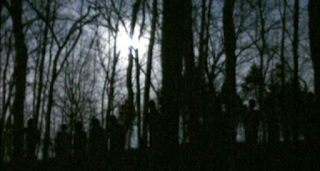 The People in the Wood
The People in the WoodThousands of folk vanish in the developed world every year and often in circumstances that are suspicious. It’s a frightening stat, and one that allows for all kinds of fanciful theories. One timelessly popular one seems to be that cults and covens exist beyond the veil of society, who are dedicated to doing evil (usually murder) and, somehow or other, remain protected from law enforcement. One myth circulating in the US for decades held that such groups would stage accidents on lonely roads late at night, and when a car stopped, leap out and grab the helpful motorist as their next victim.
As I say, fanciful. Except that recently in Floyd County, Georgia, something similar happened to a sheriff’s deputy. Patrolling a nighttime woodland area, he saw a body on the road get up and run out of sight. When he stopped his cruiser and got out, a group of masked, club-wielding figures emerged from the trees. Only by holding them at gunpoint was he able to retreat and drive away. A later search of the woods by fellow officers failed to locate anyone. His department suspected that the ‘body’ had been intended to trap a civilian but had fled at the sight of a police car.
 The Black Volga
The Black Volga
An eerie legend of Eastern Europe during the Soviet era concerned a black Volga allegedly being driven around the backstreets of cities in Poland and Hungary, looking to abduct young women and children. The Volga was a handsome vehicle, unaffordable to most ordinary citizens in Eastern Europe at that time, and so was primarily used by Soviet officials. This fed into the rumour that the Communist elite was snatching young people to use them as sex-slaves, or for other nefarious reasons, such as to harvest their healthy organs or even drain their blood in an effort to find a miracle cure for leukemia.
The story might have had a basis in truth as many people disappeared under the Soviet regime never to be seen again, and a number were taken away in government-owned black Volgas. Needless to say, the myth grew with the telling, the vehicle soon adopting white curtains and wheel-trims, which gave it a vampire-like vibe, and even after the Soviet days had ended, seeing itself reinvented as part of a Satanist conspiracy myth, the cultists involved having sprayed it blood-red and replaced its wing-mirrors with horns.
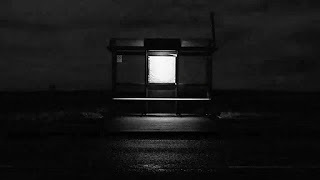 The Old Woman
The Old WomanA famously chilling myth took on an especially scary resonance in Northern England during the late 1970s. It held that a nurse, at the end of a late shift, was driving along a moorland road in pouring rain when she spied an old woman waiting alone at a bus stop. Knowing that no bus was coming this late, the nurse stopped her car and offered a lift. However, not long later, the nurse became uneasy. The old woman had a sour disposition and when she lit a cigarette, the flare of the match exposed hairy ‘apelike’ hands. Stopping the car, the nurse fooled her passenger into stepping out and checking on the headlights, at which point she promptly drove away.
Later, on realising the old woman had left her handbag in the car, the nurse felt guilty and went to a police station, only for the police to open the bag and find that it contained nothing but a meat cleaver. Inevitably, the old woman was looked for but never found. In the late ’70s, the Yorkshire Ripper was terrorising that part of the world, and the West Yorkshire Police allegedly investigated one version of this story which supposedly had taken place on the Leeds to Tadcaster road.
 The Vanishing
The VanishingThe disappearance of Brandon Swanson may sound like an urban myth, but unfortunately, it’s 100% true. It was in 2008, and Swanson, a student at Minnesota West Community College, had just completed his spring semester. He was driving home late at night, when, lost on a backroad, he ran into a ditch. With his car immobilised, he called his family. Unable to give his exact whereabouts, he told them that he thought he was close to the city of Lynd. Swanson’s parents came to collect him, and to help pinpoint him, continued to chat with him on the phone.
Once they were roughly in the right area, they started flashing their headlights, instructing their son to do the same. However, neither party saw another car flashing, which led both to believe that Swanson was not where he’d thought he was. Swanson thus opted to walk towards Lynd, believing he could see the lights of its outskirts. His parents continued to talk to him on the phone, but at around 2.30am, he suddenly shouted: ‘Oh shit!’ The line went dead and that was it: Brandon Swanson was never heard from again. Police located his car the following day, some 25 miles from Lynd, but there was no trace of the young man and no indication what might have happened to him, despite extensive use of search and cadaver dogs. The case remains open, and foul play is suspected.
 The Never-Ending Road
The Never-Ending RoadAn eerie story from Southern California holds that Lester Road, which leads through the mountains near the city of Corona, would occasionally adopt a supernatural dimension, and run on endlessly, leading to nowhere and taking all motorists unfortunate enough to be using it at the time into oblivion. At first, this sounds like a typical urban legend of the internet era, especially as it is most often to be found on ‘Creepypasta’ websites. But if only it was that simple.
There is no Lester Road in the vicinity of Corona today, but there is a Lester Avenue, though this latter has a suburban nature and it seems unlikely that one could be mistaken for the other. However, one possible explanation for the story lies in an unproven tale that, some time in the recent past, a road repair team were assessing a track through the nearby mountains and discovered a hairpin bend and a sheer drop, which, when approached from a certain direction and at a certain time of day (the lighting would be an issue) created the illusion that the road continued straight on. Reports that the team found many car wrecks and dead bodies at the foot of the drop have not been verified.
 The Child’s Voice
The Child’s VoiceThis story is odd in that it initially appeared to be true, only for questions to be raised later. On August 7, 1973, a child calling himself Larry made contact with truckers in New Mexico using CB radio, crying that his father’s pickup had crashed into a ravine, that his father was now dead and that he could not get out. A major search followed, but it proved impossible to get sense out of the boy. Occasionally his signal faded, but at other times it was picked up in locations as distant as California, Wyoming and even Canada. A helicopter pilot searching the Manzano Mountains, in New Mexico, thought that he was getting close, only to find that the child he was talking to was called David (who he also then failed to locate). When an ex-military searcher made contact with the boy on his high-powered radio set, they spoke for three hours, but Larry remained hesitant to give useful info.
After a week, the boy ceased transmitting, and when police established that no persons called Larry (or David) had been reported missing since Aug 7, the search was called off. Searchers who’d spoken to the child were distressed by this, convinced that the child had been in genuine terror and that it hadn’t been a hoax, but still ‘Larry’ has never been traced. It remains a singular and eerie mystery.
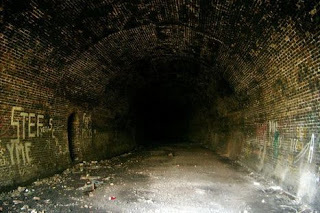 The Dead Body Train
The Dead Body TrainLondon’s Underground is well-known to be haunted, but the scariest story connected with the ‘the Tube’ is that of the so-called ‘Dead Body Train’. Myths tell that a tunnel closed to public traffic once ran from the Royal London Hospital to a destination unknown, passing only one regular station en route, Whitechapel, but never stopping there ... because its passengers were corpses, hundreds of them stacked in cheap coffins. It sounds outrageous, and of course the authorities deny it, but many old employees on the Underground insist that the story is true.
But what on Earth was it? The mysterious transport has allegedly been out of service since 1900, so it could not have been used to deliver WW2 bombing casualties to hastily-built crematoria or even Spanish Flu victims during the pandemic after WW1.
No official document records the existence of this macabre vehicle, and there is no physical evidence … except a curious bricked-up tunnel at Whitechapel Underground Station, which leads in the direction of the Royal London Hospital, but which no one seems able to explain. The kernel of truth in this tale may lie in the story that bodies were once briefly stored at Whitechapel when the Royal London became overcrowded, and that in Victorian times, the London Necropolis Railway ran funeral trains overground to out-of-town cemeteries. The spooky legend persists though, and the Dead Body Train can still supposedly be heard running through tunnels that no longer exist.
THRILLERS, CHILLERS, SHOCKERS AND KILLERS …
An ongoing series of reviews of dark fiction (crime, thriller, horror and sci-fi) – both old and new – that I have recently read and enjoyed. I’ll endeavour to keep the SPOILERS to a minimum; there will certainly be no given-away denouements or exposed twists-in-the-tail, but by the definition of the word ‘review’, I’m going to be talking about these books in more than just thumbnail detail, extolling the aspects that I particularly enjoyed … so I guess if you’d rather not know anything at all about these pieces of work in advance of reading them yourself, then these particular posts will not be your thing.
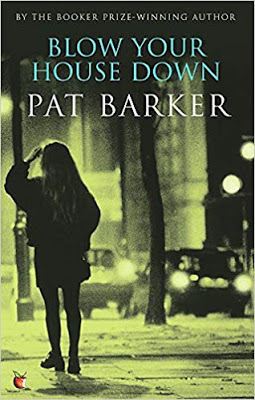 BLOW YOUR HOUSE DOWN
BLOW YOUR HOUSE DOWN by Pat Barker (1983)
In an industrial city in the Northeast of England in the early 1980s, not long after the crimes of the Yorkshire Ripper, another serial killer is on the loose, a faceless assailant who is slowly working his way through the town’s prostitutes, beating and strangling them, and then hacking them to death with a butcher’s knife.
There is a degree of panic on the streets, but it’s probably not as great as it would be were the victims not sex-workers. Likewise, while the police flood the district with detectives and undercover officers, they make little headway and adopt a distinctly unimaginative approach, waiting and watching from cars on the off-chance the killer will strike again, in other words using the street-walkers as living bait.
In the midst of this horror, a young mother in the neighbourhood, Brenda, is gradually descending into prostitution.
Abandoned by her waster husband with three children to feed and colossal debts to pay, she tries at first to get herself an honest job at what is referred to as the ‘Chicken Factory’, a hideous relic of the industrial past, where the birds, which come in alive, are killed, plucked, gutted and packed for sale (a fairly blunt simile for the working-girls themselves). The work is hard, slimy and sickening, grease covering everything, even getting into the tea, the floors swimming with blood and feathers.
Brenda tries to stick it out but can’t, especially when she learns that the child-minder looking after her children is abusing them, which means that she must care for them herself during the day (so there goes the job, whether she likes it or not). With nothing else for it – the charity and assistance of neighours will only go so far – she finally takes to the streets.
This, of course, brings whole new degree of grimness to her life: not just the terror of standing in the shadows under the viaduct, knowing that other girls have died nearby, but also having to engage in lewd acts with all kinds of brutish, boorish men, learning to loath both them and herself in the process. It doesn’t even end when a more experienced fellow-prostitute, Kath, offers to show her the ropes. Kath is kind but has many problems of her own, including alcoholism and terrible judgement. Part One of the narrative ends in the most horrific circumstances, Kath falling foul of the prowling killer, being lured into a derelict house and there dying in the most graphic, ghastly and sexually explicit way, but only after the murderer – who remains anonymous in the cloying darkness of the nighttime backstreets – reveals himself to be an impotent nonentity.
Despite this, life for the other prostitutes goes on. Brenda is now part of a close-knit clique, who find comfort in each other’s company, especially when they’re in the pub together, and do the best they can to look out for each other when they’re on the street – even if there is now a new air of fear and despair, the sad face of Kath looking down at them all from billboards and posters.
One of them, Jean, responds slightly differently. Another of the killer’s recent victims, Carol, was her part-time lover, and she takes this loss so personally that she determines to get even with the madman herself. She thus goes out, working the streets alone, hoping that she’ll encounter him, and as she’s secretly armed, fully intending to kill him when he attacks her.
But Blow Your House Down is not a crime novel in the traditional sense, and Pat Barker did not write it to be a melodramatic revenge thriller. It’s very much a slice of brutal authenticity, strongly influenced by the dark tragedy that was the real-life Yorkshire Ripper case, in which the victims turned out to be tired and weary mothers, often struggling for money, rather than the tawdry glamour-pusses we see in the movies, and the villain a pathetic, inadequate nobody rather than some monstrous murdering devil like Hannibal Lecter or Leatherface (and in which, as also happens later in this novel, women were struck down who were not sex-workers, and whose lives and the lives of whose families are devastated as a result).
As such, for all Jean’s courage, attempting to take the law into your her hands is never going to end well. Blood may well flow, but whose is it likely to be? …
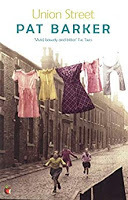 Blow Your House Down
was Pat Parker’s second novel, published ten years after the very successful
Union Street
, which also examined the difficult lives of working-class women in the industrial North of England. Inevitably, the fact that there’s a maniac on the loose changes the tone of this second book, but it’s important to reiterate that
Blow Your House Down
is not a murder mystery. It’s not a story about a serial killer, and it’s certain not about those charged with catching him. Even Jean, the prostitute determined to get vengeance, is a sad, forlorn figure, who displays little heroism and almost no common sense at all as she undertakes her dangerous quest.
Blow Your House Down
was Pat Parker’s second novel, published ten years after the very successful
Union Street
, which also examined the difficult lives of working-class women in the industrial North of England. Inevitably, the fact that there’s a maniac on the loose changes the tone of this second book, but it’s important to reiterate that
Blow Your House Down
is not a murder mystery. It’s not a story about a serial killer, and it’s certain not about those charged with catching him. Even Jean, the prostitute determined to get vengeance, is a sad, forlorn figure, who displays little heroism and almost no common sense at all as she undertakes her dangerous quest.What’s it really about is the women themselves, the victims and the would-be victims, and when you think about it, that’s incredibly refreshing as, so often in books like this we walk with the killer and wallow in his madness, or focus on the cops, feeling every inch of their stress as they struggle to bring in their man, while the victims are treated like faceless slabs of meat.
Blow Your House Down turns all that on its head.
The police, on the few occasions they appear, are shadowy, ambiguous figures, who offer no comfort or reassurance to the street-women, while, though on occasion we do see things from the killer’s perspective – in that scene, for example, which comes straight out of such gritty cinema classics as Psycho , Frenzy or The Boston Strangler – most of the time he’s in the background, little more than a rumour, an urban myth. Instead, for much of the narrative, the fear is caused by other men; not just the layabout boyfriends and drunken, violent husbands (though they do their bit to make the women’s lives even more arduous, one husband, Bill, becoming a police suspect for a time, which destroys his wife’s life in a way that the terrible injuries she survives never could), but the other guys who approach them in the darkness under the viaduct, or behind billboards bearing pictures of the dead, to offer money for sordid encounters – at least, the women hope they’re going to be sordid encounters, and not something a thousand times worse.
What an existence, you may think.
And you’re right. Because even in the more cheerful scenes, when the women gather to joke and drown their sorrows in The Palmerston, a pub in the heart of the red-light district, it’s always undermined by a sense of slow-burning dread, because – though there is a degree of bravado about it – both we and they know that they’re going to have to go out again shortly, and the fear factor is high.
So far so good. In fact, so far so excellent. The book makes for an intense and compelling read. But in character terms, the critics have been more circumspect.
The prostitutes' sorority is strong. They have to look out for each other, because nobody else will. These are people who have nothing, except their kids and each other, and all the while a killer is relentlessly hunting them. But this sisterly closeness is their group response to the crisis. Individually, they’re ghosts. They almost blend into one. You could assume that this is because all uniqueness has been hammered out of them by hardship. However, some readers have criticised Blow Your House Down for not stamping the women with stronger personalities. It’s possible to see them as having been individuals once, even if they aren’t any longer. But whatever the author’s aim, it’s undeniable that none of the characters really shows much depth.
However, if Pat Barker stints on deep character development, one thing she never holds back on is grimness. It would be easier, for the sake of taste and decency, for the author to gloss over the dirty details of this seedy world, but that is not what she’s about here. The dialogue is thick with vernacular and four-letter words. The sex scenes are strictly ‘wham slam thank-you, mam!’, minus romance or even eroticism, while, more often or not, the men are so nervous and embarrassed that they can’t even manage to make them about lust. The sites of these trysts are always backstreets and factory yards, amid filth, beer cans and used condoms.
The murder of Kath, as already mentioned, is one of the most distressing that I’ve ever seen on the written page and is purposely prolonged so that the reader isn’t spared one half-second, and because we are in the murderer’s mind while it happens, we are completely unmoved by any of that. It’s a simple, brutal act, which we perform for our own gratification, and the object of our rage might as well be a lifeless mannequin.
If none of this is enough, Pat Barker reflects the localties where these things happen in vivid detail. The Chicken Factory is a blood-spattered hellhole; the pub – The Palmerston – though noisy and crowded, is a classic example of those dingy street-corner boozers, filled with smoke and often volatile in mood; even the streets themselves are unforgiving. I served as a copper in the Manchester badlands in the 1980s, and lived all through the Yorkshire Ripper rampage, and can honestly say that Pat Barker completely captures the atmosphere of that dreary, post-industrial time when mills were empty shells, houses stood in boarded-up in rows, and everything looked as if it was shortly to be demolished.
Not everything about Blow Your House Down is considered to be perfect. The final sequence, which follows the fortunes of Maggie, a local factory-worker rather than a prostitute, who survives a savage attack that could conceivably be the work of the same killer, has been described as ‘odd’ and ‘out of place’. Though it is clearly intended to bridge the gap between the nocturnal world of sex-workers and the ordinary life of everyday folk, implying that the threat of random violence is to be dreaded across the board, especially when the victims are only chosen out of convenience, it maybe jars a little, and I can understand how it doesn’t provide a satisfactory conclusion to the narrative for everyone (especially if they were expecting the killer to be caught in a definitive, clear-cut way).
However, Blow Your House Down remains a remarkable and thought-provoking little book – it only clocks in at 176 pages – and provides an affecting, highly authentic and at times completely shocking read. Okay, it doesn’t really constitute a traditional thriller, but that was never the intention, and even though I’m a thriller fan, I found myself thinking about it for days and days after I’d finished reading. That makes it a winner for me and one that I have no hesitation in recommending to all fans of uber-dark fiction.
As always, I’m now going to chip in with my recommendations for a cast should Blow Your House Down ever make it onto TV or film. Who knows whether this will ever happen? I’d love it to, though it would make for tough viewing, let me tell you. Anyway, even though I doubt any casting director would ever listen to me, here we go:
Brenda – Joanne FroggattJean – Eve MylesKath – Claire FoyMaggie – Helen McCroryBill – Ian Beattie
Published on April 14, 2019 06:54
February 20, 2019
Can evil cascade through the generations?
 Big news today as I’m exclusively able to unveil the cover to my next Lucy Clayburn novel, STOLEN.
Big news today as I’m exclusively able to unveil the cover to my next Lucy Clayburn novel, STOLEN.Here it is, alongside. Hope you approve. It’s certainly eye-catching, I’m sure you’ll agree.
I’ll talk a little bit more about that in a minute, but in addition this week, I thought it would be interesting to take a trip down memory lane and check out 10 of the worst serial killers in distant history – you know, that long-ago period of time when serial killers weren’t supposed to exist? I’m hoping you’ll find that section of today’s blog informative if not exactly fun. And in keeping with that subject, this week’s book review is an intriguing one indeed.
I’ll be focussing on THE WEREWOLF OF BAMBERG by German author, Oliver Potzsch. Despite sounding like a horror novel, this is actually an intense period crime-thriller. As always, you’ll find that detailed review towards the lower end of today’s blogpost. You can jump straight down to it if you wish, or alternatively you can hang around for those other things I promised to mention.
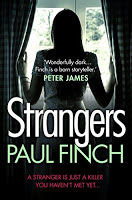 STOLEN
, the third outing in the Lucy Clayburn series, due for publication on May 16, takes my young Manchester policewoman into slightly different territory from the norm.
STOLEN
, the third outing in the Lucy Clayburn series, due for publication on May 16, takes my young Manchester policewoman into slightly different territory from the norm.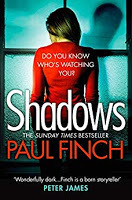 In
STRANGERS
, she went undercover as a prostitute to try an apprehend a streetwalker who was sexually murdering her male clients, and in
SHADOWS
she was a part of the team pursuing the so-called Red Headed League, a gang of ultra-violent armed robbers who were preying on the city’s gangsters.
In
STRANGERS
, she went undercover as a prostitute to try an apprehend a streetwalker who was sexually murdering her male clients, and in
SHADOWS
she was a part of the team pursuing the so-called Red Headed League, a gang of ultra-violent armed robbers who were preying on the city’s gangsters.In STOLEN , it’s different again, Lucy getting involved in a baffling and distressing case when a bunch of OAPs and vagrants start dropping out of sight one by one. Again, it feels as if a killer is on the loose, but the eventual truth will be infinitely more terrifying even than that.
For fans of the Lucy Clayburn series, I can assure you there will be much of the usual: genuine Brit-Grit as she wends her way around the trash-strewn Manchester backstreets, dealing with lowlifes of every sort, clashing constantly and ever more aggressively with the city’s contingent of career criminals, and at the same time, though she rides a Ducati motorbike and mingles with toughs, using brain rather than brawn in her efforts to solve a perplexing mystery.
I think I can safely add that there are one or two traditional(ish) horror elements in this book too. It’s NOT a horror novel, of course – it’s firmly a crime-thriller. But one subtext we’ll be looking at is the way evil, if it goes unchecked, can cascade down the ages and through the generations like a virus. We’ve also got some very gruesome deaths – some of the worst I’ve ever committed to paper, I think – and a few decayed, post-industrial settings that wouldn’t be out of place in the dark neo-Gothic world of the Universal Frankenstein films of the 1930s.
Okay, that’s enough for now. As I say, STOLEN can be purchased from May 16 from all the usual outlets, but it’s available for pre-order right now.
And now that other little thing I was talking about …
Slaying since time immemorial
There is a popular misconception that serial killers only commenced their war against mankind from the late 19th century, from roughly around the time of Jack the Ripper, whereas during all the ages before then we’d been spared this bizarre and terrible form of deviancy.
Unfortunately, the truth is grimmer.
Jack the Ripper, though he laid down a bloodstained template, wasn’t even London’s first serial killer, let alone the world’s. All the way back through the 19th century and into the 18th, the annals of crime repeatedly report the escapades of criminals who killed, raped and tortured repeatedly. But at a time when policing was sparse and disorganised, and communications across counties (never mind across whole countries) poor to nonexistent, it’s perhaps no surprise that these terrifying stories did not become the national cause célèbres that they are today. And that is even more the case if you delve deeper into antiquity.
 It’s entirely possible that before industrialisation, in an age primarily of agriculture, there was less day-to-day violent crime simply because populations were more dispersed and family units stronger. Famed psychologist, Abraham Maslow (left) conjectured that rape and murder in particular were crimes that flourished in overcrowded slums, where people were forced to live on top of each other and had nothing else in their lives but work, drudgery and alcohol. But whereas that rule might have applied generally, in truth you don’t need to gaze too penetratingly back into the distant mists of time to discover that there were still some individuals who were equally as vicious, cruel and deranged as the worst of our modern-day serial murderers.
It’s entirely possible that before industrialisation, in an age primarily of agriculture, there was less day-to-day violent crime simply because populations were more dispersed and family units stronger. Famed psychologist, Abraham Maslow (left) conjectured that rape and murder in particular were crimes that flourished in overcrowded slums, where people were forced to live on top of each other and had nothing else in their lives but work, drudgery and alcohol. But whereas that rule might have applied generally, in truth you don’t need to gaze too penetratingly back into the distant mists of time to discover that there were still some individuals who were equally as vicious, cruel and deranged as the worst of our modern-day serial murderers.Many of them, of course, are what we would classify today as despots:
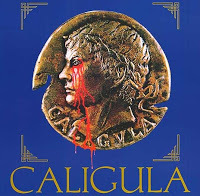 The likes of Nero (37-68 AD), Caligula (12-41 AD), Commodus (161-192 AD) and Caracalla (188-217 AD), perhaps the four most notoriously unhinged Roman emperors, or all-conquering, all-slaughtering warlords like Attila (406-453 AD) and Ghengis Khan (1162-1227), or rulers who simply defined themselves by their casual but ruthless brutality: Vlad the Impaler (1428-1477), Ivan the Terrible (1530-1584), Bloody Mary of England (1515-1558).
The likes of Nero (37-68 AD), Caligula (12-41 AD), Commodus (161-192 AD) and Caracalla (188-217 AD), perhaps the four most notoriously unhinged Roman emperors, or all-conquering, all-slaughtering warlords like Attila (406-453 AD) and Ghengis Khan (1162-1227), or rulers who simply defined themselves by their casual but ruthless brutality: Vlad the Impaler (1428-1477), Ivan the Terrible (1530-1584), Bloody Mary of England (1515-1558).The simple explanation behind these icons of evil could be that they are yet further examples of humanity’s folly when it comes to appointing leaders who are completely unsuited to the task – even in recent times it is clearly the case that people hold power who patently shouldn’t – while the rest of society got on swimmingly because they were all downtrodden together. But these warped individuals undoubtedly tick many of the serial killer boxes: rampant narcissism, sexual sadism, casual cruelty, consciences that were either inert or completely absent. And anyway, you don’t have to look very much farther into the lower orders of these same time-periods to discover that there were other heinous villains on the loose too, and this lot you might have missed at first glance because they were humbler creatures and therefore not as newsworthy (especially in an age when there was no news-wire at all).
At the end of the day, don’t worry about it. You won’t have to go leafing through the dusty chronicles yourselves, because I’ve done it for you. Today, as promised, I’m going to showcase 10 little-known cases of serial murder from distant history.
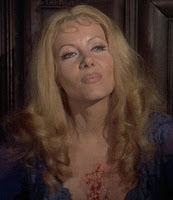 Before I proceed there are one or two that most of us – certainly those of us who are horror fans – will already be familiar with. Gilles de Rais (1405-1440), Elizabeth Bathory (1560-1614, pictured right, Hammer-style, aka Ingrid Pitt) and Sawney Bean (16th century – if he existed at all!) are infamous the world over and would figure in any list of mankind’s worst killers even by modern standards, so I’m purposefully going to leave those three out.
Before I proceed there are one or two that most of us – certainly those of us who are horror fans – will already be familiar with. Gilles de Rais (1405-1440), Elizabeth Bathory (1560-1614, pictured right, Hammer-style, aka Ingrid Pitt) and Sawney Bean (16th century – if he existed at all!) are infamous the world over and would figure in any list of mankind’s worst killers even by modern standards, so I’m purposefully going to leave those three out.The focus today, in chronological order, is those human predators of ancient antiquity who remain largely unknown:
Locusta
A bit of a cheat in this first instance, as Locusta was an expert poisoner and professional assassin rather than a serial killer per se, but one can’t help wondering how she’d ever have acquired such a macabre skillset if she hadn’t been very interested (and experienced) in it from the outset. All we really know about her is that she came to Rome from Gaul in the early 50s AD, already an accomplished poisoner, and that she rapidly began hiring herself out to high-paying clients, carrying out an unspecified number of successful murders.
Somehow detected and imprisoned, she saved herself by providing effectively destructive potions to some of the city’s more ruthless celebrities, such as Agrippina the Younger, and later on, her son, Emperor Nero, who was so impressed with the results that he pardoned her, paid her handsomely and appointed her head-tutor at a special school for poisoners. Locusta came unstuck when Nero committed suicide in 68 AD. She was arrested again by the Emperor Galba, who paraded her as a typical example of his forerunner’s amoral degeneracy, and this time was executed after first been led through the streets of Rome in chains and mocked and stoned by the populace.
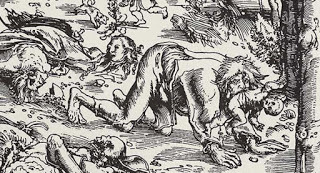 Gilles Garnier
Gilles GarnierClassic example of a serial killer whose depredations were so horrifying to the community he terrorised that it soon came to believe a monster was in its midst, specifically a werewolf. Known as the ‘Wolf of St Bonnot’, Garnier lived in Dole in the Franche-Comte Province of France in the 1570s. A married man, but already a reclusive outsider with a bad reputation, it might have been inevitable that Garnier would become a suspect when, in 1572, a series of murders of local village children began. But Garnier brought the full force of the law down on himself the following year when he was found in possession of one of the bodies.
The murders had been spectacularly gruesome, five infants strangled and then mutilated, meat torn from their bones presumably for the purpose of cannibalism. It perhaps isn’t difficult to see why a primitive rural community felt they were in the grip of a man-wolf, and when Garnier confessed as much, saying that a magical ointment had enabled his transformation, the case was deemed complete. He was duly convicted and burned at the stake. Historians now consider him an archetypal serial killer, probably driven to his crimes by a combination of lust and hunger.
Peter NiersWhether Niers was guilty of all 544 of the brutal murders he was eventually convicted for, it’s clear that he was involved in violent crime as a profession, and that he relentlessly robbed and killed across a wide area of southern Germany in the 1570s, one of a network of bandits plaguing the remoter, more thickly forested regions.
He also seems to have been fairly well-known. Other captured highwaymen named him as an accomplice in numerous horrible offences, including the murder and rape of young women in darkened backstreets as well as the more mundane murder-for-profit of travellers on lonely roads. Niers himself, held in the late 1570s in Gersbach, confessed to 75 such slayings, but after escaping, even that massive body-count appears to have grown exponentially, with pamphlets and ballads carrying tales that Niers had now made a pact with the Devil, and as such, had become an evil sorcerer who frequently sacrificed unborn babies that he’d cut from the wombs of their still-living mothers. Such infamy was his ultimate undoing.
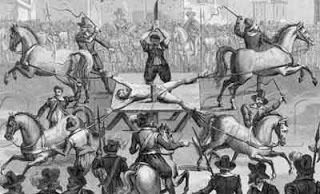 On his capture in 1581 (having been recognised in a bathhouse in Neumarkt), he was tortured, confessed, and later executed by being flayed, roasted, broken on the wheel and quartered.
On his capture in 1581 (having been recognised in a bathhouse in Neumarkt), he was tortured, confessed, and later executed by being flayed, roasted, broken on the wheel and quartered.Christman GenipperteingaDespite the casting of Peter Niers as a kind of 16th century Public Enemy No. 1, another felon operating in much the same area at much the same time, appears to have run up an even more incredible tally of victims. German bandit, Christman Genipperteinga supposedly murdered 964 people during a reign of terror lasting from 1568 until 1581.
On the face of it, this number appears to be so preposterous that it’s led some scholars to wonder whether Genipperteinga ever existed at all and to question if he’s in fact a composite of a number of violent criminals who were on the loose in southern Germany at the same time. That said, when there was almost no organised law-enforcement with which to combat widespread banditry, and in a land of extensive wilderness, it’s not impossible that such an individual could have prospered.
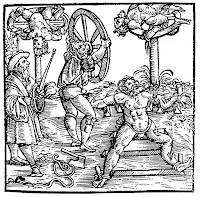 Genipperteinga mainly attacked travellers from a clifftop stronghold in the Bernkastel-Kues district, but he also murdered accomplices, poisoning them and dumping their corpses down mine shafts, and after kidnapping a young girl, fathered six children by her, strangling them all. Finally arrested in 1581, he was broken on the wheel, and left lingering on the gibbet alive for nine days.
Genipperteinga mainly attacked travellers from a clifftop stronghold in the Bernkastel-Kues district, but he also murdered accomplices, poisoning them and dumping their corpses down mine shafts, and after kidnapping a young girl, fathered six children by her, strangling them all. Finally arrested in 1581, he was broken on the wheel, and left lingering on the gibbet alive for nine days. Peter StumppBest known of this bunch of deviants, Peter Stumpp – more famous as the ‘Werewolf of Bedbourg’ – was yet another German serial slayer of the 16th century, but his particular case raises several questions. Why did so many sadistic mass-killers infest Germany at this time? And just how credulous were the local courts?
Peter StumppBest known of this bunch of deviants, Peter Stumpp – more famous as the ‘Werewolf of Bedbourg’ – was yet another German serial slayer of the 16th century, but his particular case raises several questions. Why did so many sadistic mass-killers infest Germany at this time? And just how credulous were the local courts?Stumpp was a farmer in the Bedbourg district of Cologne, whose crimes during the 1580s were so ghoulish that for years afterwards it was considered a certainty he’d been a werewolf. But did the local authorities really believe that, or were they just going along with mass hysteria so as not to look complacent?
One modern theory is that a succession of harsh winters prior to this had damaged crops, causing famine and lawlessness; that might have explained the preponderance of vicious criminals. In addition, the Electorate of Cologne was embroiled in sectarian warfare throughout the 1580s, meaning that heresies were rife and that atrocities often went unpunished, so the few offenders brought to trial had to be made examples of; declaring them werewolves and making them pay the ultimate horrendous price was a lesson that would have been lost on no one.
Stumpp certainly assisted with this. Arrested in 1589, he admitted to having killed and butchered 14 children (including his own son) and two women during a lifetime of devil-worship. He also claimed to have met Satan, who’d given him a wolf-belt that turned him into a beast.
In reward for his crimes, he was broken on the wheel and then burned in the same fire as two convicted accomplices, his wife and daughter.
Björn PéturssonIceland’s only known serial killer to date, Björn Pétursson’s life reads like a horror novel, and yet much of it is testified to in reliable court documents. The nastiness started early, his mother having developed a craving for blood while pregnant with him, and his oddball father agreeing to let her drink his.

After this, born into a bleak corner of the Icelandic interior in 1555, Pétursson led as conventional a peasant childhood as possible (despite showing some violent tendencies), but at the age of 15 had a bizarre dream in which a stranger told him to climb a local mountain, on top of which he’d locate the implement that would make his name. The next day, Pétursson climbed the peak and found the axe with which he would go on to kill his first victim, a neighbouring farm-boy chosen at random. Though it was only after he’d inherited a nearby croft that he gave full rein to his blood-lust, slaughtering all visitors and passers-by with the same trusty blade. In 1596, when a homeless woman escaped his clutches (after he’d already slain her three children), he was arrested.
The remnants of many corpses – one estimate is 18 – were found on the premises, and Pétursson was convicted and subsequently became another to die bloodily on the breaking-wheel.
 La VoisinParis in the 17th century was a hotbed of crime and vice, much of it interwoven with witchcraft, and one of the queens of this cesspit was Catherine Montvoisin, aka ‘La Voisin’.
La VoisinParis in the 17th century was a hotbed of crime and vice, much of it interwoven with witchcraft, and one of the queens of this cesspit was Catherine Montvoisin, aka ‘La Voisin’.A key problem with the 21st century conviction that witchcraft trials were all nonsense and the alleged perpetrators invariably innocent is that it doesn’t allow for the widespread belief in witches at the time, which was one good reason why considerable numbers of cunning individuals behaved as if they were witches in order to make money. La Voisin was probably the best example we have, an habitual drunk but also the organiser of an all-female network of abortionists, midwives and fortune-tellers who slowly graduated to casting spells, holding Black Masses (involving draining blood from aborted foetuses, but sometimes from live babies too), and, to make it look as if their hexes worked, administering lethal substances (using such horrific methods as serving deadly elixirs and rubbing arsenic into syphilis sores).
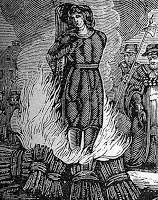 Estimated to have killed almost 2,500 victims, La Voison was arrested in 1679, when Louis XIV’s secret police moved in. Her belief that, having worked for highly-placed Parisians, she’d be protected, came to nothing. She was burned at the stake in 1680.
Estimated to have killed almost 2,500 victims, La Voison was arrested in 1679, when Louis XIV’s secret police moved in. Her belief that, having worked for highly-placed Parisians, she’d be protected, came to nothing. She was burned at the stake in 1680.Beast of GévaudanA seminal case for all kinds of reasons, not least because it established several tenets of werewolf lore, namely that all the best cases were to be found in France, and that it would require silver bullets to dispatch them. For our subject today - historical serial killers - the Beast of Gévaudan isn’t as tenuously connected as some may think, because serial murder is one of very few possible explanations for the mystery that occurred there.
In short, between 1764 and 1767, a 90-kilometre region of south-central France was the scene of a murderous rampage, which claimed 113 deaths, some of the victims partially eaten, all with their throats torn.
 It was a made-to-measure werewolf case, except that this was the Age of Enlightenment, and no one believed in werewolves anymore. Despite this, witnesses claimed to have seen a wolf-like creature, and when the carnage ended, a hunter called Jean Chastel having shot the beast with a silver bullet, the carcass was that of a large but unknown species of wolf.
It was a made-to-measure werewolf case, except that this was the Age of Enlightenment, and no one believed in werewolves anymore. Despite this, witnesses claimed to have seen a wolf-like creature, and when the carnage ended, a hunter called Jean Chastel having shot the beast with a silver bullet, the carcass was that of a large but unknown species of wolf.The Chastel incident is now dismissed by certain modern commentators, who have decided that no single wolf could have been responsible for such carnage and now suspect that an unknown human agency was attacking villagers with a trained animal (possibly a lion), a theory examined in the 2001 movie, (Brotherhood of the Wolf).
Lewis HutchinsonIn another case that could easily become the subject of a Gothic horror film, Scottish immigrant Lewis Hutchinson arrived in Jamaica in the 1760s, claiming to be a doctor, though his real past was unknown. The first thing he did was purchase a ruined plantation house, which he restored and named Edinburgh Castle.
Up to this point, he’d behaved legally, however suspicions soon grew that many of the cattle he started raising there were stolen. If that was his worst offence, he might have been tolerated, but then travellers started disappearing in the vicinity. Initially, no one knew that Hutchinson was using them for target practise, literally waylaying them with gun in hand and hunting them down like animals, killing them for sport. Afterwards, he would pocket whatever wealth they’d been carrying, and his slaves would butcher the corpses, disposing of the fragments in a nearby sinkhole.
The longer Hutchinson remained at liberty, the more reckless he became, murdering invited dinner guests and letting stories spread that he held obscene orgies at the Castle. But after shooting dead a British soldier who was trying to arrest him, he tried to flee Jamaica, only to be arrested by the Royal Navy, and hanged in 1773. Excavation of his estate later uncovered a total of 43 corpses.
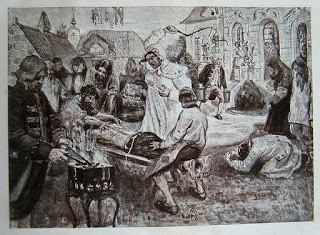 Darya Nikolayevna SaltykovaIn times gone by, the easiest way for a sadistic murderer to act out his/her violent fantasies and yet limit the chances of lawful retribution was for the victims to be selected from the lower classes, especially if they were indentured to the killer as servants or slaves.
Darya Nikolayevna SaltykovaIn times gone by, the easiest way for a sadistic murderer to act out his/her violent fantasies and yet limit the chances of lawful retribution was for the victims to be selected from the lower classes, especially if they were indentured to the killer as servants or slaves.Obviously, this confined said advantage to the controlling hierarchy, but even then there are a remarkable number of cases that did come to court, and in several of them the perpetrator was female.
We’ve already spoken about Elizabeth Bathory (650 victims). We could just as easily discuss Countess Catalina de los Ríos y Lisperguer in 17th century Chile (40 victims), and Delphine LaLaurie in New Orleans in the late 18th century (tally unknown).
It’s still the case that more male landowners were likely responsible for these kinds of crimes than female, but the female cases tended to shock more, certainly at the time, which might explain their lasting infamy. One lesser-known example was that of wealthy Moscow socialite Darya Nikolayevna Saltykova, who in 1762 was arrested for personally whipping to death 138 of her female servants. Her aristocratic status had protected her up until the accession of Catherine the Great, but the new tsarina acted swiftly because she wanted to make visible concessions to the serfs.
Even then, Saltykova was spared the noose, and imprisoned in an underground dungeon, where she died in 1801.
***
At times like this, I can’t help wondering if many of our most monstrous myths derive from the murderous activities of demented human beings like these.
We can see here that in an age before the science of psychology and the study of mental illness, when there was no real comprehension of aberrant sexual desire particularly if it was mingled with violence, a non-human explanation was regularly leaped upon. Modern-day forensic profilers have even identified weird sexual elements in the activities of prolific poisoners despite their having next to no physical contact with their victims. But though poisoning was better understood in the old world than lust-murder – mainly because it was the chief means by which the low could bring down the high – to poison someone was still held to be so wicked that once again concerns about witchcraft and devilry often went hand-in-hand with it.
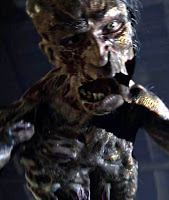 But just consider the vast numbers of myths our ancestors lived in fear of, wherein terrifying, unstoppable predators lurked just beyond the edges of human society.
But just consider the vast numbers of myths our ancestors lived in fear of, wherein terrifying, unstoppable predators lurked just beyond the edges of human society.It’s not just werewolves, but vampires, ogres, trolls. In the poem Beowulf, Grendel (left) was a blueprint serial killer. In Jack the Giant Killer, Cormoran raided Cornish farming communities, taking lives and livestock at will. What about the Ango-Saxon ‘sceaudagenga’ (or shadow-man), who lurked deep in the forest, and if you met him, you’d never be coming home?
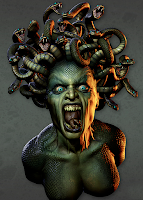 Even foul figures of of classical mythology, like the Minotaur and Medusa (left), possessed recognisably human characteristics, despite the horrors they wreaked. When you think how many monsters of this type were believed to inhabit the fringes of the Ancient World, to the terror of isolated, ignorant communities, you can’t help wondering if, in truth, an exceptional number of serial killers were hard at work.
Even foul figures of of classical mythology, like the Minotaur and Medusa (left), possessed recognisably human characteristics, despite the horrors they wreaked. When you think how many monsters of this type were believed to inhabit the fringes of the Ancient World, to the terror of isolated, ignorant communities, you can’t help wondering if, in truth, an exceptional number of serial killers were hard at work. Perhaps the only difference between then and now is that these days we can put names and faces to the monsters – eventually. Not that it makes us any the less afraid of them.
THRILLERS, CHILLERS, SHOCKERS AND KILLERS …
An ongoing series of reviews of dark fiction (crime, thriller, horror and sci-fi) – both old and new – that I have recently read and enjoyed. I’ll endeavour to keep the SPOILERS to a minimum; there will certainly be no given-away denouements or exposed twists-in-the-tail, but by the definition of the word ‘review’, I’m going to be talking about these books in more than just thumbnail detail, extolling the aspects that I particularly enjoyed … so I guess if you’d rather not know anything at all about these pieces of work in advance of reading them yourself, then these particular posts will not be your thing.
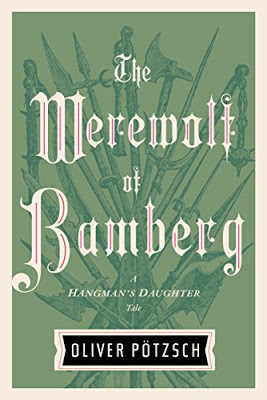 THE WEREWOLF OF BAMBERG
THE WEREWOLF OF BAMBERG by Oliver Potzsch (2015)
It’s the 1660s, and Schongau hangman, Jakob Kuisl, and his family arrive at the forest-begirt town of Bamberg, Bavaria, to celebrate the wedding of his estranged brother (and local hangman), Bartholomaus. A happy event is in prospect, Jakob’s beautiful and spirited daughter, Magdalena, hoping that her father and uncle will at last make friends and put behind them the mysterious event that split their family apart during their youth.
But all is not well in Bamberg. A series of ghastly murders is in progress, the unknown assailant horribly mangling the victims and scattering their dismembered body-parts. It hasn’t taken long for rumours to spread that a werewolf is on the prowl, though Jakob and Magdalena – a father-and-daughter crime-fighting team (there have been four ‘Hangman’s Daughter’ books before this one) – come to dispute this, noting that most of the gory fragments were severed from the original bodies cleanly rather than torn with tooth and claw.
A werewolf with a blade? It seems unlikely.
Even more suspiciously, some of the victims, the vast majority of whom are drawn from the town’s patrician class, show marks of the rack and branding-iron.
A werewolf who abducts and tortures his victims before tearing them apart? It seems even more unlikely. But Bamberg is not a town where rhyme and reason exist in abundance. Still haunted by the events of forty years earlier, when a far-reaching witch trial saw hundreds of citizens, most of them innocent, tortured and then burned at the stake, fear and superstition are rife in the flea-infested hovels and narrow, stone-arched streets. The townsfolk aren’t even sure what form their adversary takes: is it a man/wolf hybrid, a warlock who can turn himself into an actual wolf; or a maniac wearing a pelt? – whichever the case, they are certain it’s a creature of the Devil, and that it must be destroyed, along with all its spawn.
Jakob undertakes to investigate the crimes, aided very efficiently by Magdalena, her educated husband, Simon, and his close friend and local physician, Master Samuel. But the situation worsens when Sebastian Harsee, suffragan bishop of Bamberg, sees advantage in stirring up these fears because if terror of the darkness brings the townsfolk closer to God, it can only empower his own position. Further complications then arise when a dangerous hunting dog gets loose outside the city (and this predator does leave his victims mauled and ripped), by an outbreak of rabies (an illness misunderstand by the medical science of the time, and the sufferers of which snarl and froth at the mouth), and by the escape from the prince-bishop’s menagerie of a baboon (a completely alien creature to most Germans of this era).
As the attacks continue, hysteria increases, and accusations fly everywhere. Meanwhile, Jakob and Magdalena find themselves with many suspects to consider. The hideously scarred Jeremias, custodian of a local tavern, is a friendly enough soul, so much so that Magdalena will happily leave her two children in his care, but increasingly, it seems, he has odd and ghoulish interests, and his past is another one that is shrouded in mystery. Aloysius, a solitary individual, both looks and smells like the hunting dogs he tends; he is an odious individual, whom Jakob instinctively dislikes. Then there is Bartholomaus, Jakob’s own brother. The deep enmity between these two partly stems from the fact that, when they were boys, Jakob never wanted to follow their father into the hangman trade, while Bartholomaus, a keen student of the most brutal forms of punishment, positively looked forward to it.
The case finally turns deadly for the Kuisl family themselves, when Barbara, Magdalena’s younger sister, falls for handsome young actor, Matheo, who is part of a travelling troupe visiting the town, only to see him clapped in irons as a suspect. In this case, the evidence is actually rather good. Items associated with black magic are found among the actors’ possessions, along with a number of wolf-skins. Also suspected, Barbara goes into hiding in company with the troupe’s depressed resident-writer, Markus Salter – as much from the baying mobs rampant in the city as from the actual authorities – but it’s clearly only a matter of time before she’ll be found. If Jakob wants to save his daughter from a terrible death, he knows he must crack the case very quickly indeed …
I’d never encountered the Hangman’s Daughter stories before, so it probably wasn’t ideal to come in at volume five. It didn’t spoil my enjoyment of The Werewolf of Bamberg , but I must say – this is one of the strangest novels I’ve ever read.
First of all, it’s an excellent recreation of a turbulent age, a time when the brutality and mysticism of the Middle Ages is slowly and reluctantly giving way to the Enlightenment, but an era when Western Europe is still the epitome of the Third World. Real skills of any sort, unless they are connected to violence and death, are in short supply. Education is thin on the ground. Personal wealth is something to be defended at all costs, but life in general is cheap. Most crimes, even petty ones, are punishable by death or at least a severe whipping. Trials might hinge on the reputation of the accused rather than factual evidence. Some occupations are held to be vastly less honourable than others, including, amazingly, the medical profession. Despite it being an age of faith, basic moralities are skewed, community leaders, including senior churchmen, setting a very poor example with their many and varied vices.
This attention to authentic historical detail is fascinating, invoking a different and distinctly non-chocolate box picture of the near-distant past. I was utterly absorbed in it – much more so, sadly, than I was by the actual mystery.
Oliver Potzsch does an impressive job of setting up a whole range of suspects, while the essential back-story – a political stitch-up of epic proportions – is effectively drizzled through the narrative rather than thrown at us in one lump of exposition, but the pace at times is wearisome. This may partly be down to losses in translation, though I’m not sure it is. Lee Chadeayne does a sterling job of bringing The Werewolf of Bamberg from German to English, leaving us with a very readable text, but there is an awful lot of repetition here, and that must be part of the original writing. I soon got tired of seeing Jakob and Bartholomaus quarrelling over nothing or hearing that the occupation of executioner is badly thought-of (and why would that surprise or outrage anyone?). As such, the novel overall is perhaps twice as long as it needs to be.
In addition, it’s a personal belief of mine that too many characters can get in the way. Jakob and Magdalena are the stars of the book, or they would be if their contributions weren’t obscured by what amounts to an ensemble cast, all of whom jockey for prominence; in fact, so many are the named personages in this book that at times it’s a real challenge keeping up with everyone and remembering what they are doing.
My other main complaint is about Jakob Kuisl himself. I like him as a character – a gruff, middle-aged man who doesn’t look after himself is a rare delight in hero terms – but find it difficult buying into the conceit that, though he’s a long-serving hangman, he feels sorrow for his victims and often acts to reduce their pain. Wouldn’t he get sacked for doing that, or maybe worse? What’s more, when this approach fails, he consoles himself with the knowledge that he’s merely a cog in an unjust machine and that it’s never his personal fault. All very well, but when you consider that his duty has seen him not just string felons to the gallows, but burn them at the stake, break them on the wheel and draw and quarter them between teams of horses, his oft-expressed disgust at those other executioners, his brother for example, who are consciously vicious, rings a bit hollow to modern ears.
But all that said, I stuck with it to the end. So, while I wouldn’t call The Werewolf of Bamberg a real page-turner, its atmosphere and tone did more than catch my interest. In addition to the historical angle, I’ve long been a sucker for werewolf stories, and even though it becomes apparent early on that we’re not dealing with a werewolf here, but a serial killer, it is clearly based on the real-life mystery of the Werewolf of Bedburg, and we still find ourselves on dark, winding streets with a horrific menace stalking us through the shadows. In that regard, it’s as effective a horror story as it is a thriller and having a foot in both these camps is not always a bad thing.
I recommend it to all dark fiction fans, but at more than 600 pages you’ll need plenty time in which to read it.
As usual – purely for the fun of it – here are my picks for who should play the leads if The Werewolf of Bamberg is ever adapted for English-language film or TV (but I still think the main concept would be a tough sell for a modern audience):
Jakob Kuisl – Liam NeesonMagdalena Fronwieser – Cosma Shiva HagenBartholomaus Kuisl – Danny WebbSimon Fronwieser – Martin FreemanMaster Samuel – Oded FehrJeremias – Rutger HauerSebastian Harsee – Gary OldmanMarkus Salter – Iwan Rheon
(We’ve used a lot of pictures today, including several original, rather grotesque woodcuts, but also a magnificent shot of Inner Iceland by Albert Dros, and a startling werewolf pic which I found floating around online and will be happy to give a credit for if anyone knows who the creator is. The same applies for the image of Medusa, while the image-grab of Grendel comes from the 2007 movie, Beowulf).
Published on February 20, 2019 04:02
January 31, 2019
When crime thrillers push it to the limit
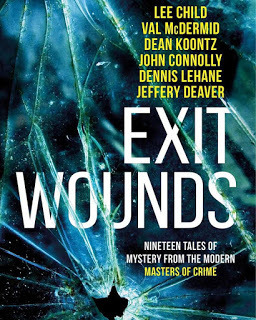 Today, I’m going to be talking about the darkness at the heart of the atypically violent or hard-edged crime novel, always assuming there is darkness at the heart of it – which is a question we’ll need to answer if we can.
Today, I’m going to be talking about the darkness at the heart of the atypically violent or hard-edged crime novel, always assuming there is darkness at the heart of it – which is a question we’ll need to answer if we can.On a not dissimilar subject, I’ll also be reviewing and discussing Dale Brendan Hyde’s grisly and disturbing debut novel, THE INK RUN. It was only published in 2018 and it’s already attained cult popularity, but good grief, it’s a tough read at times – you’ll need the strongest stomach possible.
If you’re only here for the Dale Brendan Hyde review, you’ll find it as usual at the lower end of today’s blogpost. Don’t hesitate to get straight on down there (and when you’ve finished, let me know what you think – it is a discussion as well as a review, after all).
Before any of that, though, check out the picture topside.
EXIT WOUNDS is an anthology of new crime writing from Titan Books, edited by Paul Kane and Marie O’Regan, which I’m very proud to be part of. My short story, The New Lad , will be gracing its pages. But if that’s not sufficient reason to buy it, look at some of the other (real) heavyweights involved: Lee Child, Dennis Lehane, Dean Koontz, Val McDermid, John Connolly, Joe R Lansdale …
You can’t go far wrong there, I’m sure you’ll agree.
EXIT WOUNDS is published on May 21 this year but is already available for pre-order. (In fact, don’t let reading this blog delay you – buy it NOW; you know you won’t regret it).
Dark at heart
My new novel, STOLEN , which is also my last novel for Avon Books, is published on May 16. It’s a third outing for DC Lucy Clayburn, and along with the usual grotty urban world through which our tired police heroine must make her way, it deals with several especially grim subjects: animal cruelty – to a hideous degree; ultra-violent attacks on the homeless; and the mysterious abduction of several OAPs.
I think that when writing this book, probably more than any other, I became acutely aware how thin the line is between what must be deemed a necessary portrayal of human barbarism and the infliction on readers of self-indulgent gore so graphic that it verges on titillation.
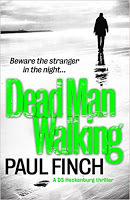 Now, I’ve been censored before – by my own editors, before anyone asks. They dug their heels in with
DEAD MAN WALKING
, when a scene which originally depicted a decapitation by garden shears was replaced by a simple throat-cutting. Likewise, there was some concern about an attempted rape in
SACRIFICE
, and some of the choice, non-PC language used by seasoned police officers in my most recent Heck novel,
KISS OF DEATH
. In both the latter cases, after due consideration, and some minor trimming, the original passages were allowed to stand because a decision was reached that they weren’t OTT, but were simple representations of real life, albeit real life on the seedy and sordid side.
Now, I’ve been censored before – by my own editors, before anyone asks. They dug their heels in with
DEAD MAN WALKING
, when a scene which originally depicted a decapitation by garden shears was replaced by a simple throat-cutting. Likewise, there was some concern about an attempted rape in
SACRIFICE
, and some of the choice, non-PC language used by seasoned police officers in my most recent Heck novel,
KISS OF DEATH
. In both the latter cases, after due consideration, and some minor trimming, the original passages were allowed to stand because a decision was reached that they weren’t OTT, but were simple representations of real life, albeit real life on the seedy and sordid side. With all that in mind, it’s surprising that some things I’ve written were not questioned. A full bodily impalement (lengthways) in
SACRIFICE
, for example. Heck’s beating and framing of a known hoodlum to gain information in
ASHES TO ASHES
. Or the so-called ‘Stranger’ in
DEAD MAN WALKING
, a serial killer whose victims suffered attacks to the eyes with sharpened pencils. Book editors are all different, of course, each one having his or her own limit of permissibility.
With all that in mind, it’s surprising that some things I’ve written were not questioned. A full bodily impalement (lengthways) in
SACRIFICE
, for example. Heck’s beating and framing of a known hoodlum to gain information in
ASHES TO ASHES
. Or the so-called ‘Stranger’ in
DEAD MAN WALKING
, a serial killer whose victims suffered attacks to the eyes with sharpened pencils. Book editors are all different, of course, each one having his or her own limit of permissibility.But needless to say, with the three areas I’ve mentioned with regard to the latest Lucy Clayburn book, STOLEN , there have been a few tense exchanges of views. In the end I have made some cuts, but on the whole the admittedly horrific subject-matter remains intact. I guess I successfully tabled the argument that the grimness of the situation needed to be addressed fully. I particularly wanted to show, and indeed I have always sought to show, just how onerous the average police officer’s day-to-day experiences can be.
As a psychologist friend once said to me: ‘The coppers I deal with are often as traumatised as war veterans. They don’t just deal constantly with death, cruelty and danger, but every time they go to work, they meet numerous people for whom it is the very worst day of their lives. That has a massive impact on them after a while.’
Another friend once said to me (though this was many years ago): ‘I wish you’d never become a police officer. It’s made you all hard and horrible.’
Well, there you have it … the cause and the symptom.
As such, it would feel very disingenuous of me to write my cop novels now and not be true to the reality of the police experience (and presumably the experience of those others involved in that world, the offenders too). If there is a darkness at the heart of crime fiction – successful crime fiction, at least – perhaps it’s that unedifying truth.
Maybe that’s why the horror genre has suffered more when it comes to censorship than the thriller genre. Because ultimately, it’s seen as fantasy and so is not taken as seriously.
 In the age of the video nasties, with a wide range of horror material like
The Burning
,
SS Experiment Camp
and
Cannibal Holocaust
(much of it crass, exploitative and embarrassingly low-budget, though the official list also included movies now regarded as horror classics, like
The Exorcist
,
Suspiria
and
The Texas Chainsaw Massacre
) forcibly removed from the shelves, other uncompromisingly gritty, adult-themed movies, for the most part urban thrillers –
Taxi Driver
, for example,
Death Wish
, Get Carter and
Prime Cut
– were immediately hailed as the all-time-greats we regard them as today. Primarily, I again suspect that’s because the thriller medium is seen as portraying a form of truth.
In the age of the video nasties, with a wide range of horror material like
The Burning
,
SS Experiment Camp
and
Cannibal Holocaust
(much of it crass, exploitative and embarrassingly low-budget, though the official list also included movies now regarded as horror classics, like
The Exorcist
,
Suspiria
and
The Texas Chainsaw Massacre
) forcibly removed from the shelves, other uncompromisingly gritty, adult-themed movies, for the most part urban thrillers –
Taxi Driver
, for example,
Death Wish
, Get Carter and
Prime Cut
– were immediately hailed as the all-time-greats we regard them as today. Primarily, I again suspect that’s because the thriller medium is seen as portraying a form of truth.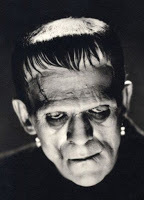 But it’s not simple by any stretch of the imagination. The Dirty Harry movies, hardcase crime thrillers of the old school, were seen as divisive and even accused of being ‘fascist’ at the time of their release, while, if memory serves,
Straw Dogs
– the original version– was also banned in the UK.
But it’s not simple by any stretch of the imagination. The Dirty Harry movies, hardcase crime thrillers of the old school, were seen as divisive and even accused of being ‘fascist’ at the time of their release, while, if memory serves,
Straw Dogs
– the original version– was also banned in the UK.All this shows is that there has long been heated debate about violence on film, and even violence within books. Both the original novel Frankenstein , published in 1818, and the 1931 movie starring Boris Karloff, caused outrage in certain quarters. It goes on just as heatedly today. Quentin Tarantino can’t release anything without it attracting controversy for its inevitable gruesomeness (and that’s even though Tarantino increasingly leans towards the comic-strip). In the world of literature, there are demands that violence against women in particular be toned down; earlier this year, and this is the first time I’ve ever heard about something like this, the Staunch Prize was offered to authors of novels in the thriller genre ‘in which no woman is beaten, stalked, sexually exploited, raped or murdered’ (though in the age of the #MeToo movement, this may be a slightly separate issue).
So, as a writer of crime thrillers (and horror, from time to time) where do I stand on banning and censoring and excessive editing?
It’s difficult to be sure, because there are no easy solutions.
I know my books are dark, and I make no apologies for that. Maybe I can comfort myself with the notion that when I write hardcore crime, I’m only telling the truth about the way things are. But I’m also aware that it’s a truth not everyone wants to hear. The counter-argument to that might be that if they don’t want to hear it, they don’t have to buy the book. And yet in the same breath I must admit that I want as many people as possible to buy the book.
What a conundrum.
I don’t know what the answer is. Ultimately, as a writer, you’ve just got to say things as you see them. I can’t write cop stuff that isn’t down, dirty, violent and frank. Because that was my experience doing the job. I can’t talk about psychopaths without highlighting the destruction they cause, though I think (or hope) that I can do it in a non-salacious way.
It’s interesting, though, isn’t it? The above paragraph alone suggests that I’m probably thinking about it more now than I ever used to. Is that the wisdom of age kicking in, or has the disapproval of editors who’ve occasionally had to rein me in finally left its mark?
Seriously, who knows?
THRILLERS, CHILLERS, SHOCKERS AND KILLERS …
An ongoing series of reviews of dark fiction (crime, thriller, horror and sci-fi) – both old and new – that I have recently read and enjoyed. I’ll endeavour to keep the SPOILERS to a minimum; there will certainly be no given-away denouements or exposed twists-in-the-tail, but by the definition of the word ‘review’, I’m going to be talking about these books in more than just thumbnail detail, extolling the aspects that I particularly enjoyed … so I guess if you’d rather not know anything at all about these pieces of work in advance of reading them yourself, then these particular posts will not be your thing.
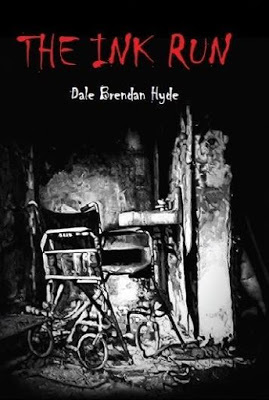 THE INK RUN
THE INK RUN
by Dale Brendan Hyde (2018)
Schoolboy, Otiss, lives a life that is beyond ghastly, trapped in a sordid existence of inner-city squalor and non-stop parental violence. You may think you know about this kind of thing, and that you’ve heard it all before – but if you want my honest opinion, I sincerely doubt it.
Because the story of Otiss Kites takes it way past anything that you’d imagine an ordinary human being could survive. And I suppose one of the big questions from very early on in the novel is … will Otiss survive?
His main problem, from the outset, is not so much his impoverished life in a decayed corner of the post-industrial North in the uncaring 1970s (though that hardly helps), but his father, Stan, who is not just a drunk, a druggie and a bully, but an out-of-control psychopath and calculating sadist, whose pitiless cruelties verge on the utterly deranged.
For example, on one occasion, he makes his son wash up, having deliberately failed to mention that the dirty water in the sink is full of broken glass. On another, he insists on combing his boy’s hair with a cactus plant. On another, he uses the young un’s toothbrush to clean the toilet bowl (and doesn’t tell him, in the hope that he will brush his teeth afterwards). On yet another, he ties the youngster’s genitals tightly with thread, and then forces him to drink jug after jug of water, denying him any relief. And none of this is the worst of it.
But none of these horrors – which are all done casually and often on a whim (and are nearly always accompanied by roaring, mocking laughter) – can compare to the clever but heinous plan that Stan, not quite the unthinking, toothless brute we are initially led to believe, has really got cooking.
Before we move onto that, it’s essential to consider some of the other characters in young Otiss’s terrible life, not all of whom are total negatives.
For example, he isn’t entirely friendless. His pal, Johnny Sand, suspects that Otiss is being brutalized at home, but can’t really guess at the full extent of it, and at the end of the day can only offer a youthful shoulder to cry on and a few books for his long-suffering school-mate to read. Otiss also pays regular but secret visits to his ailing grandfather, a one-time bare-knuckle boxing champion known as Poleaxe Pedley, but again, the old man is limited in how much comfort he can provide. Despite that, these are about the closest experiences Otiss ever has of normal, caring human relationships. He also finds some solace in the construction of a crude raft and the many hours he spends floating on it in the middle of an abandoned mill-pond, slipping through dream-states as he yearns intensely for a better life. But ultimately none of this will protect him day-to-day.
Someone who maybe could, but doesn’t even try, is Tish, his weary, alcoholic mother.
While a key part of the misery he encounters hourly – mainly because she allows it to go on, but also because, though she doesn’t quite abuse her son the way his father does, she also neglects him (in one heart-rending scene stepping without comment over his beaten-up body while heading out to work) – Tish is more of a disappointment than anything else.
Otiss is certain that she’d be less callous and more concerned for him if his father wasn’t there, though I suspect this owes to wishful thinking rather than reality, because while it is Otiss suffering the brunt of the violence, Tish – who’s been thoroughly victimized herself in the past (and can only unburden herself of this by shrieking insanely at the door several minutes after Stan has gone out) – is simply glad that it’s not her, which implies a degree of selfishness that can probably never be reversed. (She also, on one occasion, turns her rings around when slapping Otiss, to cause maximum damage, even Stan moved to compliment her for using their son’s blood on her fingernails rather than polish ... so, some hope of this witch ever finding her maternal side!).
On the subject of Tish, we now come back to Stan’s real plan – and don’t worry, this isn’t a give-away because it happens relatively early in the narrative.
Stan regularly plays around with other women – pretty unimpressively on one occasion, when Otiss gets to spy on him – and, soon deciding that he can do without Tish in his life, opts to plot her demise, a decision fuelled by the desensitising effects of hulk weed, which the guy smokes increasingly regularly, despite it being a much stronger form of cannabis than the norm. An opportunity to finally start this ball rolling arises when Otiss, who, unsurprisingly, among various other mental aberrations, takes to sleep-walking. Stan frog-marches him to the doctor, adding the lie that the lad is showing increased aggression towards his mother. Otiss is bemused by this, but no more than that. Then, in a later incident, when Otiss mistakenly thinks that Stan has bitten Tish’s throat out, he urges a neighbor to call the police, only to find the whole thing a set-up designed to make him look like a liar and trouble-maker.
So, that’s now two authorities – the NHS and the cops – who are starting to earmark the youngster as a dangerous oddball.
Perhaps inevitably, not long after the neighbour who called the fuzz has mysteriously died (murdered by Stan for sure, Otiss decides), Tish also meets her end, thrown down the cellar stairs with such savagery that she breaks her neck.
And it’s from this point in the book that Otiss’s life, which, if he thought it was bad before, now plunges dramatically downward, literally into Hades itself.
Found hiding in the attic (hiding from Stan, though the police don’t realise this), Otiss – who’s now a teen and therefore can carry the can – is arrested. Stan’s portrayal of a distraught and despairing spouse appalled by the behavior of his wayward son is Oscar-worthy, and completely wins over the investigating officers, who then use various brutish means to coerce Otiss into signing a confession that he murdered his mother, leaving little hope for him. As a countermeasure, his solicitor, Liberace ‘Liberty’ Kerty, work up a defence of ‘diminished responsibility on the grounds of automatism’ – in other words, Otiss did the foul deed while he was actually asleep – which the judge at the special hearing reluctantly accepts.
Otiss is thus ordered to be detained for a decade under the Mental Health Act, and dispatched to the Faberon institute, a place for the criminally insane that would grace any Batman movie. It all looks modern and professional on the outside, but Otiss quickly suspects this is a front, and he’s correct, because on the inside, he finds himself entombed in an even more abusive environment than his home, confined to an austere, dungeon-like cell, surrounded by maniacs – both patients and staff alike, it seems – and subjected to a trial programme of old-fashioned ‘cure-all’ methods.
These include beds with thick straps on them, heavy and constant medication, padded rooms, electro-shock therapy, and even injections behind the eyeballs.
Yet again, we wonder if it’s even remotely possible that Otiss can survive this ongoing cascade of horrific abuse for the next ten years. And if he does, what kind of adult will finally emerge when the hospital doors are slammed behind him. How will he get his jollies back in the ordinary world then, we wonder, and what in particular will all this mean for the one person whom Otiss has sworn to kill before all others, even though it’s someone who, deep down, he still fears greatly: his own dear ‘Da’, Stanley Kites? …
Lots of crime writers describe domestic abuse and the violence and torment suffered by the young and helpless without, in truth, having ever experienced it at first-hand. Dale Brendan Hyde, who by his own admission, had a troubled early life, may not have experienced it either – at least not to this extent (dear God, I hope he didn’t!). But he certainly writes as if he did. Be under no illusion, The Ink Run is savage stuff from beginning to end, one of the darkest – if not the darkest – novel that I’ve ever read.
At least part of that stems from the author’s unwillingness to hide anything. The reader is right there, on the spot, for near enough every minute of Otiss’s agony. Even the sexual torture is unstintingly displayed. It also stems from our awareness that suffering of this sort is all too real in our world, maybe even in the next street to the one where we live, the perpetrators often able to conceal it from prying eyes and to present a façade of decorum in its place, the rest of us helping this along by pretending that it isn’t going on (because, in truth, we can’t even stand to think about it).
In fact, façades – the pretense of cultured normality – are a big issue in The Ink Run .
Stan Kites, the main villain, despite belonging in a lunatic asylum himself, is able to keep on pretending that he’s innocent even when there is glaring evidence that he’s a degenerate, drug-addled bully. Lazy and incompetent police officers pretend that they’re doing their job even though some of them must at least suspect that Otiss is a victim and his father a wrong ’un. A prejudiced legal system pretends that it has a heart – though it doesn’t pretend very hard in the case of Judge Yama! – by sending the mentally unfit for care rather than punishment, even though unaware and uninterested in what that ‘care’ actually entails. The Faberon hospital pretends that it’s a respectable establishment, while behind its grim walls, medieval methods are employed to forcibly drive mad men sane.
Author Dale Brendan Hyde has other subtexts too. He seems to be almost indecently fascinated by the debasement of the human body and soul. But then that is the key to one of the big questions this book asks: what is the correct response to endless, systematic mistreatment? When you are so wronged, and even the state appears to be in on it (thereby offering no hope of justice!), is ‘morality’ a word that even has meaning anymore? Surely you are justified in retaliating violently yourself? Or are you? Doesn’t that make you as bad as them? Or does none of that bloody matter when it’s all about making something right, at least for you personally?
These are difficult questions for the reader to ponder, let alone answer, after protracted immersion in a narrative this grotesque. Many will opt for the easy and obvious response: do it to them before they do it to you. The cover of the book almost encourages this with its stark message:
You can’t escape your DNA
But that’s a little bit tricky in itself.
If it’s in your DNA, it’s inevitable, isn’t it? It doesn’t matter what you think. Otiss will do as Stan did, because his genes are quite simply bad. Which means that violent criminality is more about nature than nurture.
Well, I’m not sure Dale Brendan Hyde believes that. Otherwise, I doubt he’d have written this novel. And indeed, though ultimately all semblance of happiness is finally snuffed out for Otiss – ironically, when he’s taken into ‘care’ – throughout his formative years there are rays of hope for him to cling to. The books that Johnny Sand gives him provide occasional enlightened insights into the human condition, which he can’t glean from his normal life. At the same time, his grandfather is the living memory of a very different kind of tough, working class male; a man of violence, yes, but also a man of honour, whose bare-knuckle exploits were conducted in chivalrous fashion. That better life Otiss dreamed about on his raft was out there; he just couldn’t reach it.
So, while The Ink Run is very violent and gruesome, at times almost to a point where you need to put the book down, it has serious, meaningful depths. Be under no illusion. This is not some just some slice of lascivious goreography.
It’s also an amazing read purely because of the sheer quality of the writing.
It’s a big tome, clocking in at nearly 400 pages, and densely written, but it comes at you rapid-fire. And it’s a compelling story, a real page-turner.
I initially had some reservations when I saw that it was written in a kind of vernacular, and littered with purposeful misspellings and grammatical errors, even though I understood that this was to convey young Otiss’s only semi-educated state. But as the narrative gripped me, and that happened very quickly indeed because it thumps along at pace, none of this came to matter anymore.
Dale Brendan Hyde is a talented wordsmith, who has worked tirelessly at his craft. He writes near-hallucinogenic prose, darkly and dingily poetic, and highly visual. He also packs this debut novel of his with harsh detail gleaned from his own background, his days as a young hoodlum and the jail time he served, enriching the whole novel with an air of authenticity that other crime writers can only dream about.
It’s all the more remarkable an achievement, of course, because of that difficult start in life. It doesn’t surprise me that Hyde has given interviews in which he pays tribute to authors like Jimmy Boyle ( A Sense of Freedom ) and Noel ‘Razor’ Smith ( A Rusty Gun ), who turned their backs on lives of crime by opting to write instead, citing them as a huge influence on his personal reformation.
He certainly does those guys proud with The Ink Run . It’s a challenging book, make no mistake, and you’ll need to tough it out – at times you’ll think you’re reading horror rather than crime. But again, this is what it’s meant to be. It’s a slap in the face, it’s been purposely written to knock us all out of our comfort and complacency. It deals with real, serious issues. And for that reason alone, it needs to be read widely. But if you take the chance, I guarantee you won’t be disappointed. This is an astonishing debut.
At the end of these book reviews, I often like to indulge myself in a bit of fantasy casting, imagining that the book is being adapted for film and TV and nominating those stars who I think would make it live and breathe on screen. I’m not going to do that here for the simple reason that known names would get in the way. If done properly, The Ink Run would be as tough, gritty and unforgiving a piece of cinema as anyone has ever seen, and I suspect that only a cast of unknowns could make that happen effectively (look at Ken Loach’s movies, if you want the living proof). Even so, I hope it gets made at some point. And if it doesn’t hold back, the way Dale Brendan Hyde refuses to hold back on the written page, it would be a major event indeed.
Published on January 31, 2019 14:51
January 9, 2019
My own gazetteer of strange, eerie places

Today, I’m taking advantage of a photo-gallery idea I recently had.
It came from a question someone asked me: what are the most amazing places in Britain that you’ve ever written about? Now, that’s not an easy one to answer. I mean, define ‘amazing’. But it certainly struck me that it would be fun to contemplate the most scary and mysterious places that I’ve ever written about … or more importantly, that I would LOVE to write about but haven’t thus far.
So, that’s what today’s blogpost is all about.
I’m going to take you on a whistle-stop tour of the top ten weirdest/eeriest real-life places in Britain and Ireland that I would love to take my fictional characters to in either my crime-thriller novels or my horror stories. And, as an added bonus – and why the hell not? – I’m also going to show you my top ten weirdest/eeriest real-life places that my fictional characters actually HAVE visited.
Somewhat in keeping with that theme, I’ll also be offering a detailed review and discussion of Rosemary Pardoe’s compelling new anthology, THE GHOSTS & SCHOLARS BOOK OF FOLK HORROR .
If you’re purely interested in the review, fair enough, You’ll find it, as always, at the lower end of today’s post. Just scoot on down there right now. However, if first you fancy checking out a few remote corners of Britain and Ireland where folkloric type chills are said to manifest in real life, then stick around for a bit …
British and Irish Top 10 spooky spots where my fictional characters may fear to tread, but where they’re going to tread at some point, like it or not …

The uncanny, ankle-breaking moonscape of the Burren in County Clare, Western Ireland. A glaciated georama, it visually embodies spookiness. Even Oliver Cromwell said of it ‘a country where there is not water enough to drown a man, wood enough to hang one, nor earth enough to bury one’. I’m sure that some thriller/horror writer has dealt with it before, though I haven’t personally, and I’d love to get there at some point.
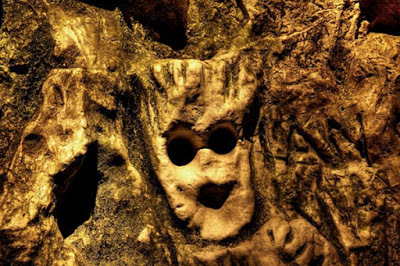
The Hellfire Caves in the Chiltern Hills near High Wycombe, Buckinghamshire. A tourist attraction for many years now, they have a genuine arcane history, having played host to Francis Dashwood’s infamous Hellfire Club of the 18th century, which saw drunken reprobates from the local aristocracy indulge in orgies, black magic and even (allegedly) human sacrifice. If I ever do manage to set some fiction there, I’ll be late to the party as Hammer Horror beat me to it years ago, having filmed To the Devil a Daughter there back in 1976.
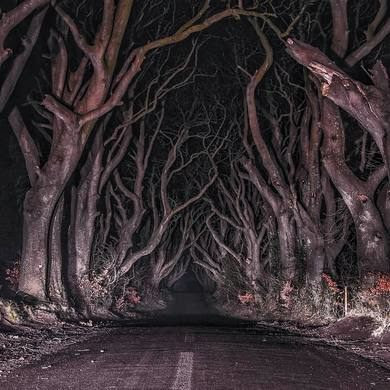
Possibly the world’s most famous avenue of beech trees, the Dark Hedges, which run along the Bregagh Road near Armoy in Country Antrim, Northern Ireland. HBO’s Game of Thrones has immortalised this remarkable sight, making it into a world-famous tourist attraction, which probably renders it useless for my purposes now – it’s only a road at the end of the day, but Hell, what a road! It could so easily be a movie set, but it’s a genuine piece of nature, the trees first planted in 1775.

Now a deceptive one. This is the idyllic Blue Lagoon in the hills near Buxton, Derbyshire. Looks gorgeous, doesn’t it? Fancy a dip on a nice summer’s day? Well … best not to, because the water is only that lush blue colour thanks to being toned blue by toxic chemicals leaching from the surrounding rocks. Plus, it’s not a lagoon or even a lake, it’s a flooded quarry which just beneath the surface is filled with car wrecks, dead animals and human excrement. It has no esoteric history as far as I know, but it’s just so damned nasty that I can’t ignore it forever. (As a footnote, it’s recently been dyed jet-black to stop people swimming).

Back in the world of folklore and fable, the Beetham Fairy Steps, on the border between Lancashire and Cumbria, offer chilling false promises. They’re a natural rock formation, unless you believe the rumours that the faeries carved them. If so, and you venture down, making a wish en route, and manage not to touch the sides before you reach the bottom, your wish will supposedly be granted. But ensure that a so-called shade is not coming up at the same time; a dark form with glowing eyes – encounter this and it means you are doomed to die very soon.

Further south in my home county of Lancashire, we have Pendle Hill, notorious for the 12 female inhabitants of the region accused of causing death by witchcraft in 1612, tried for their lives and then (ten of them, at least) hanged. It’s a bleak, windswept place, undeniably eerie on desolate autumn days, but it’s beautiful too in a wild wilderness kind of way. At least part of its evil reputation stems from visitors venturing up there on dark Halloween nights, losing their way and falling down ditches and into gullies. I’ve written many times about rural Lancashire, but never about Pendle Hill itself.
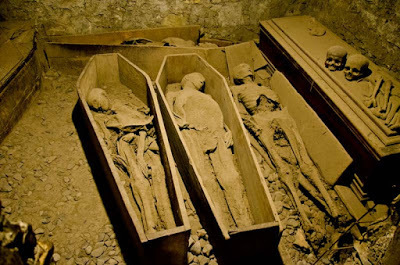
There aren’t many places in the British Isles where you can shake hands with an 800-years-old mummy, but the crypt of St Michan’s Church, Dublin, is one. Believe it or not, a legal glitch enables visitors to have physical contact with certain of these dried-out, 11th century corpses, as Church Law only forbade the opening of the caskets, not the touching of their contents – and the caskets have collapsed themselves, whereas natural chemicals in the walls are believed to have preserved the bodies. Rumour holds that Bram Stoker was first inspired to write about the undead after visiting this nightmarish place.

High in the Yorkshire Dales lies Trollers Gill, wherein strange deaths have been recorded since the 14th century. The name of the gorge hints at early stories that trolls would lie in wait along the top and throw heavy stones down on anyone passing below – and indeed there are reports of lone travellers who have died under falling rocks. Meanwhile, the Gill is most famous for the Barghest, or ‘hill ghost’, a terrifying demon dog, said by some to have been brought here by the Danes as a mythological weapon of mass destruction. One glance from its fiery eyes is certain death. (The image is by Matt O’Brien).

There’s surely no more picturesque nor more tragic a place in Britain than Glen Coe in the Scottish Highlands. Featured in many movies because it is quite simply beyond beautiful, it’s also the scene of bitter betrayal and foul, bloody murder. Little wonder that when night falls and the mist rolls down the hillsides, the shadowy forms of the massacred MacDonalds – callously slain in 1692 by the same government forces they had recently fed and sheltered – are said to roam the silent glens. (The image comes to us from Travels with a Kilt).
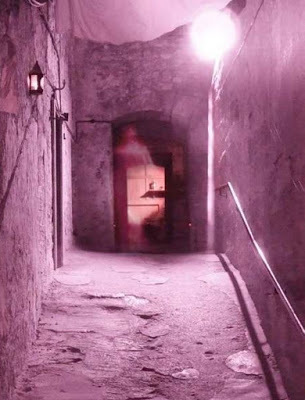
The spectacularly spooky Mary King’s Close underneath Edinburgh’s Royal Mile. Said to be rife with ghosts, this fascinating visitor attraction comprises several streets remaining from the 17th century, which were simply buried under new architecture in the 18th and eventually forgotten. Rumours abound that murder victims and plague sufferers still haunt its claustrophobic confines, while it’s now been proven that the Close once ran alongside the Nor Loch, a mini lake into which the city’s sewers discharged, leaving it so vile and polluted that it gave off poisonous fumes. Surely, no writer on the dark side can resist underground Edinburgh for long? But just in case you think you can, look more closely at the picture. Is that an hallucination caused by foul gas … or an honest to goodness spectre? (The image comes to us from the Real Mary King’s Close ).
British and Irish Top 10 spooky spots where my fictional characters have already trodden …

No, not the entrance to Mordor, but Castle Crag at the north end of Borrowdale in the Lake District. In my 2014 thriller novel, DEAD MAN WALKING , I transplanted it, cairns and all, to the Langdale Pikes. You may recall that Heck followed it up through thick fog to a ghastly ruin of a house, where something very nasty awaited him. (Picture by Tim Parkin).

Red Sand Towers, a World War II anti-aircraft emplacement still standing in the Thames estuary in Kent. I renamed it Blacksand Tower for my 2013 thriller novel, STALKERS . Anyone who read it may recall that Heck was marooned there at the mercy of a psychotic hitman.

Wicken Fen in Cambridgeshire. An extensive spread of marsh, broad and reedbed mostly owned by the National Trust. It doesn’t look too scary, but there are many fenland myths attached to it – lantern-men, witches, black dogs, and the fearsome, vampire-like mere-wives. I went all out to make it as scary as possible in my aptly-titled horror story of 2012, Wicken Fen .

The notoriously scary Wistman’s Wood on Dartmoor in Devon, in legend the kennels of the nightmarish Yeth Hounds, Satan’s pack, or Odin’s depending on which era of folklore particularly interests you. I hope I managed to capture its demonic aura properly in my horror story of 2009, We, Who Live in the Wood .

Where else but Highgate Cemetery in North London? Okay, I know it’s not really Highgate Cemetery; it’s actually a still from the Weeping Angels on Dr Who , but it appears on so many websites dedicated to London’s most famous and ancient graveyard that I thought I’d try to cheat you all too. I haven’t written anything set in Highgate Cemetery yet … but I am doing in my next-but-one thriller novel, which unfortunately I can’t name at this stage.

Lindisfarne, better known as Holy Island, off the Northumbrian coast. A mystical, majestic place rather than somewhere that’s likely to haunt you, but a wealth of myths are attached to it, while the actual history is bloody enough, the Viking raid of 793 leaving the island’s small population, both monks and lay-folk, slaughtered en masse. There was plenty more violence there in my thriller novel of 2014, THE KILLING CLUB , which saw Heck take refuge on the island while being pursued by a gang of terrorists. (Picture by Swalby).

A pic from the recent past now, because Dreamland, at Margate, has since been revamped and reopened. But when I saw it a few years ago, it was one of several abandoned theme parks in the UK, all of which combine that strange air of melancholy mingled with menace. I was inspired to include one such ruined fun park in my seaside horror story of 2014, The Incident at North Shore.
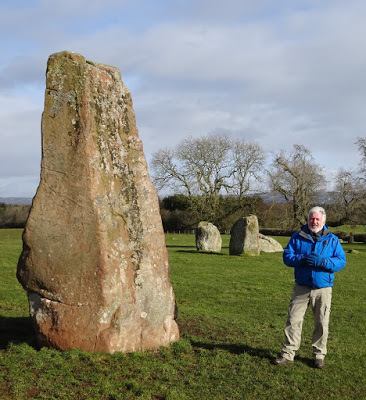
The one and only Long Meg and Her Daughters site in Cumbria, with me included just to prove that I’ve been there. One of our most spectacular Neolithic henges, some of the stones still displaying visible Bronze Age carvings. Mythology tells how they were witches transformed into rock by an angry saint. But pagan groups still celebrate there – the evidence of rituals is widely to be seen, and I made extensive use of it in my Lovecraftian novella of 2002, Long Meg and Her Daughters .

The fathomless, ever-mysterious Loch Morar, in the Western Highlands of Scotland. Over 1,000 feet in depth, it’s the deepest, darkest freshwater body in the British Isles. Needless to say, it’s got its own monster legend, occasional sightings of a huge, unidentified creature having led to the tale of Morag, ‘the Harbinger of death, the giant swimmer in deep green Morar’, an impressive quote I remember from somewhere but can’t quite put my finger on. Anyway, I visited the loch in my horror story of 2015, The House of the Hag. (The picture is by Andrew Hillhouse).

Back to the Lake District with my final selection, not because the Lodore Falls have got any reputation within folklore, but simply because they are so spectacular and because I was yet again able to transplant them to somewhere else in the Lake District for the sake of dramatic license. In my thriller novel of 2014, DEAD MAN WALKING , I really indulged myself, sending Heck on a frantic downhill boat-race with a serial killer. I used the Lodore Falls as the model, relocating them to the high Langdales and renaming them the Cragwood Race. If you feel this isn’t quite as good a pic as the others, that’s because I took it myself. Sorry about that.
(I''ve included photo credits wherever I could find them, though many of these images were simply floating around online. The dramatic picture at the very top comes from Visit Wiltshire. The short stories I reference were first published as follows: Wicken Fen in Terror Tales of East Anglia; We, Who Live in the Wood in Black Static 14; The Incident at North Shore in Terror Tales of Wales; Long Meg and Her Daughters in Children of Cthulhu; The House of the Hag in The 2nd Spectral Book of Horror Stories).
THRILLERS, CHILLERS, SHOCKERS AND KILLERS …
An ongoing series of reviews of dark fiction (crime, thriller, horror and sci-fi) – both old and new – that I have recently read and enjoyed. I’ll endeavour to keep the SPOILERS to a minimum; there will certainly be no given-away denouements or exposed twists-in-the-tail, but by the definition of the word ‘review’, I’m going to be talking about these books in more than just thumbnail detail, extolling the aspects that I particularly enjoyed … so I guess if you’d rather not know anything at all about these pieces of work in advance of reading them yourself, then these particular posts will not be your thing.
 THE GHOSTS & SCHOLARS BOOK OF FOLK HORROR
THE GHOSTS & SCHOLARS BOOK OF FOLK HORROR
ed by Rosemary Pardoe (2018)
An enthralling anthology of macabre supernatural tales, some old and some brand new, but all drawing heavily on folklore, primarily of the British variety, and written in the style and tone of MR James.
Initially, rather than outline all the stories contained here, I’ll let the official Sarob Press blurb do the talking, as it nicely pitches the chills and thrills to come.
Sarob Press is delighted to present a superb collection of Jamesian folk horror tales. Ten have been selected from the pages of editor Rosemary Pardoe’s journals Ghosts & Scholars and The Ghosts & Scholars MR James Newsletter – and seven are newly written especially for this volume. The previously published stories date from as early as 1980 and as recently as 2015.
Here, you’ll find folk horror in a variety of expected and unexpected settings, from ancient burial mounds in Wiltshire and East Anglia to a park in Liverpool, by way of ruins in Ireland and the countryside villages of the Lake District, Dorset, Derbyshire and an unspecified southern county. In the new stories the settings range further afield and include Scotland and Greece. In one case, while the setting is Scotland, the folk horror comes terrifyingly from pre-war Germany.
For the uninitiated, Ghosts & Scholars , which Rosemary Pardoe also edits, is a long-running and very informative magazine, which as well as encouraging scholarly research into MR James (a noted academic as well as a famous writer of ghost stories), includes new fiction written in the Jamesian fashion, articles, reviews and atmospheric artwork.
To my mind, there’s always been a correlation between James’ style of writing and the concept of folk horror, a subgenre that has long been with us, but which has returned to the public’s attention in a big way after the release of recent horror movies like The Ritual , Borderlands , Wake Wood , A Field in England etc.
All that said, I don’t think the two forms are necessarily the same thing.
MR James is widely regarded as the architect of the modern English ghost story, focussing on arcane but mainly fictional mysteries, often setting his tales in the world of antiquarians, where scholarly meddlers arouse the ire of supernatural malcontents by seeking out musty treasures of the past. James died in 1936, so invariably the bulk of his stories occur in the first quarter of the 20th century, a period very familiar to traditionalist ghost story fans, and while many modern authors who’ve been influenced by him have set their fiction in our own age, the gentlemanly tone often remains.
James’ stories frequently take us to countryside locations, Lost Hearts and A View from a Hill for example, or isolated stretches of coast, such as in A Warning to the Curious . Though, in my mind this still doesn’t automatically equate with folk horror; sometimes there’s a more occultic feel to his fiction, such as with Casting the Runes or Number 13, or they may be straight tales of vengeance from beyond, like The Mezzotint and, most famously of all, Oh, Whistle and I’ll Come to You, My Lad .
Ultimately, I suppose it depends how you define folk horror, which is also a bit of a conundrum as opinions on that vary widely. To some, it must reverberate with archaic lore and pre-Christian tradition derived from the land and the turning year, whereas to others it’s all things rural, from standing stones and faerie rings to time-honoured village murder mysteries.
To me, it’s simpler still: folk horror is horror fiction derived from recognisable folklore. There needs be nothing more to it than that.
Even then, I can’t see an unavoidable link between folk horror and Jamesian horror. But that’s me being finickity, because, as I also said, they certainly make for very cosy bedfellows, and it doesn’t surprise me at all that Rosemary Pardoe has been able to raid the innumerable back-copies of Ghosts & Scholars for reprints and at the same time acquire some quality new fiction from modern Jamesian writers to put together this very effective and chilling anthology.
In some stories, as you’d expect, James’ favorite theme of vengeful revenants is to the fore: in Geoffrey Warburton’s The Lane for example, where a simple grassy path appears to lead into another dimension controlled by an evil force that was summoned in times past, or in Chico Kidd’s Figures in a Landscape , where an investigation of some old Irish ruins leads to near-disaster.
At the same time, in others we’re talking full florid folk horror. Philip Thompson’s Beatrix Paints a Landscape (1884) , sees the Lake District’s most famous resident encounter a menacing woodland entity – the polar opposite of the friendly Lakeland creatures she so lovingly wrote about and drew, in Carole Tyrrell’s Lorelei we’re concerned with a village well, the dark goddess dwelling at the bottom of it, and the terrible effect she has on those who hear her call, while in SA Rennnie’s Out of the Water, Out of the Ground , one of several truly excellent stories contained herein, we face the full terror of what it would mean to be at war with the little people.
This of course is a key factor in any work of horror fiction: how highly did it score on the scareometer?
In that regard, The Ghosts & Scholars Book of Folk Horror is pretty satisfactory. As I’ve already mentioned, Out of the Water, Out of the Groun d is especially frightening, but Michael Chislett gets us there too with Meeting Mr Ketchum , in which a hot Lammas Day sees two youngsters casually disturb an East Anglian tumulus, which unfortunately for them, is not undefended, while in CE Ward’s The Spinney , a deceptively simple tale, a motorist stranded in the Derbyshire wilds is inexplicably pursued across a desolate landscape by two increasingly menacing figures.
Possibly the two scariest stories in the entire book, however, are traceable back to my native Northwest: Christopher Harman’s genuinely bone-chilling Sisters Rise , which is centred around an eerie megalith on a lonely Lancashire hillside, and Ramsey Campbell’s short but effective The Burning , set in the depths of urban Liverpool on a cold Bonfire Night. Campbell needs no introduction of horror aficionados, of course, but The Burning is a particularly strong entry because, despite its brevity, it examines the brutal origins of November 5th, the mob mentality of sectarian violence and the victimising of the innocent.
It’s no surprise that we get such an intelligent message from Campbell, but there are other entries in the book that are equally thought-provoking.
Gail-Nina Anderson’s intriguing Variant Versions follows the quest to pin down the truth about an obscure rural ballad, the author balancing the scare factor, which is very subtle, with a genuine academic enquiry into the feminist origins of old country tales. In The Walls , meanwhile, by the ever-reliable Terry Lamsley (whose valuable contributions to the genre sadly seem to have ended years ago now), an attempt to investigate an old lead mine invokes a very different and unusual kind of entity, while in The Valley of Achor , Helen Grant takes us to the Perthshire wilderness, where an ancient pagan site has found a unique and disturbing way to reclaim itself from the new religion imposed on it during the Christian conversion.
There are other stories in the book which I haven’t yet mentioned, but that’s basically because we’re out of room. Put it this way, none disappoint. This is a lively and engaging anthology, filled with often gentle and yet hair-raising tales. What it eschews in terms of excessive blood and guts, it more than makes up for in its intelligence and its undoubted style, and of course, in its air of creeping dread. I feel sure that Dr James would have been delighted to get involved.
And now …
THE GHOSTS & SCHOLARS BOOK OF FOLK HORROR
– the movie.
Just a bit of fun. No film-maker has optioned this book yet (as far as I’m aware), but here are my thoughts on how they should proceed, if they do.
Note: these four stories are NOT the ones I necessarily consider to be the best in the book, but they are the four I perceive as most filmic and most right for a compendium horror.
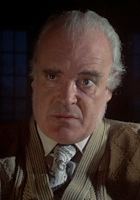 Of course, no such horror film can happen without a central thread, and this is where you guys, the audience, come in. Just accept that four strangers have been thrown together in unusual circumstances which require them to relate spooky stories. It could be that they’re all held in separate cells in a mental hospital, eager to tell their individual tales to the new house-man (a la Asylum) or find themselves in an idyllic country home, where a nervous renovator needs reassurance about his various nightmares (as in Dead of Night) – but basically, it’s up to you.
Of course, no such horror film can happen without a central thread, and this is where you guys, the audience, come in. Just accept that four strangers have been thrown together in unusual circumstances which require them to relate spooky stories. It could be that they’re all held in separate cells in a mental hospital, eager to tell their individual tales to the new house-man (a la Asylum) or find themselves in an idyllic country home, where a nervous renovator needs reassurance about his various nightmares (as in Dead of Night) – but basically, it’s up to you.
Without further messing about, here are the stories and the casts I would choose:
Sisters Rise (by Christopher Harman): A teacher-turned-local historian spends his retirement at the Forest of Bowland Visitor Centre, Lancashire. When a bunch of schoolchildren are terrified on Sisters Rise, where their tree-rubbings reveal faces in the bark, he investigates, but it’s a fearsome task. At the heart of the Rise stands the monstrous sandstone megalith, Tall Maud…
Rodney – Mark AddyAnn Allan – Emily BeechamMarjorie – Miranda Richardson
The Burning (by Ramsey Campbell): Recently rendered unemployed, Liverpudlian lad Blake attends the Guy Fawkes celebrations downtown in a sour and angry state. He yearns to punish those who, to his mind at least, are the cause of his redundancy. But he isn’t the only one out that night looking to scapegoat someone else for their troubles …
Blake – Matt Ryan
The Discontent of Familiars (by John Llewellyn Probert): A middle-aged academic inherits big money and uses it to buy a rural cottage, once allegedly the home of a witch whose familiar was a raven. He soon becomes convinced that an evil presence remains, and is increasingly afraid of the woods across the river, which are filled with ravens …
John Wilson – Tobias MenziesDoctor – Andy Nyman
Out of the Water, Out of the Ground (by SA Rennie): An art-school guy is summoned to an isolated castle in the Cairngorms, where a friend is living in a state of mortal if irrational terror, convinced that recent blasphemies by his late father, the death of his brother in an overseas war and the rape of the land by industry and technology have aroused the ire of the local dwarves …
James – James McArdleHis friend – Will Poulter
Published on January 09, 2019 23:52



